
Special Thanks to.
Group Programmes Unit, United Nations Department of Global Communications





CSO Representative at the United Nations Department of Global Communications Web: www.hopetofuture.org I Address: 4F, Bongeunsa ro 176, Gangnam gu, Seoul, Korea Tel: +82 2 6952 1616 I Email: webmaster@hopetofuture.org



Program Information p4
Program Introduction
Program Theme
Program Curriculum
Participant Information p12 Student List
Staff List p14
Speaker List p15
Team Presentation on the UN and the SDGs p22 Team
Economic and Social Development p23 Team
Education P35 Team
Environment and Climate Change P49 Team
Team
Gallery
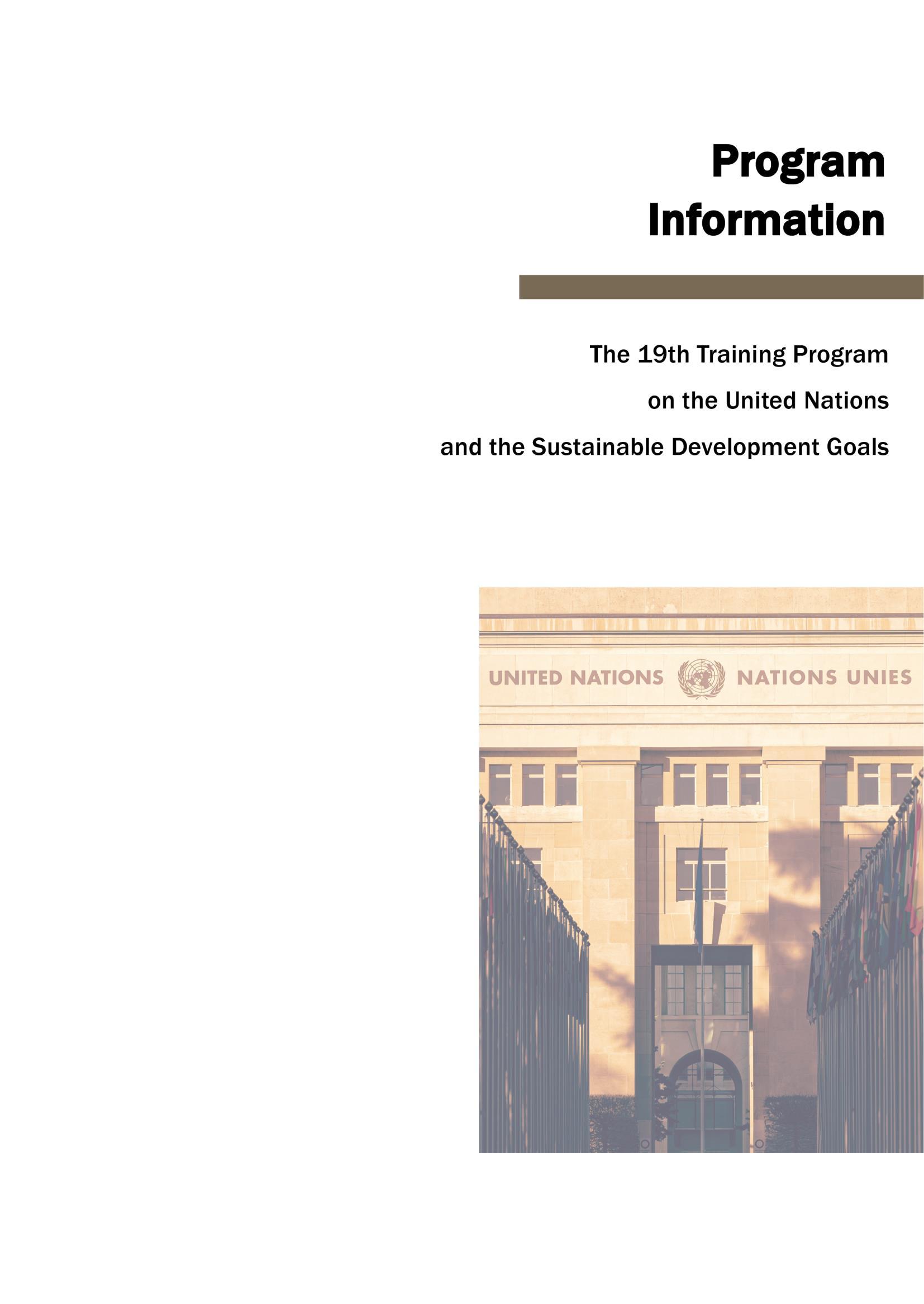


‘Training Program on the United Nations and the SDGs’ is a pedagogical training program customized and developed for Korean youth to provide intensive training on the works of the UN and the Sustainable Development Goals. Hosted byHope to theFuture Association, UN DGC associated NGO, the program mainly focuses on the global matters dealt by the UN organizations and the member states. Having UNhighofficers andexperts withdirect experience intheinternational organization asthemain speakers, the program aims to promote a better understanding of global issues and develop multi perspective on the UN. The training also provides direct networking opportunities with UN officials, NGO representatives, and UN ambassadors.
Particularly, the 19th training program provides an opportunity to examine how well the United Nations carries out its stated aims to maintain international peace and security, protect human rights, deliver humanitarian aid, promote sustainable development, and uphold international law. In addition, students learn about not only the United Nations but also South Korea’s relationship with the United Nations as they build professional knowledge on pending issues of the international society. This year’s program had invited UN speakers from around the globe including Korea, the US, Japan, Mexico, South Africa, Brazil, and so on. The program was virtually organized via an online platform due to the worldwide COVID 19 circumstances.
Title
Date
Venue
Language
Participant Information
The 19th Training Program on the United Nations and the SDGs
2 August (Tue.) ~ 6 August (Sat.) 2022 (KST)
Online platform ZOOM
English
Keynote Speech by UN high officials
UN Staff Lecture (UNHQ New York and Geneva)
Special Discussion with the UN Ambassadors
UN Career Development Session (Young Leaders)
Youth Presentations on the UN Agendas
Youth Declaration on the SDGs


Debate and discussions (pros and cons) on the UN Agendas
Student participants: 24 people
Youth staff: 3 people
“On September 25th 2015, the UN Member States adopted a set of goals to end poverty, protect the planet and ensure prosperity for all as part of a new sustainable development agenda. Each goal has specific targets to be achieved over the next 15 years.”

The SDGs, build on the success of the Millennium Development Goals (MDGs) and aim to go further to end all forms of poverty. The new Goals are unique in that they call for action by all countries, poor, rich and middle income to promote prosperity while protecting the planet. They recognize that ending poverty must go hand in hand with strategies that buildeconomic growth and addresses arange ofsocialneedsincludingeducation, health, social protection, and job opportunities, while tackling climate change and environmental protection. While the SDGs are not legally binding, governments are expected to take ownership and establish national frameworks for the achievement of the 17 Goals. Countries have the primary responsibility for follow up and review of the progress made in implementing the Goals, which will require quality, accessible and timely data collection.

End poverty in all its forms everywhere.
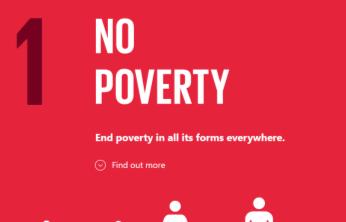
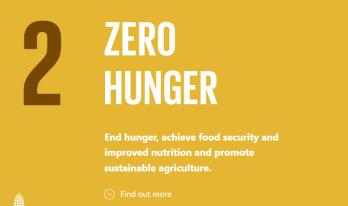
End hunger, achieve food security and improved nutrition and promote sustainable agriculture.

Ensure healthy lives and promote well being for all at all ages.
Ensure inclusive and equitable quality education and promote lifelong learning opportunities for all.


Promote sustained, inclusive and sustainable economic growth, full and productive employment and decent work for all.

Make cities and human settlements inclusive, safe, resilient, and sustainable.

Take urgent action to combat climate change and its impacts by regulating emissions and promoting developments in renewable energy

Promote peaceful and inclusive societies for sustainable development, provide access to justice for all and build effective, accountable and inclusive institutions at all levels

Strengthen the means of implementation and revitalize the global partnership for sustainable development.

United Nations and SDGs Overview

Felipe Queipo
Communications Officer, United Nations Civil Society Unit
World Expo and Sustainability Enna Park
(Former) Ambassador of the Republic of Korea to the UK
Public Diplomacy to Back up Foreign Policy Goals: Its History and Future
Kadir Jun Ayhan
AssistantProfessor, Graduate Schoolof International Studies, Ewha Womans University
Infrastructure of Civic Opportunity
Jae Yeon Kim
Assistant Professor, KDI School of Public Policy and Management
Empowering People for Human Rights
Jessica Dewhurst
CEO & Founder of The Justice Desk
Youth Career Development Hyunjo Koh
(Former) Legislative Secretary at the National Assembly
United Nations and Climate Action
Esra Sergi Bertani Communications and Mobilisation Officer at Climate Action Team, Executive Office of the Secretary General, United Nations
Rethinking Urban Development for the XXI Century
Ana Sabrina Martínez Feria
Urban Development Specialist at United Nations Habitat (UN Habitat)
Youngjin Lee Training and Education Officer, World Federation of United Nations Associations (WFUNA)
Climate Mobility and Climate induced Migration
Carine Valarché
Intern at Results and Data Management Team, Green Climate Fund (GCF)
International Model United Nations Monique Nikolov (Former) Secretary General of Yale International Model United Nations
Public Diplomacy and SDGs Rachel Naddeo Tohoku University
Day 3 4 August (Thur.)
SDG 1: No Poverty
Donald Lee
UN Briefing
(Former) Chief of the Social Perspective on Development Branch, United Nations Department of Economic and Social Affairs (UNDESA)
UN Briefing
Sustainable Cities: Leave No One and No Place Behind Luis Ángel Flores
Urban Development Specialist and Urbanist Consultant, UN Habitat
Global Citizenship and SDGs
UN Briefing
Utak Chung
(Former) Director at UNESCO APCEIU
Climate Resilience and Development Jack Bathe
Consultant at Global Green Growth Institute (GGGI)
Global Mindset for the Youth Chang Beom Cho
UN Briefing
Vice President of the United Nations Associations Republic of Korea, (Former) Ambassador of Republic of Korea to Australia, Czech Republic and Republic of Austria
Day 4 5 August (Fri.)
SDG 16: Peace, Justice and Strong Institutions
Takashi Mashiko
Programme Officer at United Nations Office of Disarmament Affairs (UNODA)

Global Disarmament and My Working Career
Ji Yeon Rho
Associate Expert, United Nations Office for Disarmament Affairs (UNODA)

Youth Empowerment and the United Nations Jung Min Shin Judicial Law Clerk at Massachusetts Appeals Court, (Former) Third Committee Team Researcher at Permanent Mission of the Republic of Korea to the United Nations
Final Presentation on the Sustainable Development Goals Team Presentation and Speech
Closing Closing Address: Voice for Change

Lycée Français de Séoul














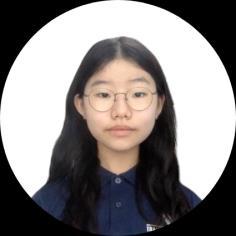

















Felipe Queipo Communications Officer, United Nations Civil Society Unit



Ambassador Enna Park (Former) Ambassador of the Republic of Korea to the UK

Kadir Jun Ayhan (Dr.)
Assistant Professor, Graduate School of International Studies, Ewha Womans University


Assistant Professor, KDI School of Public Policy and Management
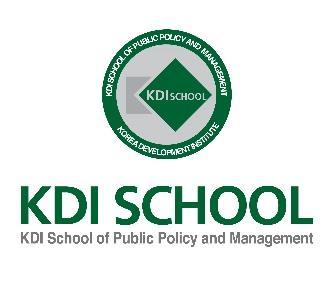





(Former) Legislative Secretary at the National Assembly
Communications and Mobilisation Officer at Climate Action Team, Executive Office of the Secretary General, United Nations



Ana Sabrina Martínez Feria Urban Development Specialist at UN Habitat


Training and Education Officer, World Federation of United Nations Associations (WFUNA)


Intern at Results and Data Management Team, Green Climate Fund (GCF)


Monique Nikolov (Former) Secretary General of Yale International Model United Nations


International Cultural Studies Master' student at Tohoku University


Donald Lee (Dr.) (Former) Chief of the Social Perspective on Development Branch, United Nations Department of Economic and Social Affairs (UNDESA)

Sustainable Cities: Leave No One and No Place Behind Luis Ángel Flores


Urban Development Specialist and Urbanist Consultant, UN Habitat



Utak Chung (Ph.D) (Former) Director at UNESCO Asia Pacific Centre of Education for International Understanding (APCEIU)


Jack Bathe
Consultant at Global Green Growth Institute (GGGI)



Takashi Mashiko Programme Officer at United Nations Office of Disarmament Affairs (UNODA)


Ji Yeon Rho Associate Expert, United Nations Office for Disarmament Affairs (UNODA)




Tang Sheng Yao (Ph.D) FAO Representative and Head of FAO PLO in ROK





References: https://www.un.org/en/civilsociety https://un rok.org/ko/ https://www.fao.org/ www.un.org/disarmament/ https://www.greenclimate.fund/ https://ymun.org/ https://unhabitat.org/ https://www.unesco.org/en www.ewha.ac.kr/ewhaen/index.do https://wfuna.org/ https://www.un.org/en/desa www.un.org/en https://unhabitat.org/


The Hill School, Minjung Ki CMIS Canada, Dayoung Yu Branksome Hall Asia, Dayoung Lee Daewon International Middle School, HyungJoon Cho


The Russo Ukrainian war has been elongated for months, leading to tremendous economic losses and casualties day by day. To understand more about the current situation of the war, I researched the timeline of the Russo Ukrainian war. Also, I asked discussion questions to the audience about the SDGs that are deeply correlated with this war.

To begin, theRusso Ukrainian War's timeline showsthe development of tensions between the two countries.
To understand the war between Russia and Ukraine, we have to look at the history between the two nations. The Russo Ukrainian war originated due to the political conflicts between Ukraine and Russia long before the 21st century. The Crimea peninsula is known for its great geological characteristics which are advantageous for economic and military usage. It happens to be conveniently adjacent to the Mediterranean Sea. Since the 19th century, there has been dispute over whether Russia or Ukraine controls the Crimea peninsula. In addition, during the 20th century, until the demolition of the USSR, Ukraine was officially known as the Ukrainian Soviet Socialist Republic and was part of the Soviet Union.
From 1932 to 1933, the Great Ukrainian famine occurred, leading to the death of 10 million civilians. The famine was caused by the Collectivization policy implemented by the Soviet Union under the control of Joseph Stalin. After this tragic incident, the second world war broke out, causing over five million casualties in Ukraine. Luckily in 1991, as the era of the cold war came to an end, several nations, including Ukraine, gained freedom from the Soviet Union and became independent countries. In 1994, three years after its independence, several nations signed the Budapest Memorandum to admit Ukraine's sovereignty and territorial rights. However, as the 21st century started, the Orange revolution occurred. The revolution happened as the corrupted government controlled the 2004 presidential election through several political
frauds and media manipulation. Countless Ukrainian civilians were running to the streets and protesting against the election result, which led to Viktor Yushchenko, a pro European politician, becoming the president.
A few years later, in 2008, Ukraine applied to the NATO Membership Action Plan (MAP) to seek a solution to avoid Russia's threat and ensure their civilians' safety. Russia said that NATO was breaking its promise to the past Soviet Union. In 1990, after the famous Berlin wall fell, the Soviet Union and NATO concluded that there would be no territorial expansion to East Europe. However, as the Warsaw pact got dissolved in 1991, most countries in the Pact and countries that were part of the USSR began to apply to NATO, which caused it to expand to the Eastern region of Europe.
However, as the presidential term of Yushchenko ended, the next president, Viktor Yanukovych, a pro Russian politician, tried to maintain a good relationship with Russia instead of the European Union and Western European nations. As a result, through a fierce protest, Yanukovych got impeached. In 2014, Russia caused the Crimean crisis and gained authority over the peninsula and the Black Sea Fleet they possessed by claiming they were invading for the safety of the Russians inhabiting the peninsula. As Russia annexed the Crimea peninsula, several pro Russians were inspired to start a war in Donbas, located in eastern Ukraine, to liberate themselves from Ukraine and maintain good relations with Russia again. This war caused a civil war in Ukraine and led to more than 14,000 casualties as the pro Russians were heavily armored with weapons provided by Russia in private. In 2022, Ukraine tried to apply to NATO, and Russia launched a full scale invasion of Ukraine, which is currently on going.
Second, I asked the audience about the SDGs and the crisis happening in Ukraine.
1. Which SDG do you believe is the most important to solve the war in Ukraine?

A: This crisis should be solved through SDG 9, as its primary goal is aiming to ensure safe infrastructure. Hence, we can reconstruct the destroyed infrastructure of Ukraine through global collaboration and let individuals participate in civic organizations.
2. Which SDG is the most affected by this war?
A: From a global perspective, SDG 8 would be the most affected as the economy has been plummeting due to the prolongation of the war. On the other hand, in the case of Ukraine, SDG 4 is the most affected by this war as most education infrastructures were demolished by war, leading to a high learning poverty rate across the nation. This problem will not only affect the country's current situation but will also significantly impact the future.
The initial round of sanctions was extremely mild. The sanctions included restrictions on travel, asset freezes, and the proscribing of businessdealings with certain individuals and enterprises, including entities based inCrimea andSevastopol. However, after tensions roseintheUkrainianwar withmonthsof ongoing battles and destruction, sanctions were tightened considerably in many areas. The export and import of arms was forbidden, as was the export of dual use goods for military use. Exports of certain types of goods related to oil exploration and production were also banned.
The Most significant sanction was the curtailing of long term financing of Russian companies that had no direct involvement with the fighting. We call it the famous “Swift Ban”.

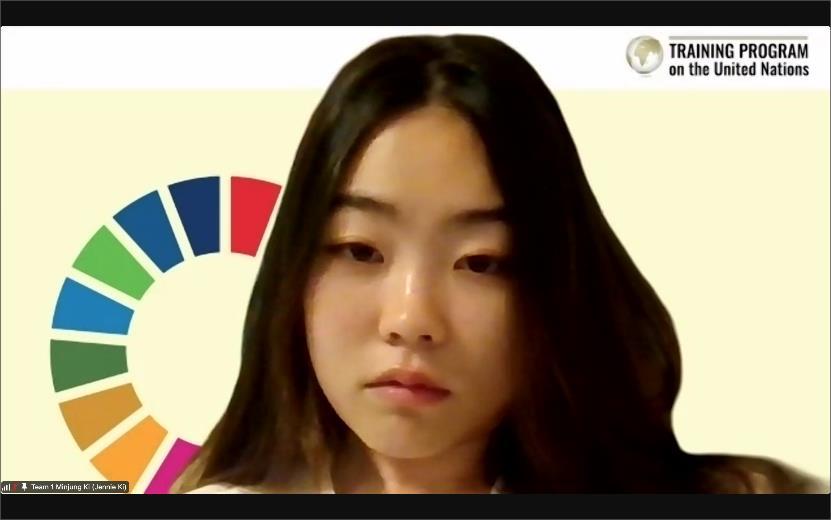
SWIFT the Society for Worldwide Interbank Financial Telecommunication is a member owned cooperative. As the Gmail of global banking, SWIFT is used by thousands of financial institutions in more than 200 countries, including Russia, and provides a secure messaging system to facilitate cross border money transfers. SWIFT directs trillions of dollars in transactions, including orders and confirmations for payments, trades, and currency exchanges.
In March, the US and the EU cut off seven Russian banks from SWIFT such as VTB and Bank Rossiya. On June 3, the EU added three more banks including Sberbank, which has twice as many assets as any other bank in Russia. Sberbank’s international operations were already heavily restricted after the U.S. and the U.K. froze its local assets and ordered their banks to stop working with Sberbank.
Economic sanctions affected Russia from the first day of the invasion, with the stock market falling by up to 39%. The Russian ruble fell to record lows, as Russians rushed to exchange currency. Stock exchanges in Moscow and St. Petersburg were suspended until at least 18 March, making it the longest closure in Russia's history.On 26 February, S&P Global Ratings downgraded the Russian government credit rating to "junk", causing funds that require investment grade bonds to dump Russian debt, making further borrowing very difficult for Russia.
Russia’s economy and society are being hit by so many different sanctions, and by the war itself, that it’s difficult to disentangle their effects. Adding to the challenge, Russian banks suspended monthly reporting of financial information when the war began. According to a March 31 report by independent Russian news agency Interfax, the central bank estimated that Russian banks maylose as much as5.8trillion rubles ($93.8 billion) in 2022 due to sanctions and from participating in measures to support the economy.
Why the reluctance to cut off all Russian banks from SWIFT?
Germany, which relies on Russia for more than half its gas supplies and more than a third of its oil, in particular resisted adding Sberbank to the list. Sberbank is a major conduit for EU Russia trade, and if the Russians couldn’t get paid for their fuel, they could be counted on to stop providing it.
Is there an alternative to swift?
No alternative to Swift. China has a payment system known as the Cross Border Interbank Payment System, or CIPS, but it’s mainly a settlement system for renminbi transactions that also offers some communication functions. Most banks that use CIPS still communicate via SWIFT.

However, Russian news media and a several number of experts perceive this as the stablization of the Russian economy and rather, they predict Russia is recovering in a rapid speed. After the Central Bank of Russia announced interventions, Russia tried to stabilise the market. On the 28th of February, it raised interest rates to 20% and banned foreigners from selling local securities.
Higher prices for oil and gas exportshave sofar diminished the effect of sanctionson theRussian economy and provided the Kremlin with strong revenues that it can direct towards supporting the economy and the armed forces.
Ukraine experienced tremendous amounts of tangible damage from the war with Russia. The nation’s urban centers were damaged, mainly because Russian troops attacked Ukraine’s central urban areas as a strategy. Other parts of the country, such as maritime, rail, and transit have been severely disrupted. Vital economic and social service infrastructure such as power generation, digital infrastructure, bridges, and ports have been rendered unusable.
Overall, the war did $108.4 million worth of damage to the infrastructure in Ukraine. The inconvenience caused by this situation on top of the uncertainty and instability of life that comes with war led 12 million Ukrainians to become refugees. A similar number of people, especially the elderly and infirm, were in need of humanitarian assistance. Apart from the people who fled their country, 3.5 million people turned homeless due to the war. The war is likely to have a negative impact, especially on children: it would increase malnutrition, reduce years, of schooling, and worsening labor market outcomes. The lack of people active in the country and possible harmful effects on children may make its activity and recovery of the economy very challenging.
The Russianinvasionledto direct lossesof vital infrastructure: an estimated$36.8billionworth ofdamage was done to housing, $31.3 billion to transportation infrastructure, and $8 billion to industry and business services. Moreover, 104 thousand cars, 43 thousand agricultural machines, 700 kindergartens, and 600 cultural facilities were damaged or destroyed over the course of the war. According to these pieces of data, it is evident that the infrastructure and resources crucial for society to function were severely harmed. This will leave immense burdens on Ukraine for recovery in the future.
Ukraine is called the ‘Breadbasket of Europe’ for a reason; it is one of the countries in Europe with the most fertile farmland. Because of this, it is one of the top grain exporters in the world. Similar to how they
attacked Ukrainian urban centers, Russia deliberately destroyed Ukrainian croplands to limit crop production. For example, there were attacks on Agromol Dairy Farm and evidence of artillery attacks on agricultural fields in Ukraine. As a response, the UnitedNations tookresponsive measures toincrease food production. Its actions included supporting local farms and working with governments.
Ukraine also experienced damages to its trade. As mentioned above, Ukraine is one of the largest grain exporters. However, the war caused wheat and other crops tobestuckinthecountry, unabletobe exported. Even outside of crops, goods trade in general has come to a grinding halt. The reason for this phenomenon is the damaged transit routes that impeded shipment by land and the loss of access to the Black Sea that cut off all seaborne trade which accounts for half of Ukraine’s exports. In order to solve this problem, the UN initiated the Black Sea Agreement which opened shipment routes in the Black Sea. This agreement was signed by Russia and Ukraine and has taken effect, moderating the food crisis caused by Ukraine's inability to export crops to some degree.

The war was undeniably a threat to the Ukrainian economy, as it fell by approximately 40% as a result of the Russian invasion in February. Ukraine imposed emergency financial measures as a response including capital controls and banking sector restrictions. It also announced tax deferrals, while fully meeting domestic and external debt obligations. These measures prevented the country from facing financial collapse.
The estimates of Ukraine's economy in the future differ depending on the institution, but most predict a recession. Multiple institutions including the National Bank of Ukraine, the European Bank for Reconstruction and Development, and the IMF estimated predicted Ukraine's economy to shrink by ⅓ in 2022, and the World Bank estimated its decrease by as much as 45%.
However, the economy is expected to grow by 5% to 6% between 2023 and 2024. While the war was a major cause of inflation on a global level, Ukraine’s interest rate stayed the same, remaining at 25%.
The war had devastating effects on the country, but Ukraine recieved military, humanitarian, and financial aid and support from multiple countries globally. 20 countries gave assistance packages to Ukraine, and 47 nations joined the Ukraine Defence Contract Group. Moreover, $40 billion in aid was given from the US to Ukraine and other countries affected, including $19 billion of immediate military support and $16 billion in economic support, by May 2022. The USA and EU institutions provided the most support to Ukraine.

President Volodymyr Zelensky of Ukraine played a major role in bringing aid to the country. He utilized his background in entertainment and savviness in media to further drive support to Ukraine and became the face of the resistance in his country. He continued to deliver video messages to rally support, warning about Russia to governments around the globe while staying in Kyiv. From Zelensky’s efforts, it can be said that his actions and leadership could help Ukraine maintain its position by encouraging support from other nations.
Considering the factors above, Ukraine faced much harm in many facets including economic and humanitarian sectors. However, the country has the potential for a slow recovery in the future.
 Dayoung Yu (CMIS Canada)
Dayoung Yu (CMIS Canada)

The recent conflict between Russia and Ukraine has spiraled into a full scale war, bringing damage to the global society as a whole. Some think the consequences of the war will also stay within the boundaries of the two nations, however, the economic implications of the war is global. These economic issues include fuel and food shortages around the world and stagflation.
Thefuelcrisiswasinevitable,sinceRussiaandUkrainehavebeenmajorfuel exporters intheglobal market. Russia accounts for 10 percent of the world’s oil production, and Europe has been heavily dependent on Russian fuel. Sanctions against Russia cut off most of Europe’s oil import from Russia and caused a fuel crisis. When the Russian fuel supply decreased, it became difficult for many countries, not only in Europe, but around the world, to maintain their production levels. This decreased supply increased the oil price up to 100 USD per barrel in 2022, compared to 62 USD per barrel in 2021. Such fuel shortages around the world escalated another global issue: food crisis.
Fuel needed for the transportation of grain has decreased, and starvation broke out in many parts of the world. Ukraine is a major grain exporter, however, due to Russian naval blockade, the country hasn’t been able to properly trade its resources. This threatened the world’s food supply, increasing food prices, which then increased the consumer price index in most countries. The United Nations reached out to mitigate this serious issue by brokering a deal between Russia and Ukraine regarding the Black Sea trade routes. The Black Sea is where the harbors Ukrainian grain is exported from is located, and Russia has been blocking this area since the beginning of the war. They came to an agreement that allowed Ukraine to resume its grain exports from the Black Sea ports and Russia to resume its export of fertilizers. Although such measures were taken to mitigate the food crisis, the global food supply hasn’t recovered completely. This led to an ongoing inflation of food prices, which is threatening individuals the most.
Inflation without economic growth is called stagflation, and this is the case for most countries since the war broke out. Food is vital for a human’s survival, and is something that concerns every single consumer. An example of this stagflation is Turkiye, a country located in between Asia and Europe, has hit a record high annual inflation rate of 78.62 percent in June, 2022. This has been hurting Turkiye’s people’s lives, leading to protests around the country. People in Turkiye that are burdened with unreasonably high food prices are yet another victim of the Russia Ukraine war.
Our generation have been taught that war should be avoided at all costs, and this current war is the direct demonstration of a war’s consequences. Either directly or indirectly, war deprives people of their lives, happiness, ortheir freedom. Bearingwitnesstothe global damage thiswar iscausing, it is aglobal citizen’s duty to recognize the conflict not as a secluded, but as a global conflict.






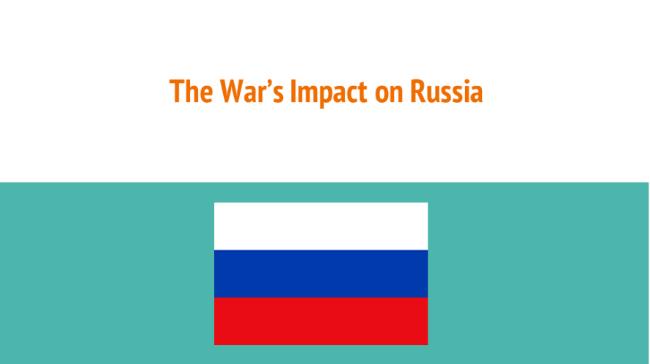










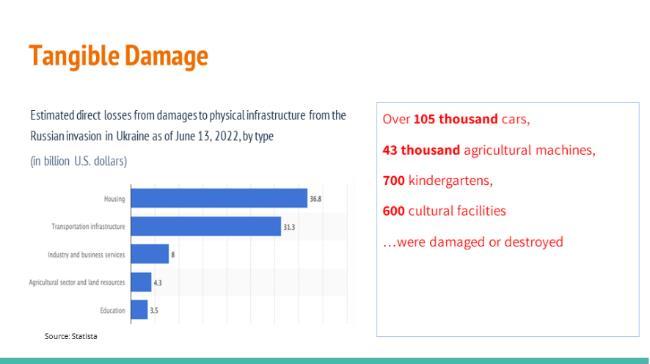




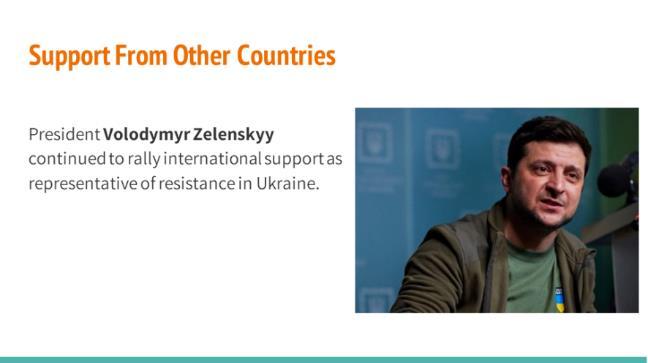






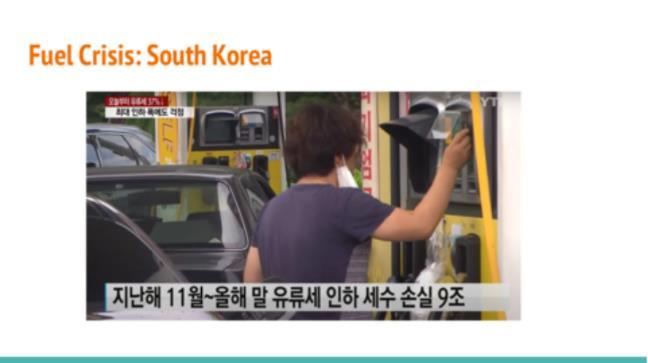











CMIS Canada, Seoyun Kwon
Hillside School, Jiho Park
Daecheong Middle School, Dayeon Lee Holy Infant Academy, Jun Hyun Lee
Korean International School of Bangkok, Chaemin Lee

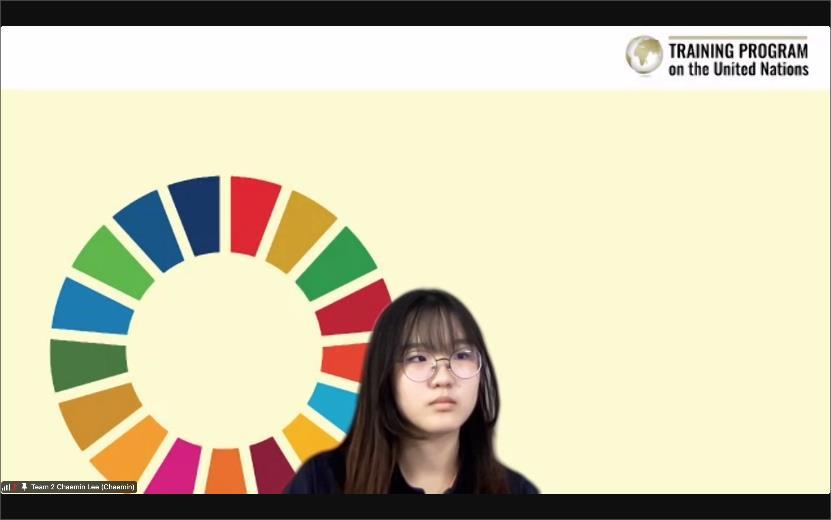
 Chaemin Lee (Korean International School of Bangkok)
Chaemin Lee (Korean International School of Bangkok)
Education is important, as it develops problem solving skills. The educational system teaches us how to obtain and develop critical and independent decisions; thus, when children become adults, they would be able to make profitable decisions for themselves. However, there are people, cities, and even countries, who can’t get enough education, then they need it. Therefore, in this report, I will look through what education is with the importance, and the solutions to educational inequality.
First, I will be looking at why education is important. Education is important as it helps develop critical thinking, which is vital in teaching a person how to use logic when making decisions and interacting with people. Education helps individuals meet basic job qualifications and make them more likely to secure better jobs. Moreover, education can also improve the economy. It will help countries grow economically since it is about getting knowledge and being able to apply it wisely to our lives, and at the same time improving other people’s lives. Furthermore, education is also the key to escape poverty, which is SDG goal no.1. It will lead the world to an equitable, prosperous, and healthy society, and lastly, for our future generations.
Next, what educational inequality is.
Educational inequality is about the disparity of access to educational resources between social groups. These resources include school funding, experienced and qualified educators, books, technologies, and school facilities such as sports and recreation. Educational inequality can also be defined as the inequality between students in access to quality education, due to the disruption of schools caused by the COVID 19 pandemic.

To take a look at the example and factors that educational inequality has brought, there are government policies, choice of school, family wealth, residential location, parenting style, choices of schools, and lastly, implicit bias toward a student’s race.
Educational inequalitylessensthe educational, academic success, or performance, of the population, by the unequal distribution of educational opportunity, financial and educational resources, qualified teachers, or digital assets.
A good education is not just only about academic and professional performance and opportunities, but it also takes an important part in moving forward to become more civilized in human society.

 Jiho Park (Hillside School)
Jiho Park (Hillside School)
Gender inequality is a social phenomenon in which men and women are not treated equally. Differences in genetics, psychology, or societal cultural standards may be the cause of the treatment. While some of these divisions have empirical support, others seem to be social constructs. Or, to put it another way, it's sex or gender discrimination that favors one sex or gender over the other on a regular basis. Gender based discrimination infringes on the fundamental human right to gender equality.

The causes of gender inequality are foundin the distinctions that exist between men and women in society, including those based on biology, religion, and economics. It stems from the biological distinctions between the sexes, such as the capacity for breastfeeding, that led to the sexual division of labor. Economically speaking, women's roles are regarded less, and they frequently have restricted mobility and are confined to the home. Women frequently endure many forms of discrimination, such as social, and domestic discrimination, institutionalized, and community which negatively impact their well being and maintain their inferior status to men in the patriarchal system.
When discussing gender inequality in education, society first considers the barriers to schooling for girls and young women. Three quarters of the children at risk of never going to school are girls. Yet disparities still exist in other dimensions of education, sometimes to the detriment of boys. To reduce them, IIEP UNESCO (UNESCO International Institute for Educational Planning), favors an intersectional approach, which looks at gender through all other forms of discrimination and social exclusion. According to Unesco data, the number of girls enrolled in primary and secondary school has increased by 180 million over this period, including 69 million in sub Saharan Africa. Yet girls and young women still face the most severe forms of exclusion, which are the result of several cumulative factors. Among them are socio economic status, place of residence, ethnicity, religion, and living with a disability. Also, according to UNESCO, an average of 130 million girls between the age of 6 and 17 are out of school and 15 million girls of primary school agewillneverenteraclassroom. Globally, thereisasignificant genderdisparityinschooling, which
may be caused by a number of intersecting identities. The most frequently cited causes of this gender gap include deprivation, isolation due to geography, violence, physical or mental impairments, a lack of infrastructure, or membership in a marginalized ethnolinguistic group. According to the research, the Middle East, South Asia, and Africa have the greatest rates of gender inequality in schooling. As school proceeds, we also observe an increase in the percentage of female students who miss school. The percentages of young girls and women who are not in school are shown on the maps below.
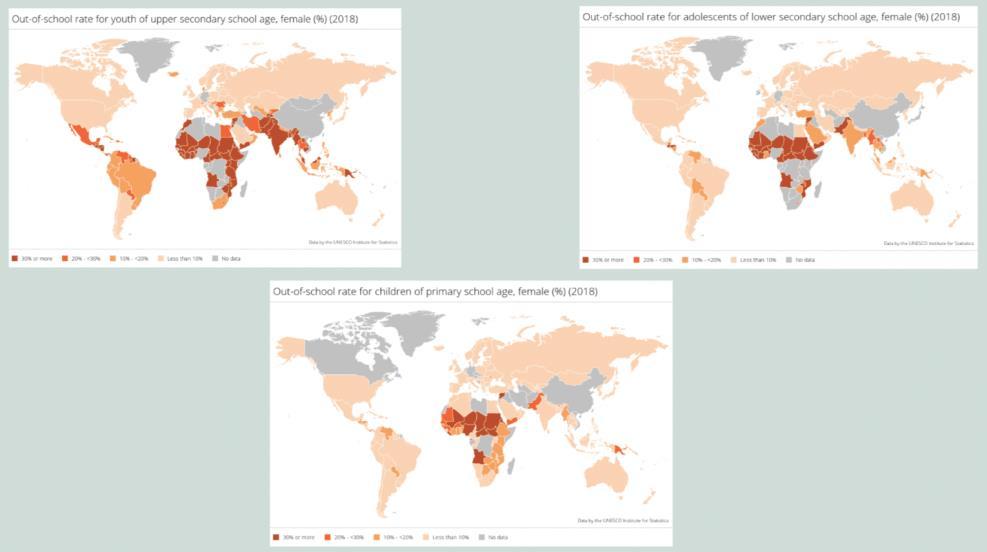


South Sudan is where there is the greatest gender disparity in schooling. It's one of the hardest places in the world for girls to receive an education, Sudan also has inegalitarian views towards women, and has some of the highest rates of forced marriage. According to an index released last year, South Sudan is the country where it is hardest for girls to get an education because nearly three quarters of them don't even go to primary school. As of February 2021, women had28.5% ofthe seats in South Sudan's parliament. To attain gender equality, however, more needs to be done in South Sudan. In addition, in this country, 51.5 percent of women between the ages of 20 and 24 who were married or in a union before turning 18 are prevented from pursuing an education.
First, segregating male and female students should be avoided. Not only does gender segregation prevent male and female students from learning to interact socially, but it also prevents non binary kids from feeling accepted and seen. Fostering the collaboration of all genders is another goal. Lastly, refrain from using gendered language and prejudices for instance, instead of using fireman, and policeman we can use firefighter, and police officer.

Socioeconomic factors are one ofthemost commonfactors that cause educational inequality. Studiesshow that students from lower socioeconomic backgrounds tend to have a higher chance of problematic acts during their schooling.
Students from low SES; higher possibility to have behaviour problems during their academic period
Low SES students; 5 years behind when it comes to Literacy skills than high SES students.
Low SES students had the highest dropout rate (11.6%) among the age of 16 24 yr olds.
Success rate of low income background students in specific fields; much lower than those in underrepresented backgrounds.
Low SES students are less likely to obtain a bachelor’s degree by the age of 24
These problematic behaviours start from their living environment. Studies show that low socioeconomic households have a higher chance of child neglect and abuse. Also these students cannot gain enough care and attention from their parents during their teens, which leads to inappropriate behaviours and actions. Often underestimated in their community because of their backgrounds, it is the truth that many of those who come from these households are unable to escape poverty.
Another study suggests that because of the lack of resources to provide a safe studying environment for studentsinschoolsofthelowsocioeconomiccommunities, studentsare unabletoreceive qualityeducation.
Psychological stress might also be a factor as well. Low income students tend to receive a higher rate of stress intheir household dueto childneglect and abuse. Also it is because many studentsfrom low income families cannot afford to go to hospitals when they are sick


Education inequality by socioeconomic usually happens because of economic disparities between countries. To define this as the education inequality between the developed countries, MEDC, and developing countries, which is LEDC. The reasons for the educational inequality between LEDCs and MEDCs are Poverty in the country, corruption of the government, lack of security, insufficient facilities, child labor, and lack of democratization.
Due to the lack of enactment of the country itself, the country cannot provide adequate education and safe educational facilities to its citizens, which leads to an overall lack of education in LEDC countries. Also, in the case of many LEDC countries, there is a high probability of government corruption or waste of enactment because a proper government system is not established.

Corrupt governments spend money on politicians and civil servants rather than spending their taxes on citizens, thus hindering the construction of educational facilities or improving the quality of education. Furthermore, the security rate is very low due to the characteristics of LEDC countries. They may lack the economic power to enhance national security, or theymay be more interested innational development than the safety of their own people. These characteristics have a huge negative impact on education. The reason is that there is always a fear in parents that sending their children to school will cause bad things to happen to their children. This will be a barrier that prevents parents from sending their children to school.
Also, as mentioned before, most of their educational facilities are not enough due to the lack of economic power at the national level, and the corruption of the government. And citizens of poor countries often send their children to the workplace rather than the school to solve the immediate meal rather than the long term value. As a result, they cannot afford to study because they work for children in developing countries.
Finally, the lack of democratization also contributes to educational inequality. Most LECD countries are not democracies. Non democratic countries, i.e. countries with dictatorships, are politically reluctant to educate their people. The reason isthat if the people ofyour country are well educated and develop a sense of freedom and the desire to defend their rights, it becomes very difficult to control them. Dictators want people who are easy to control, and those people don't need a high quality education. These political reasons also contribute to the educational inequality of LEDC.

Because of these factors, LECD countriesmay have lower quality or no access to education than MECD countries. To be more specific about the impact of these factors, the educational inequality between MEDC and LEDC is further exacerbated by the various causes of educational inequality mentioned earlier. Worse, LEDC countries will be forever left behind if they fall into this educational inequality. Education and information are the most basic stages of development and the most powerful weapon in the fight against poverty. However, if this information and education gap widens for a number of unavoidable reasons, MEDC and LEDC may never be on equal footing. This means that the citizens of LEDC will forever be in poverty and will be deprived of opportunities to climb the social ladder. At the national level, LEDCs will be left behind in terms of national development as they will not be able to nurture and utilize human resources.


To list some countries where these horrific educational inequalities are more particularly prevalent. Sub Saharan Africa is home to more than half of the world's out of school students. Further, there are only 1.5 million schools with about 250 million students enrolled in India. According to a survey, 37% of students in rural and 17% in urban areas doesn't study at all. Just to add, Slovakia and New Zealand, Australia is ranked as the most unequal in the world on a combined ranking of education inequality across preschool, primary, and secondary schooling, which means that we and all other organizations need to focus on these nations.
Covid 19 caused education inequality. Then, the closure of schools due to the Corona crisis negatively affected children. This is because, in a pandemic situation, not all children have the opportunities, tools, and accessibilities that are necessary for studying. For millions of students, school closures will result in a sudden and permanent suspension, not a temporary suspension of schoolwork.
There are also some examples of countries that were affected by Covid 19. First, in the world in 2020, governments around the globe shut down schools. It affected over 90% of school children worldwide. On March 18, 2020, in Johannesburg, South Africa, Students, schools, colleges, and universities experienced

a complete shutdown. According to the United Nations Educational, Scientific and Cultural Organisation (UNESCO), over 800 million learners from around the world have been affected. 1 in 5 learners could not attend school, and 1 in 4 could not attend higher education classes.

Third, recently, In Western Asia and North Africa, the ongoing armed conflict has caused an increase in the number of children who are not attending school. Sub Saharan Africa made the greatest progress in primary school enrolment among all developing regions, but large disparities remain. This is because the impact of COVID 19 has not been resolved yet. These countries have gradually collapsed because the economy has not developed due to the shut down of shopping malls and big malls that people normally use on a daily basis.
Then, in Indonesia, due to COVID 19, many schools were closed for almost two years because of the wealth gap. Whilerichpeople were abletolet their children take online classes, others, whocouldn’t afford online classes, could not send their children to school. Even worse, the children couldn’t study in India, where online classes were more expensive. As a result, many people suffered from education fees and children had to give up their dreams easily.
Lastly, in South Korea, there was an experiment, in order to understand the reality of the educational gap in the COVID 19 situation. An online survey was conducted on students, parents, and teachers of 800 elementary to high schools in Gyeonggi do. Using the collected data, it was analyzed whether there is a difference in the educational conditions and processes according to the economic level of the family, and what educational support the school provides to alleviate this. As a result, the lower the economic level of the family is, the poorer the conditions for taking online classes are. And the more financial difficulties students have, the more difficult it is for them to understand the classes and perform tasks. However, rather than asking for help from teachers or parents, they often solved or failed to solve it by themselves. On the other hand, in families with higher economic levels, parents are actively involved in learning activities while participating in their children's online classes and guiding them. Participation in private education was also significantly different by family backgrounds. Such educational differences can be related to educational inequality. They occur according to the economic level of the family, not to the individual's ability. However, the school's efforts and support were found to be somewhat insufficient.

Lastly, now that we know why education is important and what it is, I will be looking at the solutions to educational inequality. Educational Inequality refers to the disproportionate distribution of academic resources, such as school funding, qualified teachers and staff, and adequate school supplies to socially excluded communities. Therefore, reimagining what we can do for equality and equity relies on us. More progressive funding practices will lead to more opportunities for low income students.
Thus there are some solutions for two levels, the national level, and individual level, for creating an equitable public education system and a successful educational justice movement. The first economic support would be to provide books to low income families and support tutors financially. One of the first ways that kids experience inequality in education is with their exposure to books, and it is a great way to give them a head start in their education. The second solution will be to expose citizens to free resources. Free education can be provided by resources on platforms, like YouTube. The third solution will be to stop the expansion of the private school, as it may not be affordable for all students, and can create segregation.
Moreover, the first solution that individuals can help is to raise awareness. Through this, we can make a campaign, haveaninterest ineducationalinequality, orspreadtheinformationabout educational inequality to people around us. The second solution will be to send help that goesthrough educational inequality, like donating money, which can send digital devices to less economically developed countries, or participate in programs that help countries suffering from educational inequality, like how the students are participating in this program, training program on the UN, which provides more information about the SDG goals.
Ifeducationalinequalityrises, peoplewhocouldnotgettheeducationthat developscritical thinking, which is vital in making decisions, will grow. Therefore, reducing educational inequality with these solutions is important, thus, I hope that it will grow less, with these solutions.
Reference
“Revealed:the10worst countriesfor girlstoget aneducation” TheGuardian, October 11, 2017 https://www.theguardian.com/global development/2017/oct/11/revealed the 10 worst countries for girls to get an education international day girl#:~:text=South%20Sudan%20has%20been%20named,an%20index%20published%20this%20week
“What weknowin2022about gender equalityinSouthSudan”ConcernWorldwide https://www.concern.net/story/gender equality in south sudan
“Gender equalityineducation: Digging beyondthe obvious” IIEP,July20, 2021 http://www.iiep.unesco.org/en/gender equality education digging beyond obvious 13854

“How ToReduce InequalityIn Education?”OC Partnership, February 14, 2022 https://www.ocpartnership.net/how to reduce inequality in education/
AmericanPsychological Association. “Children, Youth, Familiesand SocioeconomicStatus.” Children,Youth,Familiesand SocioeconomicStatus, 2010, www.apa.org/pi/ses/resources/publications/children families.
Hillman, Arye, and EvaJenkner. “EconomicIssuesNo. 33 EducatingChildreninPoor Countries.” Imf.org, 2015, www.imf.org/external/pubs/ft/issues/issues33/.
“How DoesSocioeconomic StatusAffect Education?| PunjabColleges.” PunjabColleges, pgc.edu/socioeconomic status affect education/.
Tavernise, Sabrina. EducationGapGrowsbetweenRichandPoor,StudiesSay. 2012.














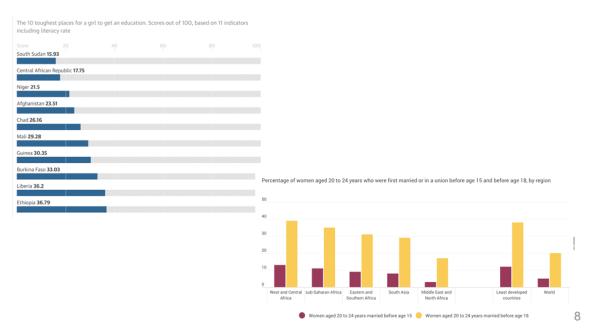




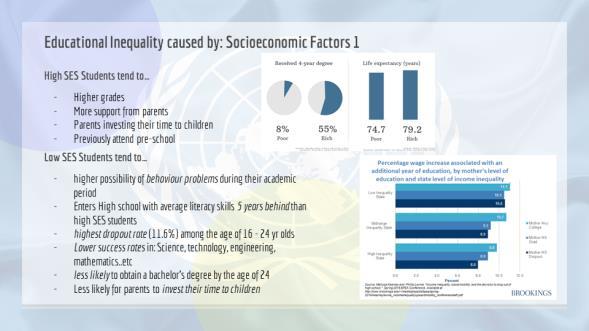
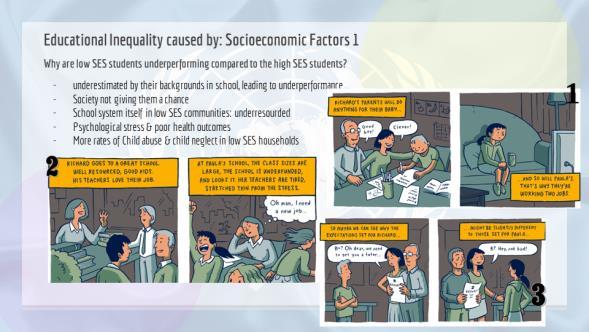


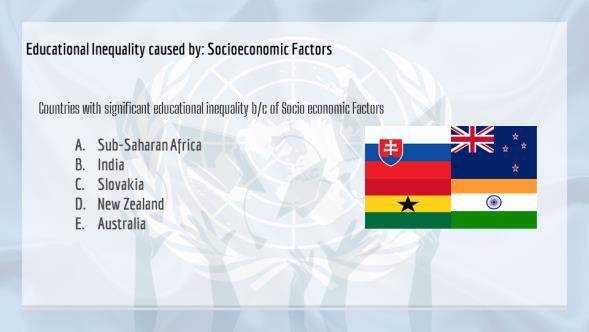







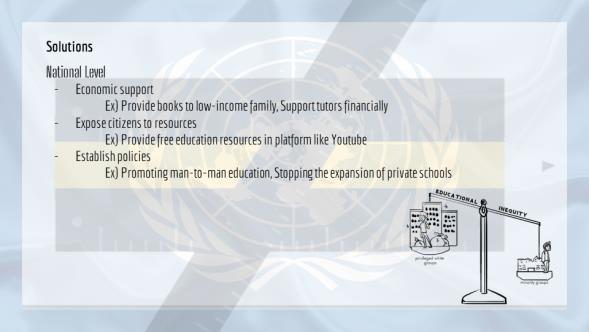





Korea International School Jeju, Michaela Kwon Yongsan International School of Seoul, Woojin Kim
Sinarmas World Academy, Jaeyi Kim
Daewon Foreign Language High School, Yuha Chi Flintridge Preparatory School, SeungWon Choi


With the development of frontier technology, the world is developing at an indefinitely exponential rate. Yet with such great lengths, technological development brings perilous drawbacks to humanity and the environment climate change and vulnerable environments. Along term change in the climate ofa certain region, climate change is mainly caused and accelerated by human activities such as the burning of fossil fuels. These activities are often followed by the greenhouse effect, where radiation from the Sun is trapped in greenhouse gases like methane, not released back into space but trapped in the atmosphere and increasing the overall temperature. Consequently, a 50% increase in CO2 and a 1.2°C increase in temperature have been spotted over the past few decades.
Even further, intensified human activity makes the environment more precarious and fragile. Climate change has become more evident and frequent in the Pacific Ring of Fire, leading to wildfires, hurricanes, and flooding. Water pollution due to eutrophication, oil leakage, and poor waste management lead to a shortage in water sources. According to the World Health Organization(WHO), 2.2 billion people, which is about 29% of the world’s population, lacked access to hygienic drinking water services in 2017. Air pollution due to power plants and the burning of fossil fuels escalates atmospheric nitrogen and sulfur levels. This results in the acidification of both land and aquatic habitats, forming acid rain that leaches aluminum in the soil and contaminates water bodies. The ongoing destruction of habitats and wildlife is beyond repair. Highly aware of these vulnerabilities, we must cultivate a profuse of social policies and construct an innovative plan that seeks to balance technological elevation with equity.

Sea level rise is a concerning issue driven by climate change. As glaciers and icebergs melt and an increase intemperaturecausesthermalexpansionofseawater, sealevelshaverisenby101.2millimeterssince1993. This leads to floods, sinking cities, agricultural failures, biodiversity loss, hurricanes and typhoons, weakened ground, and soil erosions. Water pollution is aggrandized due to flooding; this leads to a socioenvironmental dilemma where the volume of water increases, but the amount of potable water decreases.

Jakarta is the fastest sinking city in the world. Flooding in the capital is an everyday sight with 13 rivers running through the Java island that the cities are situated on. This not only weakens the soil but makes Jakarta a potential ‘sinking city’. According to Heri Andreas, a researcher at the Bandung Institute of Technology, the potential for Jakarta to be submerged is immense. By 2050, about 95% of North Jakarta will be submerged. Stagnant floodwater that collects up in the lower regions of North Jakarta evokes odor, cracks, and reduced soil fertility. Even further, urbanization and overpopulation in the capital city of Jakarta is another humanitarian issue Indonesia is facing. 3.94% of the archipelago’s total population resides in Jakarta, which accounts for just 0.03% of its total land area. The huge population is continuing to sprawl inwards to the capital city of Jakarta, leading to the aggression of natural disasters, crime, and overpopulation.
As pollution from transportation and factories accumulate in the atmosphere, climate change and rising water levels will be accelerated over time. To decelerate rising sea levels and intense flooding, the Indonesian government is planning to construct a bird shaped, 35km long, and 80 foot high protective barrier named “the Great Garuda”. Furthermore, in August 2019, Indonesian President Joko Widodo announced the relocation of Indonesia’s capital to the island of Borneo, West Kalimantan, starting in2024. Thestrategicchoiceoflocationwilldispersethesocioeconomicburden onJakartaaswell asenvironmental burdens especially rising sea levels.
Deeply empathizing with climate change and arising environmental issues, a positive perturbation in society must occur. Firstly, an inclusive, active society can follow the 3Rs policy: reduce, reuse, and recycle. This will effectively reverse and prevent the overexploitation and wasting of resources, such as clothing, food, and cosmetics. Secondly, social awareness must be raised in society to escalate the development of environmentally sustainable policies. Inaddition, governments can collaborate with strong institutions to provide underprivileged populations with knowledgeability as well. Effective tools would be social campaigns, multimedia, global citizenship education, and service actions.
Climate education further stretches out to developing climate resilience, which is the ability to withstand and manage the ongoing effects of climate change. For instance, the government could develop stronger regulationstowastemanagement andinvest moreininnovative solutionstotacklewater pollution. Climate resilience will be brought by strong, equitable institutions that balance technological innovation through climate risk assessments, paradigm shifts, long term capacity development, and partnerships for the goals.
Lastly, the usage of clean energy such as wind turbines, solar panels, hydroelectric energy, and wave energy can be maximized. This will prevent the burning of fossil fuels and the exploitation of natural gas and crude oil, efficiently tackling greenhouse gas emissions.

Adding up to the alteration of human activities, innovative solutions have been designed throughout the program. Firstly, a blueprint of an Eco sharehouse has been developed. The Eco sharehouse provides sustainable features such as air ventilation, clean energy, fewer carbon emissions, clean air with a green or “living” roof, reduced electricity usage with lightbulb solutions, and good lighting.


Secondly, a ‘nutrient bomb’ solutionwasdesignedtostrengthen climateresilience andtreat waterpollution. Taking the shape of a bath bomb, this water bomb will contain nutrients to nourish coral reefs and revive marine biodiversity. This nutrient bomb will consist of: 1% iodine that synthesizes coral pigments, 10% carbonate that purifies water, 15% strontium that increases calcium absorption and catalyzes the growth of hard coral skeletal tissues, and 74% calcium that builds corals’ skeletal muscles and shells, and stabilizes the alkalinity of water.
One of the main causes of climate change is greenhouse gas emissions. Greenhouse gas emissions are mostly caused by human activities, and this consists of 75% CO2 from burning fossil fuels, 14% Methane from decay of organic wastes in landfills, and 8% Nitrous oxide from agriculture and other industrial practices. Greenhouse gasses absorb heat and trap it on Earth, preventing the heat from returning back to space. Uncontrolled high concentrations of greenhouse gasses can cause an increase in global average surface temperature and also lead to several climate hazards.
According to Our World in Data, as of 2020, global greenhouse gas emissions were 73.2% in the energy sector, 18.4% inagriculture, forestry and land use, 5.2%in industries, and 3.2% from waste. When divided into more specific categories, it is notable that a majority of emissions are related to industrial practices. Some of the main causes of pollution from the industry sector are leaks from manufacturing processes or equipment, composting of wastes in landfills, chemical reactions, and over production and consumption of energy.

I would like to suggest three solutions for greenhouse gas emissions from industrial practices: to reduce through waste prevention, to reuse through resource circulation, and to adopt a zero waste lifestyle.
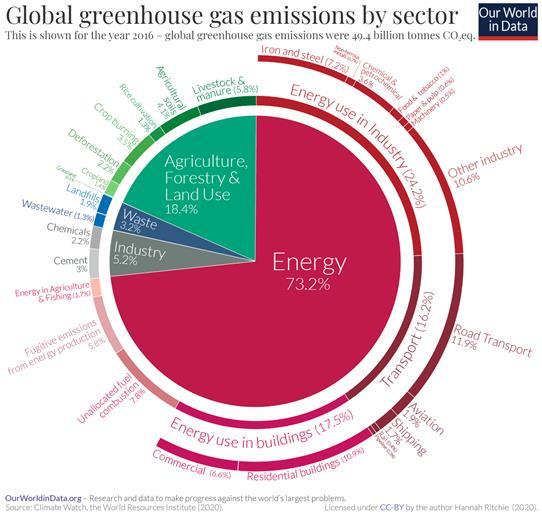


Waste prevention, also known as source reduction, means minimizing the usage of materials to create less waste in the first place before taking other additional measures such as recycling. Waste prevention has many positive effects in reducing greenhouse gasses. First, by reducing the amount of energy inputted in extracting, transporting, and processingraw materials or manufacturing products, we can reduce emissions from the energy sector. Also, by reducing waste such as paper products, we can conserve more trees which can absorb and remove more carbon dioxide from the atmosphere. Furthermore, we can reduce methane emissions from composting wastes in landfills.
Resource circulation means minimizing the use of natural resources to reduce the generation of wastes and then reusing then reusing wastes as materials or energy to the maximum extent possible. The resource circulation loop diagram below demonstrates how the entire process attempts to minimize the input of raw materials, and focuses more on the 3Rs and the smooth flow of resources and waste.

Oneexampleofinternational cooperationforresourcecirculationisthereport “ARoadmapforSustainable Waste Management and Resource Circulation in South Asia”, which was adopted with the goal of setting a specific policy framework and elaborating targets and measures to structure an efficient waste and resource management system in South Asia. Currently, South Asia creates 334 million tons of waste every year, and an increasing amount of e waste, construction and demolition waste, plastic and marine litter is also contributing to global concerns. The main goals are to minimize waste generation and maximize resource utilization through multilateral cooperation based on the SDGs and NDCs.
Another case is resource circulation cooperation by companies GS Caltex and Amorepacific. GS Caltex has been producing eco friendly compounded resin by recycling plastic bottles, and as of 2021 produced 25,000 tons during the year. Moreover, by cooperating with cosmetics company Amorepacific and collecting empty cosmetics containers, GS Caltex is expanding the project by aiming to recycle them into new cosmetics containers at least 100 tons a year, and trying to increase the ratio of eco friendly compounded resin to the products by 50% in 2050. The expected outcome of this project is to reduce 61,000 tons of annual CO2 emissions, which has the same effect as planting 903,000 trees or reducing the amount of greenhouse gas emissions by 30,000 cars.

An action that individuals can take is adopting a zero waste lifestyle. A zero waste lifestyle means to take responsibility for consumption and reduce and reuse waste in our daily lives.
To elaborate, first, we should minimize disposable products and prioritize reusable items. Moreover, we should adopt an organic diet by consuming organic locally grown foods, plan our meals, and avoid
packaged foods. Finally, we should try to save energy by using rechargeable batteries and unplugging unnecessary electronics. Through these efforts in our daily lives, we can reduce our carbon footprint and contribute to reducing greenhouse gas emissions.
According to the WHO, Air pollution is “a contamination of the indoor or outdoor environment by any chemical, physical or biological agent that modifies the natural characteristics of the atmosphere.” In simple terms, air pollution is “A situation in which unwanted chemicals, particles, or gasses enter the air and threaten the life or the environment on Earth.”

While Air pollution used to be widely discussed throughout the world, recently, there isn’t been as much attention given to the growing issue. Over the course of the years, the global and news trend for air pollution has dropped, yet air pollution remains as a serious problem. While countries such as the US reports that air pollution has significantly decreased compared to the Industrial revolution, for example, the EPA which provided graphsthatsupposedlyprovethattheconcentration ofpollutantsandemissionshave significantly reduced, reports on air pollution in 2022 by the WHO says,
Almost the entire global population (99%) breathes air that exceeds WHO air quality limits, and threatens their health.”
Furthermore, reports on air quality by the WHO in 2022 said, There are approximately, “7 million deaths each year from exposure to ambient and household air pollution,” “2.4 billion people in the world use polluting fuels and technologies in households,”
And, “91% of the world’s population lives in places where air pollution levels exceed the WHO guidelines”



According case studies on some of the countries in the world, India reveals air pollution is the second largest health risk in the country, reducing the average life expectancy of India as a whole by 5 years and 7.6 years of life expectancy for 40% of Indians in the Indo Gangetic plains (which is the most densely populated area in India) Also, due to air pollution, respiratory diseases and the ageing of the lung are much faster in India, especially for children. According to the report in 2020, air pollution killed more than 116,000 infants in 2019, and many children in India had higher risks of developing problems with brain development, cognitive abilities, and potential chronic diseases in the future. Despite such problems, India’s air quality is extremely under monitored. The report says there are at most, 0.8 monitoring stations for every 1 million people which compared to other countries such as China (with the ratio of 1.2 per million) or the US (3.4 per million) is very low. While there are measures that are being taken, India remains as one of the most air polluted countries in the world.
Another country infamous for air pollution isBangladesh. For many years, Bangladesh was suffering from severe air quality problems and its consequences. The air pollution in Bangladesh has reduced the average life expectancy by 6.7 years and at most 8.1 years. The air quality level of Bangladesh is four times the WHO index, which according totheAir Quality Life Index is about 75.8 particulate pollutionwhichmeans about 75.8 particles were found in every drop of liquid. Also, respiratory diseases in Bangladesh are increasing with around 210,000 patients with respiratory problems found yearly in a single hospital according to the National Institute of Diseases of the Chest and Hospital in Dhaka. Finally, despite the efforts being made in Bangladesh, reports in 2021 say that approximately there was an increase of 7~10% in air pollution

1. The first major cause that contributes to the majority of air pollution is Greenhouse Gas emissions. This usually comes from industries or burning fossil fuels which have contributed to many health problems.
2. The second major cause is Dust. Dust that contributes to air pollution is created from situations such as poor water management for example the Desiccation of the Aral sea in the 1960s, industrialization, etc.
3. The third cause is transportation. The third cause is part of the first cause as cars or other forms of transportation burn gasoline which pollutes the air
4. The last cause is household energy. Although many people in the cities often use electricity as their main form of energy, polluting devices and fuels are still widely used such as methane gas, air filters, etc.
Of course, there are many more causes of air pollution but the 4 are major contributors to air pollution.
The general effect of air pollution is contributing as one of the world’s leading risk factors for death, attributing to 11.65% of death globally, contributing to the cause of many respiratory diseases and more.

The First possible way of reducing air pollution is by following the WHO Global Air Quality Guidelines which have been made in 2021. The report provides explanations and guidelines to governments regarding the recommended air quality levels. By following this guideline, countries can expect gains in life expectancy years, reduce in respiratory and other health problems, and other benefits.
2nd way is to enforce more environmental laws. While there are many countries that have strict environmental laws to reduce air pollution, countries such as Asian countries or Africa have very few environmental laws that monitor the situation of air pollution.
Another way of reducing air pollution would be funding, As countries in Africa or Southeast Asia aren’t as developed as other countries, plans for reducing air pollution are difficult. Therefore funds can benefit them to contribute to the reduction of air pollution.
Finally, we can also contribute to air pollution by using less polluting devices such as cars, plastic, paper, etc. Also by spreading the information about the severity of air pollution, we can help take a closer step to reduce air pollution.
a) Eutrophication it is a gradual increase in the concentration of phosphorus, nitrogen, and other plant nutrients in an aging aquatic ecosystem such as lake. When the nutrients enters water
through runoff from land, massive number algae blooms and planktons develop on that area and lead to death of organism from lack of sunlight.

a) Fertilizers that were spread through the water stream into the water body. (continues in the Fertilizer to Eutrophication, section)
b) CAFO, or Concentrated animal feeding operations are also the primary source of phosphate and nitrogen fertilizers, which contribute to eutrophication. CAFOs discharge large levels of animals wastes into water bodies, in which the animals wastes has a lot of nutrients involved in fertilizers.

c) Sewage water is released directly into water bodies in various regions of the world, particularly in impoverished countries. As a result, it introduces large amounts of chemical fertilizers, causing algal blooms and other aquatic plants to grow densely, endangering aquatic life in a variety of ways. Although some nations clean sewage water, they nevertheless dump it into bodies of water after treatment. Regardless matter how well the water is treated, it can still lead to the buildup of surplus nutrients, resulting in eutrophication.
d) Aquaculture is the practice of producing shellfish, fish, and even aquatic plants in water containing dissolved nutrients without the need of soil. It ranks as a leading contributor to eutrophication since unconsumed food particles combined with fish waste can drastically raise nitrogen and phosphorus levels in the water.
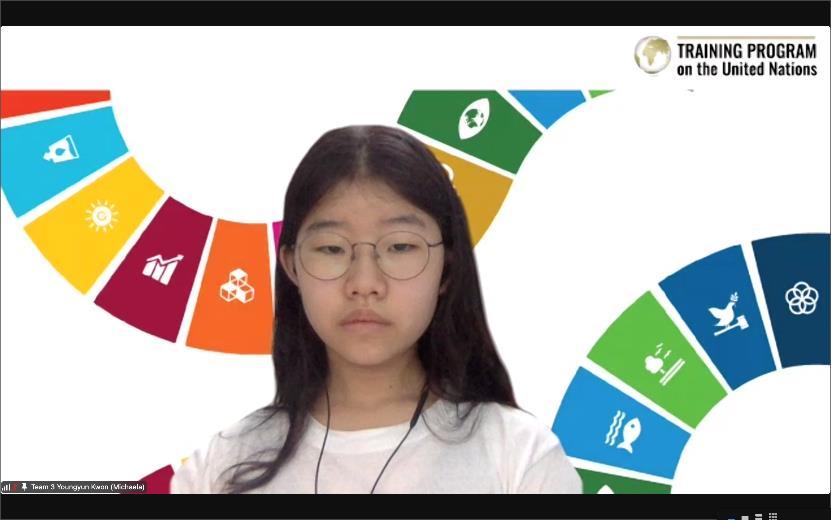

a) If we get into deeper about how fertilizers producing eutrophication, phosphate and nitrate nutrient accumulationis aided by agricultural methodsand fertilizer usage on lawns, golf courses, and other areas. When these nutrients are drained into lakes, rivers, oceans, and other surface waters when it rains, plankton, algae, and other aquatic plant life are well nourished. This results in a rapid growth of algae blooms and plant life in aquatic habitats.
i. Nutrients that are in the water. Nutrients like orthophosphate, phosphorus, nitrogen in nitrate.
ii. Water quality. (Like the different nutrients that are in the water that I explained) Depending on the water quality, there will be different fish, plants, insects will be living differently. Since scientist know what animals are in what environment, they can know
iii. Water transparency; since when there is algae due to fertilizers, the lake/river will be less transparent.
i. In situ monitoring easy to say is measuring in the direct place (in this case where eutrophication is happening).
ii. Temperature: Algae blocks the sunlight and oxygen from getting in, there will be more photosynthesis happening leading to more animals. Since the animals will block the oxygen and sunlight, many of the animals will die.

iii. Dissolved Oxygen: When there is more dissolved oxygen in the water, it will e a good environment for the animals.


i. Reduce and prevent the eutrophication by reducing the source of nutrients that causes eutrophication
1) For example, we can remove the phosphate from the place sewage treatment is going on, and reducing the amount of the fertilizer that we use when we grow plants.
ii. Use the buffer strips that is belivable that traps the eroding soil particles.
iii. Old sediments that are near the water should be removed
1) Even though the external nutrients is reduced, the internal nutrients might be not reduced because it can come from the sediment and prevent the increase of the water quality.

b) As Youth, we can
i. Prevent over using the fertilizer while we are taking care of our garden or field
ii. Making sure that we are not pouringany chemicals inside lake, river, ocean, or anyother natural water source in mistake or with purpose
a) Hydroelectric Energy it is a form of energy that harnesses the power of water in motion such as water flowing over a waterfall to generate electricity.
a) Hydroelectric energy is the most commonly used renewable source of electricity. China is the largest producer of hydroelectricity. Other top producers of hydropower around the world include the United States, Brazil, Canada, India, and Russia. Approximately 71 percent of all of the renewable electricity generated on Earth is from hydropower.
b) The way the hydroelectric energy works is: most hydroelectric power plants have a reservoir of water, a gate or valve to control how much water flowsout of the reservoir, and an outlet or place where the water ends upafter flowingdownward. Water gainspotential energy just before it spills over the top of a dam or flows down a hill. The potential energy is converted into kinetic energy as water flows downhill. The water can be used to turn the blades of a turbine to generate electricity, which is distributed to the power plant’s customers.


a) There are three different types of hydroelectric energy plants.

(1) Uses a dam to store river water in a reservoir.
(1) Uses a series of canals to channel flowing river water toward the generator powering turbines.
(1) Collects the energy produced from solar, wind, and nuclear power and stores it for future use.
a) There are 4 main benefits of hydroelectric energy.

(1) The storage for hydroelectricity generation can improve water supply for irrigation. Dams could be operated to build up a high hydraulic head and then release the water to produce hydropower.
(1) The energy generated through hydropower relies on the water cycle, which is driven by the sun, making it renewable. Hydropower is fueled by water, making it a clean source of energy.
(1) The dam that is used to connect the generator and the water prevent the water from getting over to the land and create the flood that will damage the land.

(1) The fact that it is renewable. Which means we can use it again, not just throwing away in one use. Which can give benefits to the environment by decreasing GHG emission and decreasing air pollution.


There are countless reasons why the world should switch to solar energy. First, solar energy is 22% energy efficient, meaning that out of all the sunlight that hits the panel, 22% of it is turned into energy. Second, it is the most abundant energy source as the sun will not stop shining. Third, you can generate energy even if it’s cloudy since the sunlight reflects off of the clouds and onto the panels. Finally, it’s the fastest energy source to set up. With sources like fossil fuels, you need to find a source and then connect it to your home, but with solar, all you need to do is set it up on your house.
We have and will see a steady increase in solar energy use globally with countries like the US, China, and India taking the charge. Currently, Solar energy accounted for 3.1% of global electricity generation.
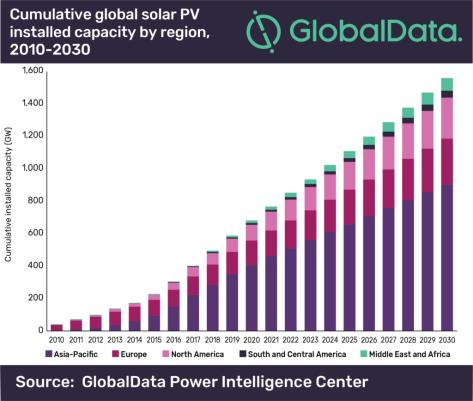

There are three main positive effects of solar energy. First, a solar panel system emits 80% fewer carbon emissions than fossil fuels. Second, it can decrease the long term output of air pollution, directly saving lives. Finally, it lowers costs for the consumer as solar technology is now cheaper than fossil fuels in most countries.


(1) Why High Speed Rail?

Currently, with transportation accounting for 27% of greenhouse emissions, there is an urgent need for global action. One of the best solutions provided to decrease emissions in the transportation industry is building high speed rail, connecting major urban cities to lessen the need for cars and airlines.



For starters, high speed rail is eight times more energy efficient than planes and four times more energy efficient than cars. This means to transport one person, planes use eight times more energy and cars use four times more, depleting our resources. In addition, many high speed rail plans included having renewable energy to fuel these trains, meaning that we would cut the emissions released from cars and airplanes, improving air quality.
(2) Current Progress China is the main investor in high speed


with countries like Japan and South Korea trailing. Though this may not seem like a great sign, the world has seen an amazing growth in its industry, with almost no high speed rail in 1964 to around 52,000 kilometers of high speed rail built as of 2019. If we keep up with the current trend, it is likely that there will be a significant reduction in emissions in the long run.

Indonesia Names New Capital That Will Replace Jakarta.” BBCNews, BBC, 18 Jan. 2022, https://www.bbc.com/news/world asia 60037163
Magazine, Smithsonian.
Jakarta Is Building a Gigantic Bird Shaped Seawall.” Smithsonian.com, Smithsonian Institution, 14 Dec. 2015, https://www.smithsonianmag.com/smart news/jakarta building gigantic bird shaped seawall 180957536/
Nunez, Christina, and National Geographic Staff. “Sea Level Rise, Facts and Information.
Environment, National Geographic, 16 Feb. 2022, https://www.nationalgeographic.com/environment/article/sea level rise 1
Peregoy, Beau.
SeeaMassiveSeaWall ShapedlikeaMythical Bird.
ArchitecturalDigest,Architectural Digest,12Jan.2016, https://www.architecturaldigest.com/story/jakarta sea wall
10. “Sea Level Rise Projection Map Jakarta.” Earth.Org, https://earth.org/data_visualization/sea level rise by the end of the century alexandria 2/
11. “Sea Level.” NASA, NASA, 18 July 2022, https://climate.nasa.gov/vital signs/sea level/
12. “Student Project: How Warming Water Causes Sea Level Rise.” NASA, NASA, 11 Oct. 2021, https://www.jpl.nasa.gov/edu/learn/project/how warming water causes sea level rise/
13. A SWOT Analysis of Climate Change Mitigation through Redd https://www.researchgate.net/publication/236171443_A_SWOT_analysis_of_climate_change_mitigation_through_REDD
14. “What Is Climate Change? A Really Simple Guide.” BBC News, BBC, 13 Oct. 2021, https://www.bbc.com/news/science environment 24021772
15. “What Is Climate Change?” UnitedNations, United Nations, https://www.un.org/en/climatechange/what is climate change
16. “Billions of people still breathe unhealthy air: new WHO data.” WHO | World Health Organization, 4 April 2022, https://www.who.int/news/item/04 04 2022 billions of people still breathe unhealthy air new who data Accessed 5 August 2022.
17. “Dusts.” Air Pollution Information System, 2016, http://www.apis.ac.uk/overview/pollutants/overview_particles.htm Accessed 5 August 2022.
18. Ghosh, Malyaban. “5 Striking Statistics & Facts of Air Pollution in India.” CEEW, 6 September 2021, https://www.ceew.in/blogs/five striking facts about air pollution crisis in india. Accessed 5 August 2022.
19. High, Vicki Ekstrom. “Bangladesh.” AQLI, https://aqli.epic.uchicago.edu/country spotlight/bangladesh/. Accessed 5 August 2022.
20. Johnson, Ceridwen, et al. “New WHO Global Air Quality Guidelines aim to save millions of lives from air pollution.” WHO | World Health Organization, 22 September 2021, https://www.who.int/news/item/22 09 2021 new who global air quality guidelines aim to save millions of lives from air pollution. Accessed 5 August 2022.
21. Manguiat, Maria Socorro. “Beijing announces new milestone on air quality but global standards still lacking.” UNEP, 10 January 2022, https://www.unep.org/news and stories/story/beijing announces new milestone air quality global standards still lacking Accessed 5 August 2022.
22. MICKIN, PHILIP P. “Desiccation of the Aral Sea: A Water Management Disaster in the Soviet Union.” CIESIN, http://www.ciesin.org/docs/006 238/006 238.html. Accessed 5 August 2022.
23. Mohan, Vishwa. “Indians losing 5 years of life due to air pollution: Study | India News.” Times of India, 15 June 2022, https://timesofindia.indiatimes.com/india/indians losing 5 years of life due to air pollution study/articleshow/92215757.cms Accessed 5 August 2022.
24. “Particulate Matter (PM) Basics | US EPA.” Environmental Protection Agency, 18 JULY 202, https://www.epa.gov/pm pollution/particulate matter pm basics. Accessed 5 August 2022.
25. Ritchie, Hannah, and Max Roser. “Air Pollution.” OurWorldinData, January 2021, https://ourworldindata.org/air pollution Accessed 5 August 2022.
26. WHO. “Air pollution Air pollution.” WHO | World Health Organization, https://www.who.int/health topics/air pollution#tab=tab_1 Accessed 5 August 2022.
27. WHO. “Air pollution data portal.” WHO | World Health Organization, https://www.who.int/data/gho/data/themes/air pollution?lang=en Accessed 5 August 2022.

28. WHO Media inquiries. “Billions of people still breathe unhealthy air: new WHO data.” WHO|WorldHealthOrganization, 4 April 2022, https://www.who.int/news/item/04 04 2022 billions of people still breathe unhealthy air new who data Accessed 5 August 2022.
29. http://datab.epa.gov/air/trendsreport/2022/#introduction. Accessed 5 August 2022.
30. “Billions of people still breathe unhealthy air: new WHO data.” WHO | World Health Organization, 4 April 2022, https://www.who.int/news/item/04 04 2022 billions of people still breathe unhealthy air new who data Accessed 5 August 2022.
31. “Dusts.” Air Pollution Information System, 2016, http://www.apis.ac.uk/overview/pollutants/overview_particles.htm Accessed 5 August 2022.
32. Ghosh, Malyaban. “5 Striking Statistics & Facts of Air Pollution in India.” CEEW, 6 September 2021, https://www.ceew.in/blogs/five striking facts about air pollution crisis in india. Accessed 5 August 2022.
33. High, Vicki Ekstrom. “Bangladesh.” AQLI, https://aqli.epic.uchicago.edu/country spotlight/bangladesh/. Accessed 5 August 2022.
34. Johnson, Ceridwen, et al. “New WHO Global Air Quality Guidelines aim to save millions of lives from air pollution.” WHO | World Health Organization, 22 September 2021, https://www.who.int/news/item/22 09 2021 new who global air quality guidelines aim to save millions of lives from air pollution. Accessed 5 August 2022.
35. Manguiat, Maria Socorro. “Beijing announces new milestone on air quality but global standards still lacking.” UNEP, 10 January 2022, https://www.unep.org/news and stories/story/beijing announces new milestone air quality global standards still lacking. Accessed 5 August 2022.
36. MICKIN, PHILIP P. “Desiccation of the Aral Sea: A Water Management Disaster in the Soviet Union.” CIESIN, http://www.ciesin.org/docs/006 238/006 238.html. Accessed 5 August 2022.
37. Mohan, Vishwa. “Indians losing 5 years of life due to air pollution: Study | India News.” Times of India, 15 June 2022, https://timesofindia.indiatimes.com/india/indians losing 5 years of life due to air pollution study/articleshow/92215757.cms Accessed 5 August 2022.
38. “Particulate Matter (PM) Basics | US EPA.” Environmental Protection Agency, 18 JULY 202, https://www.epa.gov/pm pollution/particulate matter pm basics. Accessed 5 August 2022.
39. Ritchie, Hannah, and Max Roser. “Air Pollution.” OurWorldinData, January 2021, https://ourworldindata.org/air pollution Accessed 5 August 2022.
40. WHO. “Air pollution Air pollution.” WHO | World Health Organization, https://www.who.int/health topics/air pollution#tab=tab_1. Accessed 5 August 2022.
41. WHO. “Air pollution data portal.” WHO | World Health Organization, https://www.who.int/data/gho/data/themes/air pollution?lang=en. Accessed 5 August 2022.

42. WHO Media inquiries. “Billions of people still breathe unhealthy air: new WHO data.” WHO|WorldHealthOrganization, 4 April 2022, https://www.who.int/news/item/04 04 2022 billions of people still breathe unhealthy air new who data. Accessed 5 August 2022.
43. Resources, Water. “Nutrients and Eutrophication Active.” Nutrients and Eutrophication | U.S. Geological Survey, 2019, https://www.usgs.gov/mission areas/water resources/science/nutrients and eutrophication
44. Staff, Author EarthEclipse's Editorial. “Causes and Effects of Eutrophication.” Earth Eclipse, 19 July 2022, https://eartheclipse.com/environment/ecosystem/causes and effects of eutrophication.html
45. Geographic, National. “Hydroelectric Energy.” National Geographic Society, 19 May 2022, https://education.nationalgeographic.org/resource/hydroelectric energy








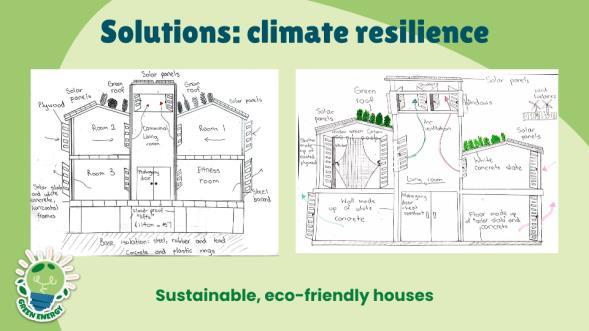




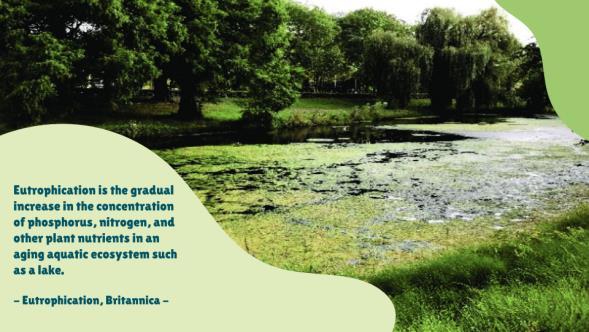









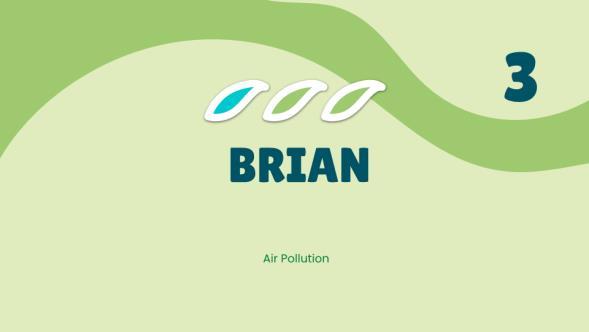





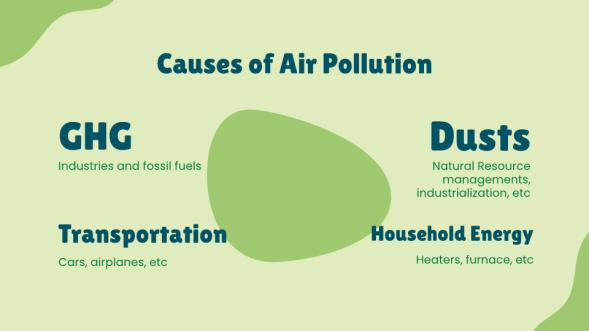







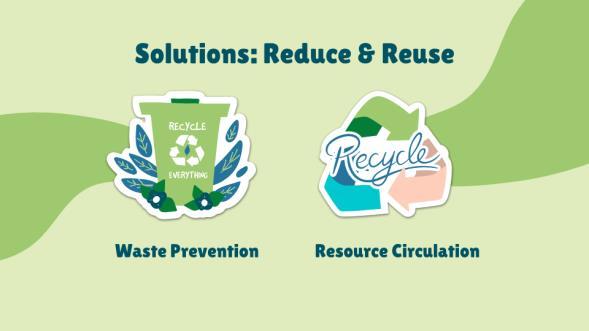
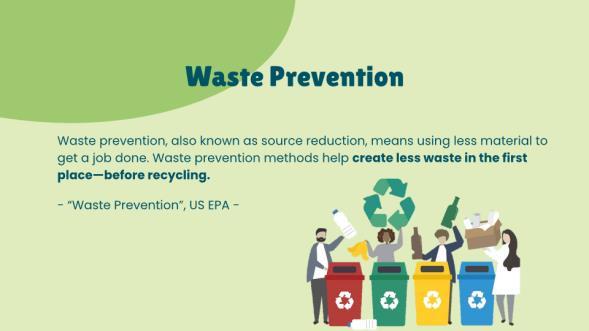









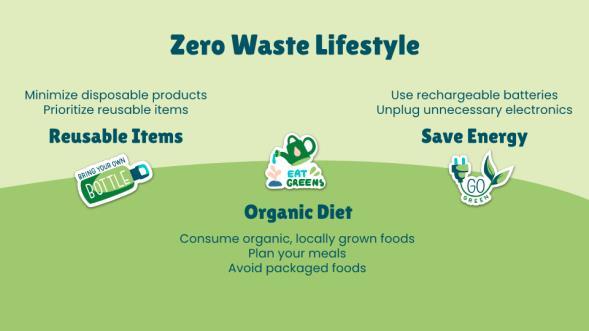














Canada Maple International School, Elishia Kim Flintridge Preparatory School, Ellie Sohn Daejeon Banseok High School, Yeseoung Lee Korean Minjok Leadership Academy, Ha Eun Lee

The Charter of the United Nations is its founding document. It was signed on 26 June 1945, in San Francisco, at the conclusion of the United Nations Conference on International Organization, and came into force on 24 October 1945.
The United Nations can take action on a wide variety of issues due to its unique international character and the powers vested in its Charter, which is considered an international treaty. The UN Charter codifies the major principles of international relations, from sovereign equality of States to the prohibition of the use of force in international relations.
The concept of gender equality has been established within the core guiding principles of the United Nations, and unequivocally reflects a commitment to the equality of men and women in all aspects of the human endeavour. More specifically, the Charter of the United Nations stipulates that there shall be no restrictions on the eligibility of men and women to participate in every capacity and under conditions of equality in its principal and subsidiary organs.
Strategic Objective G.1presented at the 1995 United Nations Fourth World Conference on Women in Beijing, states that the United Nations must take measures to ensure women's equal access to and full participation in power structures and decision making.
The UN specific objective states the following:
Implement existing and adopt new employment policies and measures in order to achieve overall gender equality, particularly at the Professional level and above, by the year 2000, with due regard to the importance of recruiting staff on as wide a geographical basis as possible, in conformity with Article 101, paragraph 3, of the Charter of the United Nations;
Develop mechanismstonominatewomencandidatesfor appointment toseniorpostsinthe United Nations, the specialized agencies and other organizations and bodies of the United Nations system;
Continue to collect and disseminate quantitative and qualitative data on women and men in decision making and analyse their differential impact on decision making and monitor progress towards achieving
the Secretary General's target of having women hold 50 per cent of managerial and decision making positions by the year 2000.
Action must be taken by the United Nations and other international organizations to eliminate barriers to the advancement of women within their organizations in accordance with the Platform for Action.

Their primary initiative is strengthening the institutional arrangements for support of gender equality and the empowerment of women.
53. Further decidesthat the mandate and functions of the Entity (UN Women) shall consist of the consolidated mandates and functions of the [former] Office of the Special Adviser on Gender Issues and Advancement of Women, the Division for the Advancement of Women, the United Nations Development Fund for Women and the International Research and Training Institute for the Advancement of Women, with the additional role of leading, coordinating and promoting the accountability of the United Nations system in its work on gender equality and the empowerment of women, and that any new mandates shall be subject to approval by intergovernmental process (page 9 of A/RES/289).
And now for the policies in our own country.
The ministry of gender equality and family progresses toward an equal and sustainable democracy that women and men build together. Their objectives are to promote mature awareness of gender equality, increase women’s employment and social participation, help women achieve a work life balance, and enhance women’s safety and health.
They have 6 major projects and 22 implementation strategies, and I will talk about 3 of them which I think are the most important and achievable.
The first project is promoting awareness and culture of gender equality. It aims to combat gender discrimination in the mass media and enhance gender equality education in school. It also attempts to promote a gender equal culture in our daily lives and toraise the effectiveness of civic education on gender equality.

Thesecondistoensureequal rightstoworkandopportunities.It promotesequal employmentopportunities for men and women and addresses employment related gender discrimination. It also enhances women’s status in the labor market and provides support for women to maintain and advance their careers.
The third is creating social infrastructure for work life balance. This attempts to strengthen social responsibility for care givings, guarantee work parents’ maternal and paternal rights, and foster a family friendly culture in the workplace.

Gender equality is an issue that requires much more attention and consideration than it receives at the moment. It affects the lives of countless women around the world, although invisibly.The policies regarding gender equality and women’s rights I talked about just now should therefore, in my opinion, be reinforced, and be adopted by many other countries as well who are facing similar problems.
Women had a great shift in society after COVID 19. I will start by describing how women were doing pre COVID
First, let’s start off with employment. If we go all the way to the early 1800s in the Western world, or more specifically America, they were in the midst of the industrialization era. This era was seen as the starting point for the capitalist economy as production became more efficient due to huge technological advancements. This could quickly be correlated with the growth of mills during this era. Middle class women started working in these mills, most notably the Lowell Mills, but were payed less than men and were expected to do all the housework. This can be explained using the widespread ideal at that time the cult of domesticity, a societalstandard for women. Thistrapped women ina framework which waslabelled as “femininity” and it pressured women to stay pure, submissive, and domestic. Similar standards were in place on the other side of the globe. For example, in Korea during the Joseon Dynasty, a woman’s worth was dependent on her marital status and they were expected to be housewives. It was really only until World War 2 where there was a sharp increase in working women, as you can see by the second graph. Men were sent away to war and it was up to women to keep the country running. As you can see, there was an increase in working women in Britain and America even created “Rosie the Riveter” to get more women to join the workforce.
However, after the war, many middle class women felt the pressure to stay home even if they needed the extra money. A line in the Book “The Feminine Mystique” published in 1963, by Betty Friedan states, “If a women had a problem in the 1950’s and the 1960’s, she knew that something must be wrong with her marriage, or with herself. Other women were satisfied with their lives, she thought. What kind of Women was she if she did not feel this mysterious fulfillment to wax the floor?” The base ideals of the cult of domesticity were still reflected during this period, which is whymany women saw this dissatisfaction with being a housewife as being “the problem.” However, the entry of women in the workforce gave many women a sense of self sufficieny and at least a small increase of respect in the workplace. With the Second wave feminism during the 60s ~ 70s more women started working and paving their own path. And finally, at the start of 2020, 50.04% of the workforce was made up of women!! What an improvement!
Second, I will talk about education. There was a phenomenon called the ‘reverse gap’ where women were outperforming men in enrollment and education results, as you can see in the graph. This is different from before, when education for women wasn't seen as mandatory. Not only did women get an increase in education, they were also able to study a much more diverse number of majors. If we go back to the Feminine Mystique, there was a line that stated, “But girls would not study physics, it was unfeminine.” In fact, only 1% of engineering majors in the 60s were women. Now, there is an increase in women studying stem. In developing countries, education is still an issue for many women. In fact, in Somalia, only 95% of women between the ages of 7~16 have received education. Another example are women in India. Theyare busycollectingwater orexpectedtodohousework whichstripstheir chance tobe educated.
Third, let’s look at violence. 1 in 35 women are sexually assulted yearly. 90% of adult rape victims are women. 200 million women alive today have had female genital mutilation. 1 in 2 women have been raped by their current or ex current partner. Based by the statistics I just listed, we can tell that women pre Covid were still facing an immnense amount of violence.


Lastly, mental health. If we go back to women feeling an “unknown problem” in the 60s there legitimate mental health issues were being dismissed. These are best stated in two lines from the Feminine Mystique. First, “The problem was dismissed by telling the housewife she doesn’t realize how lucky she is her own boss, no time clock, no junior executive gunning for her job. What if she isn’t happy does she think men are happy in this world?” Second, “But the actual unhappiness of the housewife was suddenly being reported ... although everyone who talked about it found some superficial reason to dismiss it.” After this book was published, more women started to get more and more therapy. However, there was a lack of care for postpartum depression. Postpartum depression is depression women face after childbirth. In fact, 1 in 10 women face postpartum depression but 50% of those women don’t get medically diagnosed most of those women don’t even receive adequate care!
To endthissectionona goodnote, women psychologists actuallystarted taking standsto studypsychology for women. Lots of psychologists back then would experiment on men and would generalize those results to all women. But psychologists, like Karen Horney criticized a prominent psychologist named Frued on his depiction of women and brought much attention to the psychology of women.
 Ellie Sohn (Flintridge Preparatory School)
Ellie Sohn (Flintridge Preparatory School)
Before the pandemic struck, the globe had made impressive progress towards achieving the United Nation Sustainable Development Goal Number 17, gender equality. However the disease proved to be a great setback for every single nation and targets outlined by the United Nations. The greatest consequences can be identified in five main aspects, economic stance, education, violence and abuse, mental health, and post COVID 19 policies.
The first identifiable element under economic stance is unemployment. Before the COVID 19 crisis women had much lower rates of unemployment and job losses as the graphs portrayed dropping numbers. HoweverwhenCOVID 19hit, outofthe39percent ofglobalemployment thatwomenmadeup, 54percent of job losses accounted for women. This was a statistic drawn out by the McKinsey Global Institute, as they also ruled that women’s jobs were 1.8 times more vulnerable in the crisis than men’s jobs. The reason behind this was the social phenomenon of social clumping. Men and women have a tendency to clump to certain areas of jobs or employment. This meant that during the pandemic, women who have a higher proportion of employment in the food industry, experienced the most drastic job cuts. This not only set women back in the goal to achieve fair and equal pay for women but also pushed down those in a single parenting situation who were in dire need of wages. However through countless studies, it was proven that there was a single solution to this dilemma for all employed women. It is to take action now to reverse the effects and progress gender parity. Through an extensive diagram outlined in the McKinsey Global Institute Report, the impacts of “taking action now” were outlined, it involved not only completely turning back the harms done by the disease but also progressing to the double point where it was prior to the situation.

However the effects of unemployment have not yet stopped, and are continuing to create an upheaval of consequences, the greatest being poverty. Women were pushed into extreme poverty due to their unemployment statuses and unpaid child care they were forced to bear. Due to the quarantines put in place all around the world, children were staying home, unable to attend daycare or school. This meant that parents, especially women, who bear the social norms of having to lead child care, were forced to bear extremes. They had to either quit their jobs, work less hours, or work later into the nights. However despite the effort of women to stay on the surface, they were still the most vulnerable towards job cuts which meant that they were not earning any wages while spending all of their time taking care of their children. Although the act of childcare is important, it is highlighted as an extreme job that is unpaid, and forces women to be victims to the 15th century gender roles. According to the US Global Leadership Coalition, the pandemic will push 198 million people in extreme poverty with women being 25% more likely than their male counterparts to fall to this reality. In correlation with the United Nations Sustainable Development goal number 17, target 5.1 and 5.4 are in direct relation with this aspect of economic stance. Target 5.1 which outlines erasing all gender inequality of any kind, and Target 5.4, compensating for unpaid child care. By pursuing this SDG, we can step closer to reversing the consequences which affected women economically in various aspects.
The next subsection is education. Before the pandemic men and boys had a much higher dropout rate than women and girls. Women were excelling in the education system, breaking down social barriers and educationinequality. HoweverastheUS GlobalLeadershipCoalitionreported, womenandgirlswere11% more likely to drop out of school during the pandemic. This was only further supported by the Malala Fund’s claim that 20 million more secondary school aged girls could be pushed out of school after the whole crisis. That wouldmark 20 millionmore young girls pushed intothe spots ofinequality and violated human rights. However, one question worthy of this situation was “why”. The answer lies in various aspects and also varies greatly per region, but the greatest labels were early marriages, social norms, and for profit. Due to the social norm that girls don’t hold education as a necessity to their lives, families saw the chance to withdraw their children from school. Other reasonings lied in purposes of child marriage, during COVID 19 the prices and profit for child marriages were more valuable as many families suffered economically. However the victimof thissituation wasn’t the family but solelythe younggirls pushed into marriage. This directly relates to targets 5.1 and 5.5 which state that all women should be allowed equal and fair opportunities in employment. But with these growing dropouts, it becomes nearly impossible for women to obtain the same chances as their male counterparts.
A stock photo of a woman with tears rolling down her face and a hand over her mouth. Does that image sound familiar? In the various searches made about domestic violence that very image is one that comes out repeatedly. Entrapped in their households, unable to speak to anybody, unable to seek help, being abused bytheirpartners. Thiswas closetothe realitybefore the pandemic, but duringthepandemicwomen suffered horrible amounts of violence. So much violence occurred that it was even given a name. It was coined as the Shadow Pandemic by the UN Women Report. A dark and long shadow covered all of the women during COVID 19, trapping one too many women and young girls. The UN Women report found that 245million women and girls were subjected to either sexual and/or physical violence by their partners or families. Asmostshelterswere closedoff duringthepandemic itbecame even harder tospeak upagainst the violence. Being stuck inside the household with one’s abuser subjected countless women to this harsh reality of the 21st century. However one thing to note is that even before the pandemic, domestic violence was still a glaring problem. It was simply that the greater wave of statistics finally brought a brighter light onto a pandemic of itself. The disease of violence and abuse. In a Save the Children survey of 25,000 people, children reported higher rates of violence when schools were closed down. Young girls to aged women were subjected to the same situation and it is essential to highlight again and again this violation.

Another form of violence that occured was not only domestic but also through human rights violations. Female Genital Mutilation, a completely unnecessary, painful, and dangerous procedure, was recognized as a problem priorthepandemic andwasintheprocesses ofbeingreversed. Asguestspeaker atthetraining program, Jessica Dewhurst explained, FGMs are clear human rights violations. However, following the predictions of the UN Women Association, 2 million additional girls will be subject to FGMs due to COVID 19. The pandemic caused a great setback in the progress made by the United Nations and other associations. As discussed before, child marriages, as estimated by UNICEF, would have 10 million increased cases. An alarming fact noticed during the crisis was that more and more younger children, even those aged 5 were being sold into the marriage industry. As targets 5.2 and 5.3 outlines, these violations must be prevented before they victimize 12 million additional innocent girls who aren’t given a choice in these series of events.
Lastly,therewasagreatincreaseinmentalhealthproblems, whichledtohigherratesofsuicideforwomen. Because women were isolated with domestic violence, unemployment, unpaid child care, and extreme stress, they had too much tobear alone. Pushed into helplessness, not able to do anything to save the scraps of their lives before it was ripped to shreds, they decided to choose the last resort. According the Korean newspaper outlet, JoongAngIlbo, womenintheir20sand 30sinKorea were taken tothehospital after 43% increased rates of suicide. Without proper help outlets and knowledge about ciris lifelines, 12 million seriously thought about suicide in 2020. There is a necessity for proper knowledge spread about help centers and lifelines.
Despite all of these dismal situations and extreme setbacks, there were still Post COVID 19 Policies created by the governments of various countries and the citizens. A report from UN Women outlines various countries who participated in supporting women even throughout the situation. These countries consisted of Canada, Australia, Mexico, China, Spain, Argentina, France, Colombia, Costa Rica, and others. Canada offered $50 million towards women’s shelters, Australia helped enhance family violence responses, in Mexico more money was offered towards domestic violence shelters, and in China. citizens started off the hashtag #AntiDomesticViolenceDuringEpidemic with online resources to seek help. Not only can the government work to support women, but citizens, women can come together to create venues to support one another and advocate for more women’s policies.
Although evidence shows that gender inequality exists, a notion of denying it is a rising trend in many countries. This tendency can be identified as ‘anti feminist backlash’.
Backlash is a strong negative reaction by a large number of people, for example to something that has recently changed in a society. Since social changes are mostly launched by the revolting side, the main agent of backlash is often the majority, or the group of high status in a society, which holds more power in a traditional conflict. ‘Anti feminist backlash’ is backlash against feminists and feminism. It denies the necessity of feminist action and doesn’t aknowledge the existence of gender inequality.

‘Anti feminism’ isn’t the only trend of the 21th century. Notions about feminism is still very active, and progresses to secure women’s rights are continuously being made. Separated from social networking services and online communities, official media itself tends to be ‘feminist friendly’. Politicians and celebrities publically speak up, supporting feminism ideas. The remark of Justin Trudeau, the prime minister of Canada, represents the trend; “We shouldn’t be afraid of the word feminist. Men and women should use it to describe themselves.” But there are also a rising notion of anti feminism, and this has become a major idea in some societies. This report will specifically focus on the example of South Korea.
The political scene of South Korea sharply grew hostile toward feminism recently. Right wing politician Lee Jun Seok officially stating that ‘the gender quota system isn’t needed’, and President Yoon putting up the abolition of the department of gender equality family as one of the main pledges are the evidence of this trend. Noted as SDG 5, gender equality is a goal that the global community is constantly working on to achieve. Feminism isthe stemidea gender equalitythat upliftsit yet manypoliticians are usingfeminism to create political conflicts. The seriousness of this trend lies in the fact that feminists and feminist actions are intensively attacked in the process.
This widely affected the social atmosphere, to the point of creating a new syndrome. This social phenomenon named the “although I’m not a femnisit” syndrome(
) is a tendency of avoiding to be seen as a feminist, while secretly agreeing that gender inequality exists and needs to be fixed.
Empirical statuses also reflect the current situation of South Korea. According to a 2021 survey conducted by Hankook ilbo news, less than half of the male population of Korea appeared to disagree that women experience serious discrimination. The results got much more drastic when the word ‘feminism’ was involved.
A 2022 survey conducted by kyunghyang shinmun researched the perception of Korean citizens toward gender equality and women’s rights policies. The three questions in the survey were, “Do you support feminism”, “do women experience more discrimination than men”, and “should policies supporting women be expanded”. The results of three different survey questions are revealed to reflect a common recognition toward feminism and policies supporting women. As the ages of the respondents decrease, the gapbetweenmalegenderandfemalegenderincreases Youngergenerationare eitherextremelysupportive or extremely unsupportive to the idea of feminism, depending on the gender.
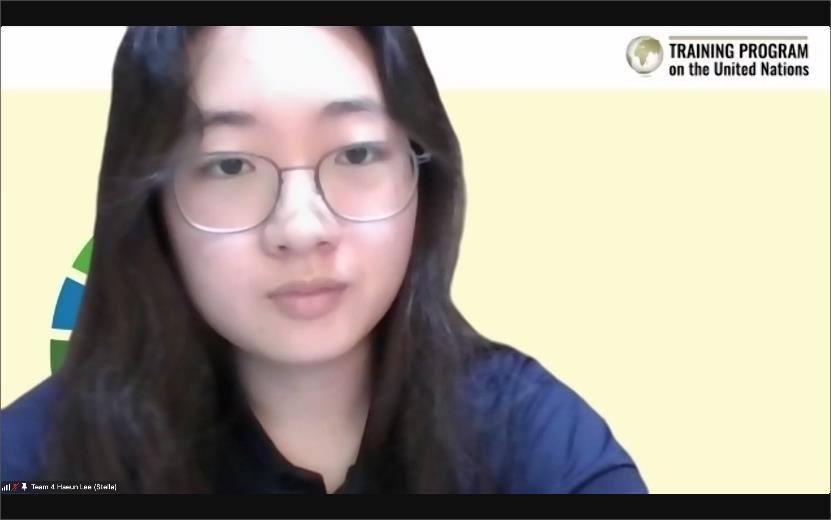

This could be better understood by taking into account the progress made in gender equality. Since significant progress was made, naturally the younger generation experienced less gender discrimination in their lives. However, what forms a societal norm is the culture of the upper generation; the generation that is dominant in political power and capital. The younger generation tends to lack the insight to see through the social phenomenon; rather, their sights are limited to the experience they have. This gap creates a misunderstanding toward feminism incorrect beliefs which eventually leads to anti feminist movements.
One example is Louisiana’s abortion war. Back in 1973, Louisiana was one of the pro abortion states 54 percent of the citizens strongly agreeing to the legalization of abortion. However, after the famous ‘Roe’ decision, legally allowing right to abortion, catholic and evangelist communities united under the purpose of ‘ securing religious values’ and the ‘right to live’. Since then Louisiana became the epicenter of anti abortion movements. This movement underwent changes that could be devided into 3 phases. The first wave was focused on judicial and legislative activities. The second phase involved direct violence. In the third phase, the movement returned to the judicial realm. During the second phase, there were some life threatening crimes. In 1985, two women’s clinics in Louisiana had to suffer from a bomb threat and arson attacks.
Backlash movements are not only limited to highly spotlighted political issues; They also influenced the field of education. In the United States, Women’s scholarships and awards are being eliminated due to the decision of the department of education.
One of the latest targets is the Marilyn C. Davis scholarship at the University of California, Santa Cruz (UCSC). To be eligible for the Davis scholarship, an applicant must be a mother returning to receive education in the sciences at UCSC. Kursat Pekgoz, an ex USC student now working in Turkey, filed a complaint against UCSC with the Department of Education (DOE). He believes that the scholarship is sexist and discriminatory because the award is not open to men. Last week, he received confirmation that the DOE will investigate, and a spokesperson from the university says they’re aware of the investigation and are cooperating. The UCSC scholarship is just one example of the hundreds of women’s scholarships and awards currently under scrutiny for being sexist and discriminatory.
In the 2020s gender conflict became such an issue that it is frequently used as a powerful political tool. Politicians are actively using this tool to earn victory in elections. They bring up ‘gender quota system’, and ‘gender equality’ to the debate table increasing the conflict.
https://www.mckinsey.com/featured insights/future of work/covid 19 and gender equality countering the regressive effects
https://www.usglc.org/coronavirus/women and girls/

https://www.brookings.edu/essay/why has covid 19 been especially harmful for working women/ https://downloads.ctfassets.net/0oan5gk9rgbh/6TMYLYAcUpjhQpXLDgmdIa/3e1c12d8d827985ef2b4e815a3a6da1f/COVID19 _GirlsEducation_corrected_071420.pdf

https://data.unwomen.org/sites/default/files/documents/Publications/Measuring shadow pandemic.pdf

https://resourcecentre.savethechildren.net/pdf/vr59 01_protect_a_generation_report_en_0.pdf/ https://www.concern.net/news/impact of covid 19 on women and girls


https://www.joongang.co.kr/article/25035109#home
https://axiawh.com/resources/covid mental health/ https://eige.europa.eu/covid 19 and gender equality/essential workers



Women’sScholarshipsAndAwardsEliminatedToBeFair ToMen(Apr 13, 2022)
https://www.forbes.com/sites/kimelsesser/2022/04/13/womens scholarships and awards eliminated to be fair to men/?sh=79db95777fe2




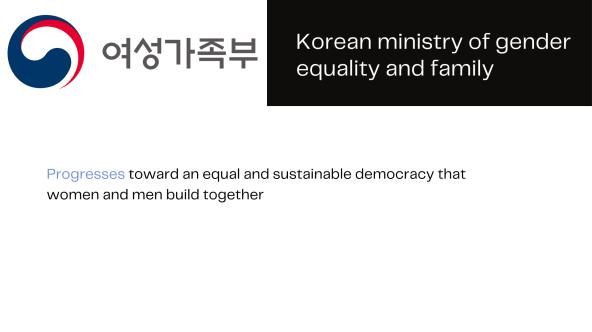



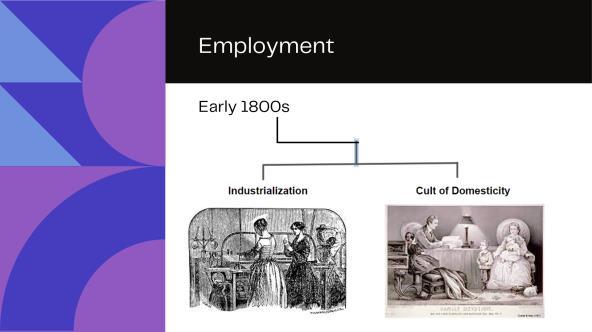





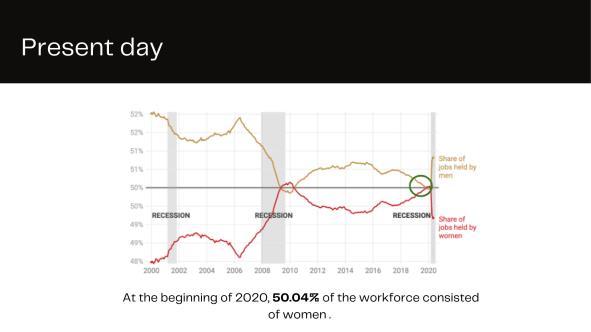

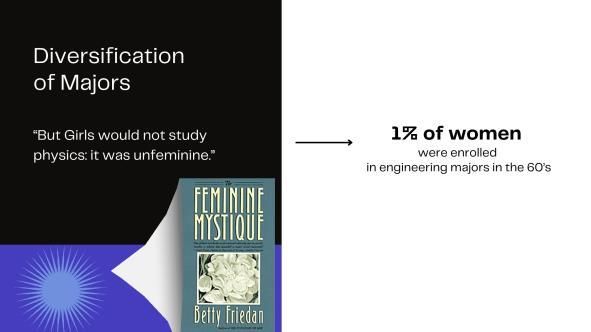










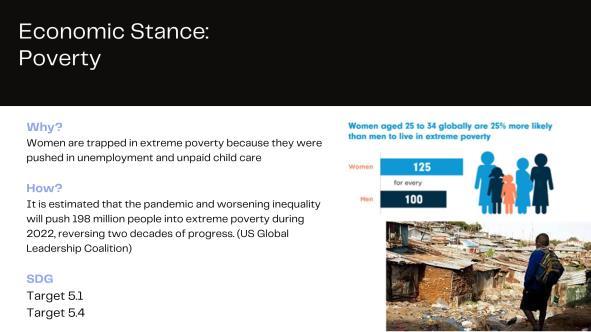






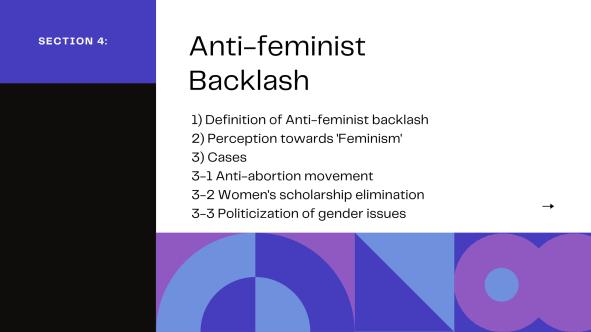
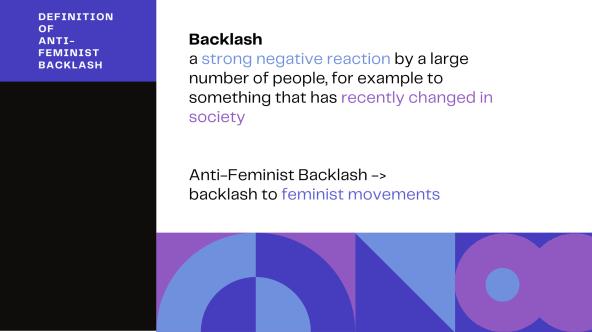




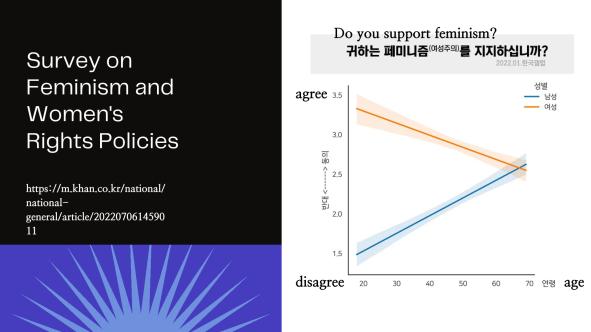










Mountain Cherry Academy, Ahyeon Kim Chungnam Samsung Academy, Chaewon Son Haven Christian School, Eunwoo Song Lycée Français de Séoul, Melania Ryu Korean Minjok Leadership Academy, DaEun Yoo

has been
What can be done for the future

Human rights. This isa broad term but a term that everyone would agree on. This paper would like to talk about human rights, especially the rights and situation of refugees in the status quo. The reason why we chose the topic to specifically ‘refugees’ is because they are in need of desperate help in diverse perspectives. This can be connected to the SDGs that the United Nations propose Goal 2. Zero hunger, Goal 11. Sustainable cities and Communities, etc.

So, to provide a large roadmap, first, this paper will talk about what exactly refugees are, then talk about whyrefugees leave theirhomes andgive examples. Lastly, we will widenthe viewpoint byanalyzing what has been done and providing our own perspective of what we can do.
To begin with, it would be impossible to talk about refugees without knowing what refugees are. Some might simply understand refugees as people who are in danger and want to leave where they live. The definition itself is not wrong, but we have to be more accurate.
What are refugees? Refugees are persons who are outside their country of origin for reasons of feared persecution, conflict, generalized violence, or other circumstances that have seriously disturbed public order and, as a result, require international protection. Then what are migrants? Migrants are not defined in an international level, but is often understood to imply a voluntary process, for example, someone who crosses a border in search of better economic opportunities.
Why should we talk about refugees and migrants at the same time? This is because it is important to differentiate between the two to understand different protection to the two. The purpose of refugees are to move because their country of origin has significantly disturbed public order, and they are protected by the international law. However, the purpose of migrants are just simply changing the main country of residence without significant disturbed public order. The migrants are protected their human rights, such as their right to not get discriminated, but protection such as refoulement, which means to not get arrested because of illegal migration does not occur.
These refugees can also be divided into 6 types; anticipating refugees, semi refugees, impelled refugees, war refugees, expellees, ex camp inmates. Anticipating refugees are people that already have made use of an escape in necessity.

As mentioned above, it is commonly agreed around the globe there has been an increasing surge in the number of displaced people or refugees during the past decade. However, the exact reason for this has been extremely varied amongst different factors such as ethnicity, geographical regions, and more. Nonetheless, I will discuss the five major reasons refugees may be compelled to flee their homes, which are war, religious/national/social/racial/political persecution, hunger, climate change, and gender/sexual orientation based violence.
By the end of 2021, there were 27.1 million people displaced due to war and the number has only been increasing ever since the beginning of new conflicts such as the Ukraine War in 2022. It has been found that refugees displaced due to war are more prevalent to face various problems and dilemmas such as lack of adequate health care, food, housing, employment, clean water and hygiene, alongside loss of community and homes.
Persecution is one of the main reasons people become refugees. It can take place in various forms, namely religious, national, social, racial, or political. The word, “persecution” is mainly used to describe situations when governments fail to protect a person from consistent human rights violations or threats. In countries across the world, this commonly occurs due to a person’s religious or political beliefs or their ethnicity or social group. Some of the prevalent examples of persecution are assainition, torture, violence such as sexual violence, arbitrary arrest, false imprisonment, discrimination or more.
A large number of refugees flee in search of stable food sources, however a majority of these refugees are affected by other factors too, such as persecution or extreme effects of climate change. For example, recently approximately 20 million people in countries such as Somalia, South Sudan, Nigeria, and Yemen have been facing extreme drought duetoclimate change, whichhas ledtomanyrefugees being forced to leave their home in search of stable food sources. Many of these refugees end up in informal refugee camps like the town of Monguno in Northeastern Nigeria with extremely poor conditions.
Recently, climate change has been an immense issue faced by people all around the world, however the people who have been found to be the most vulnerable to this huge problem are those who reside in war stricken or impoverished nations or regions. Also, the climate crisis has made conditions much more difficult for refugees who have already fled from their homes since scarce essential resources, such as drinking water, have become scarcer. Naturally, crops and livestocks which are the only reliable income source for millions of people around the world have been affected too and the climate crisis can contribute to increasing existing tensions and the number of conflicts. However, climate change is yet to be an official nor valid reason to seek asylum. In fact, in 2013, a climate change refugee from Kiribati was refused asylum by the New Zealand High Court.
In 2012, UHCHR updated it’s guidelines to include gender/sexual orientation based violence as an acceptable reason for refugees. Across the globe, it has been found that members of the LGBTQ+ community are more likely to face acts of violence and discrimination such as physical attacks, denial of rights to assembly, discrimination in employment, false imprisonment, torture, and more. Additionally, it has been reported that LGBTQ+ community members are struggling to adjust to their new homes even after they flee.


Hundreds of years ago, as early as the 19th century, thousands left their home countries because of war. This was just the beginning of several refugee legislations and laws that were to come in the following one hundred years. Today, there are numerous numbers of refugee figures forming in countries all over theworld. The consequences ofthreats toward human beingshave brought amass exodusinplaces such as Ukraine and North Korea. These two countries have reached top headlines on news channels for an extended period of time. Why is this? And why is it so significant to our society?
On February 24th, 2022. The whole world was left aghast by Russia’s implacable invasion of regions in Ukraine. After centuries of a difficult relationship between the two nations, Russia decided to take further action. In early February, they sent military troops over to Kyiv but later abandoned its push towards the capital and continued to move to cities in the south and east areas. The invasions heavily impacted Ukrainians. The use of tanks and bombings of civilian infrastructure has caused people to leave their homes and find shelter elsewhere, through news outlets, the world has seen total destruction of infrastructure that were components of daily life, like schools. This left civilians no choice but to leave Ukraine for neighboring countries such as Poland to seek asylum.
The profound number of Ukrainian refugees seeking asylum in other nations is significant. According to the UN, “As of 4 July, more than 5.2 million refugees from Ukraine have been recorded across Europe. More than 3.5 million people have applied for temporary residence in another country.” The BBC reports that more than 1,412,425 Ukrainian refugees are currently seeking asylum elsewhere. Ukraine’sborderingcountry, Poland,hasopeneditsborderwithotherEUnations, leadingtoahighnumber of Ukrainians finding shelter in Poland. The International Organization for Immigration (IOM) have estimated that more women, especially physically vulnerable woman, who are pregnant or have younger children, are being internally displaced to other countries. Under these situations, for months, many organizations have undergone ways to maintain the support of Ukraine. For example, the UN teamed up with several organizations to provide the necessities such as food and cash. There have been many donations and moral support coming from neighboring countries, and from regions on the opposite side of the globe.

For decades, thousands of North Koreans have escaped to neighboring countries such as South Korea and China. But what set off the trigger? North Korea follows a government where legal supremacy is given over other political parties. Thus, for this reason, there are rigorous laws and consistent evidence of humanrightsbeingviolated. Arudimentaryfactor, the freedom ofvoice, like criticizingthegovernment, is banned. This issue became a big reason why many have chosen to escape the country. However, as the world has seen through numerous news headlines, legally leaving the country has been banned. This resulted in millions risking their lives to escape in search of a better life. The constant isolation of North Korea has made technology limited. The media is limited to the extent that the government allows, and it is exploited chiefly to expose the citizens to propaganda. In addition, citizens are given very little news about the rest of the world, it is mostly painted and checked before being released. North Korean defectors have testified that the act of “misconduct” could lead to imprisonment in prison camps. Many were forced into labor, abuse, and starvation. Many North Korean defectors have used the internet to talk about their experiences, and it always wasn’t difficult. A lot have talked about missing a part of their culture.
However, the rising number of immigrants became a profound issue and several organizations started to create systems to support North Korean defectors, in addition to an increasing number of Christianassociationssuch as ‘CrossingBorders.’ Suchorganizations thriveto help NorthKorean refugees seeking help in China through orphan care, training for safety, future stability, and medical support. In 2010, the Ministry of Unification in South Korea established a non profit organization ‘The Korea Hana Foundation (KHF)’ to protect North Korean defectors and receive the appropriate settlement support.
It is not just Ukraine and North Korea that are facing a rising number of refugees. In many places over the world, this is still a major problem, and there are so many reasons that lead up to this. Our society should thrive to become global citizens. Regardless of ethnicity, age, gender, and background, global citizens must become one to support refugees and those in need of help. We all have the right to feel safe and free in our own countries, it is a fundamental aspect of life, and not one country should be excluded from this fact. Wherever we are, it all starts off with profound care for others and spreading awareness.

United Nations protects the human rights of refugees by establishing an independent organization, United Nations High Commissioner for Refugees (UNHCR). Founded on December 3, 1949, the UNHCR was empowered to lead and coordinate international measures to protect refugees and also asylum seekers, stateless people, returnees, and internally displaced people. The UNHCR helps refugees in five directions; protect, respond, include, empower, and solve. Their activities are primarily aimed at protecting the rights and welfare of refugees.
There are two specific policies that UNHCR is working on. The first is the Refugee Resettlement Program. Some refugees cannot or do not want to return to their home countries due to the risk of continuous persecution. Under such circumstances, UNHCR is the safe, realistic, and permanent solution to help resettle third countries.
The resettlement provides refugees with legal and physical protection, including political, economic, social, and cultural rights, at a level similar to that of their citizens. Refugees often resettle in new countries with completely different social structures, languages, and cultures because they have to move to a safe place regardless of their will. Therefore, it isimportant to provide programs tohelp refugees adapt. Government and NGO partners promote social integration through cultural orientation, language and vocational education, and employment promotion programs.
In 2016, UNHCR delivered more than 162,500 refugee files to the resettlement offices. The major beneficiaries of the UNHCR led resettlement program by country are refugees from Syria (77,200), the Democratic Republic of Congo (22,800), Iraq (12,800), and Somalia (10,500).
The second is the Global Compact on refugees, adopted by the United Nations General Assembly on December 17, 2018. It emphasizes the importance of international cooperation to solve the refugee problem in a sustainable manner and stipulates that countries share the responsibility for protecting refugees. The four key objectives of the Global Compact are reducing the burden of refugee acceptance, increasing the economicindependence of refugees, expanding access tothird country settlement measures, and finally helping refugees return home safely and with dignity.

Zaatari refugee camp in Jordan is the representative successful example to help refugees. This camp is a symbol of the Syrian refugee crisis. Ten years ago, Syrians moved to a neighboring country,

Jordan to escape the civil war. The UNHCR set up the camp for Syrian refugees on July 28, 2012. There are still 80,000 refugees living in the camp. The UNHCR has set up fixed caravans instead of tents to provide a better environment for refugees. Refugees are living in a society here. Over 10 years, 20,000 babies have been born, and economic activity has been carried out through 1,800 markets. UNHCR provides free health care to refugees at eight healthcare facilities. The camp is also supported by other UN agencies, NGOs, and the government of Jordan as well as the UNHCR.
Recently, the UNHCR is activein helpingUkrainian refugees caused by the Russo Ukrainian war. Poland was not originally a refugee accepting country, but it has recently received the largest number of Ukrainian refugees. The UNHCR is working with Poland to help refugees.
UNHCR is supporting government led efforts by focusing on protection services, cash assistance, emergency supplies, and reception capacity. As of today, UNHCR has established eight cash enrollment centers in the main refugee hosting areas. Over 100,000 refugees from Ukraine have already received financial supportfrom UNHCR tocover theirbasicneeds, such as payingrent or buyingfood andmedicine.
Now that it has been informed about what has been done and what kind of refugees exist, it is time to explainwhat can bedoneinthe future. The actionspeople take onall levels, whether international, local, or individualistic, all influence the lives of refugees.

As one of the major actors in helping refugees, the United Nations High Commissioner for Refugees (UNHCR) plays a pivotal role. The UNHCR has the responsibility to perform actions such as sending Peacekeepers from the UN to guard refugee camps or providing them with necessities such as food, water, sanitation, and health care.
To protect refugees and resolve refugee problems around the globe, the UNHCR leads and coordinates internationalaction. Byprovidingtransportation assistance and income generating projectsfor refugees, it assists people who move to a new country.
Moreover, UNHCR has longstanding partnerships with donor governments, which provide vital funding each year. Thousands of refugees, internally displaced people, and stateless individuals around the world are protected and saved by UNHCR through these partnerships. UNHCR works with these governments to refine and improve their asylum legislation and procedures according to 10 priorities to reach international standards for refugee protection:


Therefore, the UNHCR continues to work with governments to improve the living conditions of refugees on an international scale.
Furthermore, refugees can receive aid at a local level from governments and associations. Prime ministers and presidents have a plethora of options for addressing the worldwide refugee problem at their disposal. While most governments turn a blind eye, people all around the world are discovering ingenious and unique ways to welcome migrants by using their local networks, abilities, and charity.
The government should first grant asylum to those in need. The process of granting asylum in many countries, such asEgyptand France, takesseveral years. Until their grants arrive, refugees are unable to work at any stable jobs, so they must take on more dangerous and low paying jobs. Additionally, they should allow events to raise money for refugees to be resettled in their countries. Through sponsorships, many refugees are able to arrive in safe countries such as Canada. Despite the fact that more and more countries are preparing to follow suit, many governments still ignore the idea. Additionally, it ought to be simpler to get work, medical, and student visas. For every single person, having a profession is essential. Work permits can help refugees find a job that corresponds to their needs and ensure a healthy income. In nations like the United States, refugees with significant medical issues can also get medical services. Young refugees who are in need of study visas can access global information and pursue an education. Finally, governments should increase resettlement. This is a crucial method that countries may safeguard the refugees whomost requireprotection, suchasthosewho have experienced tortureorvulnerable women. It is a solution that is not utilized enough, though. Approximately 1.2 million individuals required resettlement, yet only 189,300 refugees were given the opportunity in 2016. Only 30 nations now provide this service.
Similarly, associations aid refugees on a local level. They work in their communities to protect, empower, and welcome refugees and displaced people. This is accomplished through tailored health and sanitation programs, as well as educational services. They also provide emergency assistance, safe and secure accommodation for vulnerable persons, and assistance to refugee camps and communities in building capacity. Women for Women International and World Relief are two examples of such organizations.
There are several ways in which a single individual may support refugees. While not everyone is able to help in refugee camps, they may give and provide financial assistance. Individuals may help raise awareness about the difficulties that refugees encounter by organizing fundraisers or local activities. Despite this, some of these folks are students. Students may find it difficult to plan a community event or give large sums of money. So, what can they do? Keeping up with what is going on in the globe about refugees is sufficient for young people. They can also volunteer or give talks at their school. Despite the fact that they are not adults, students are capable of assisting refugees ina variety ofways. Nooneis asking for a single individual to just think about refugees, yet ignoring them is also not an ideal choice.
David Mellon Assistant Professor of Russian and East European Studies, Kathryn. Why Did Russia Invade Ukraine?, The Conversation, 7 Mar. 2022, theconversation.com/why did russia invade ukraine 178512.
“How Many Ukrainian Refugees Are There and Where Have They Gone?” BBC News, BBC, 4 July 2022, www.bbc.com/news/world 60555472
Ko, Stella. “'Beauty IsFreedom': TheNorthKoreanMillennialsWearingMakeuptoRebel againsttheState.” CNN, Cable News Network, 3 Mar. 2020, edition.cnn.com/style/article/north korea womens beauty freedom/index.html.
“The North Korean People's Challenges.” The North Korean People's Challenges, Liberty in North Korea , www.libertyinnorthkorea.org/learn nk challenges
Subramanian, Courtney. “These Are North Korea's 28 State Approved Hairstyles.” Time, Time, 25 Feb. 2013, newsfeed.time.com/2013/02/25/these are north koreas 28 state approved hairstyles/.
United Nations HighCommissioner for Refugees, Burks. “Moldovan GBV Shelter Offers Safetyand aCommunityfor Refugees fromUkraine.”UNHCR,UNHCR,The UN Refugee Agency, 2022, https://www.unhcr.org/news/stories/2022/8/62e916224.html
United Nations High Commissioner for Refugees, Carlisle. “Jordan's Za'atari Refugee Camp: 10 Facts at 10 Years.” UNHCR, UNHCR, The UN Refugee Agency, 2022, https://www.unhcr.org/news/stories/2022/7/62e2a95d4/jordans zaatari refugee camp 10 facts 10 years.html
UnitedNationsHighCommissionerforRefugees.“UNHCRExpandsOperationsinPolandtoReachRefugeesfromUkraineamid Rising Vulnerabilities.” UNHCR, UNHCR, The UN Refugee Agency, 2022, https://www.unhcr.org/news/briefing/2022/5/62908c384/unhcr expands operations polandreach refugees ukraine amid rising vulnerabilities.html.
https://www.unhcr.org/cy/wp content/uploads/sites/41/2018/05/UNHCR_Brochure_EN.pdf
https://www.redcross.org.uk/about us/what we do/how we support refugees#You https://www.amnesty.org/en/i welcome community 2/welcoming refugees solutions/ https://www.un.org/en/global issues/refugees?gclid=Cj0KCQjwuaiXBhCCARIsAKZLt3mcyqhx6PbRSpoPs_tSRGiqI3 7Xg7ScvWYLjLnVwGlaz6bDadjYuoaAuY EALw_wcB
https://asrc.org.au/help refugees/ https://worldrelief.org/refugees immigrants and displaced people/?gclid=Cj0KCQjwuaiXBhCCARIsAKZLt3mqqYeQPcM45ejOec934X9NbqaQkLKdQCnawglgq TsE_mCKUY95c8aAs2tEALw_wcB
https://www.globalcitizen.org/en/content/reasons why people become refugees/ https://www.unhcr.org/climate change and disasters.html
https://www.theguardian.com/world/2016/nov/26/boko haram nigeria famine hunger displacement refugees climate change lake chad

https://www.roads to refuge.com.au/whois/whois_persecution.html#:~:text=Fear%20of%20persecution%20is%20the,actively%20participate%20in% 20the%20violations

https://www.unrefugees.org/refugee facts/statistics/#:~:text=Global%20Trends%20At%2Da%2DGlance,27.1%20million%20refugees


https://watson.brown.edu/costsofwar/costs/human/refugees
https://www.unhcr.org/handbooks/ih/age gender diversity/lgbtiq refugees

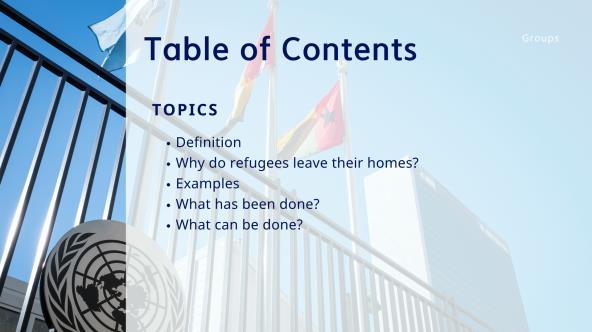














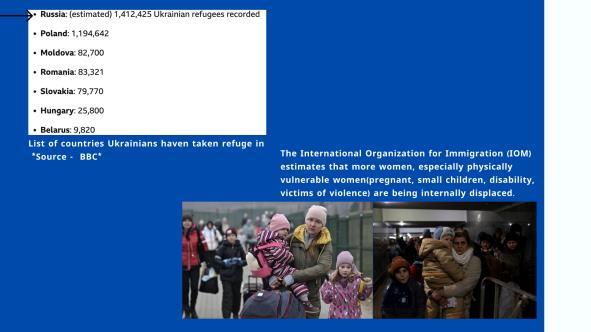



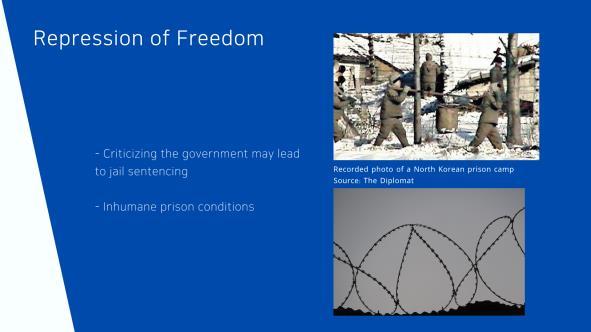













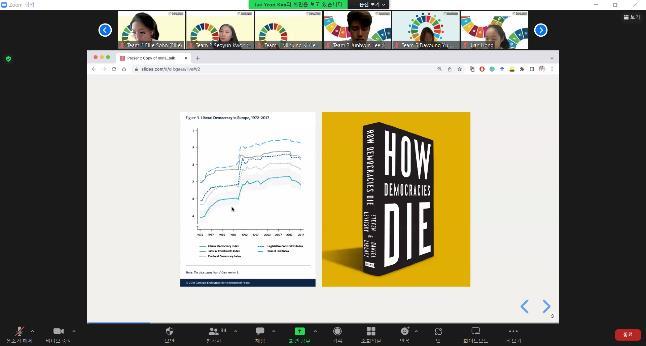


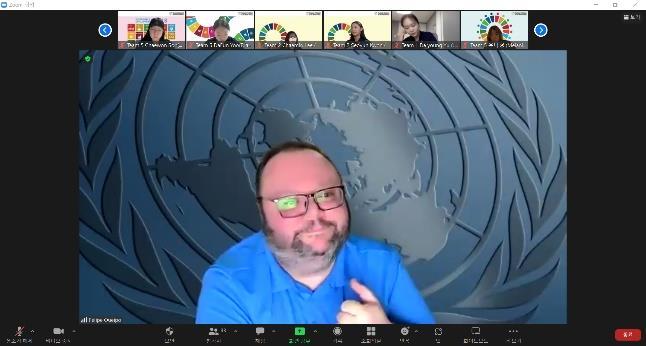


Assistant Professor, Graduate School of International Studies, Ewha Womans University








and Mobilisation Officer at Climate Action Team, United Nations





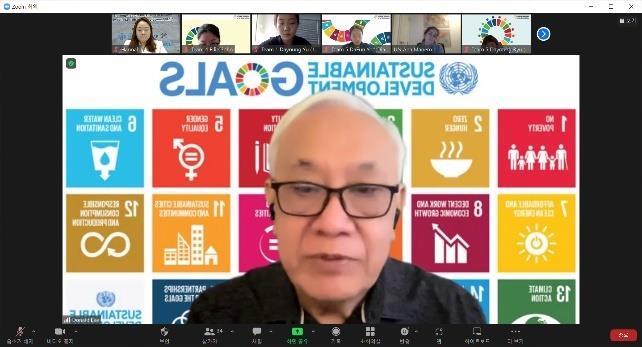













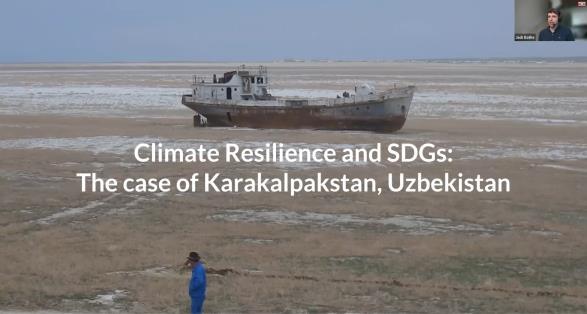








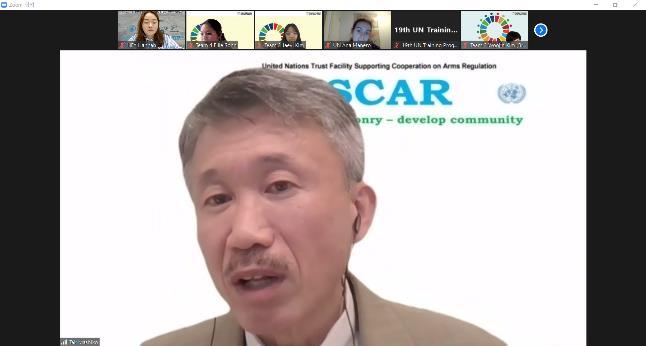


 Seoyun Kwon CMIS Canada
Seoyun Kwon CMIS Canada


We are all equal, and we should always be. We are all born as human beings and will leave as human beings, simple, but yet is the only truth. We all have the right to live, to express ourselves, to pursue what we dream of, to get educated, to believe in whichever god you want to believe, but for some of us, that is impossible.
The concept of war crime has not been around for a long time. The concept itself was first established after WW2 which is famous for the inhumane act against the Jews caused by Nazis. Although it wasn’t only the Nazis who had done war crime (since back then, there was no such thing as a war crime) the reason why theyare the most remembered is because oftheir notorious concentrationcamps. Andthere were three main purpose of these camps:
1. To secure people whom the Nazi government considered as their security threat (Political diffrences, violoation of their belifs..etc). Whom will most likely be kept in thee for the rest of their lives
2. To get rid (to murder) of certain groups and individuals where the justice and law does not reach

3. To expand the ford labour population (to control the labour shortage caused by wars)
Forced labour and mass murder happed in daily basis in those camps. Collected people, who were mostly in a unit of families, were all separated. Kids who were not old or strong enough to work, people who were disabled, people who were too old were sent straight away to the gas chamber, to death. People who passed the so called classification operations were numbered. Numbered people, whowere no longer treated as a human being but just as a “number” were forced to work in horrifying conditions. People starved, froze, and were beaten to death. Some were murdered for fun. There is numerous amount of human rights violation that can be gone on about that were caused by the Nazis.
Crime caused by the Nazis were during the war era which did not yet have a concept of human rights nor war crimes. But there are still concentration camps existing in certain parts of this globe, regarding the fact that nowwe have a veryclear concept of humanrights.The one infamousexampleisChina'sconcentration camps for theUyghurs. Uyghurs whoare well knownas one ofChina’s 55officiallyrecognized minority
ethic groups, live in Northwestern China in the Xinjiang province. Uyghurs are mostly Muslims and they speak a Turkic language.
This region is politically important to China. It gainedashortperiodofindependenceinthe1940s until 1948. Ending the Qing dynasty in 1911, although Xinjiang was a province of the Republic of China, yet Xinjiang was politically independent. In 1949, the Chinese communism party defeated the Chinese Nationalist party. The Xinjiang province (aka. Ghulja Republic) went under the control of the Chinese government. This caused various incidents including terrorism claimed by Uighur extremists all over China. Since then, the chinese authorities see Uighurs as well as other Muslims who lives in the Xinjian province as a terrorist or a potential terrorists.
Starting from 2016, China started to discriminate against these people. By the name of “Making them truly into real Chinese”, the Chinese government sent an estimated number of one million Uyghurs to concentration camps. The Chinese government claims that these camps are not forced to be in, and the people in there are living the best of their lives, getting well educated and well fed.

But in reality, in these camps, the Uyghurs are forbidden to speak their own language and believe in theirreligion.TheyareforcedtolistentoXiJinping’s lectures for hours and sing patriotic songs. Families are separated, and still hundreds of people do not know what happened to their relatives. People in there are forced to labour and if they disobey the Chinese government, they are brutally tortured. People were strapped to so called “tiger chairs”, electrocuted. Women survivors reported stories of sexsual abuse as well, including rape and forced sterilisations. Some security footage shows hundreds of people in one of those camps kneeling down blindfolded, getting their hair shaved off, then being led to the train.
Human rights investigators say that this act is a slow process of the government trying to erase the cultural identity of the Uyghurs and other Muslims as well as reducing their population who are living in Xinjiang province.
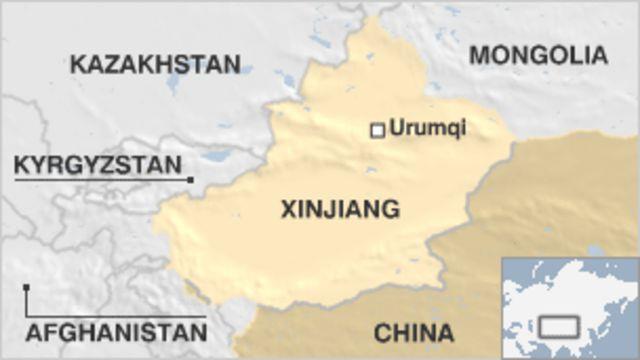
“On arrival, I was stripped naked and was asked to change to a yellow uniform. I was forced to get a urine test to check if I was pregnant: if so, I would be taken to the hospital for forced abortion” (Gülbahar Jalilova, Uyghrus camp survivor).
On May 22 2017, Gülbahar Jalilova, originally from Kazakh who is a Uyghur businesswoman, was arrested by the Chinese authorities during her business trip in China. She was imprisoned for 16 months in one of the concentration camps. Gülbahar Jalilova claims that along with unhygienic conditions, there was a lack of resources such as food or water. She also reported various cases of sexsual abuse that happend there.
China being one of the most powerful and influential across the globe as well as in the United Nations, have been violating the UN agenda for protecting human rights. In July 2019, twenty four countries sent a

letter to the Human Rights Council president with hopes of the UN high commissioner for human rights to monitor and report all human rights violation acts that happened in XinJiang, which were claimed to have happened in those camps by those who survived. The Chinese government responded by a letter signed by 50 countries, including North Korea and many other countries with recorded amounts of numerous human rights violations.
In November 2019, a similar thing happened as well, and again China responded with a letter signed by 54 countries.
The Chinese government is denying the accusations from twenty four countries even until now. When this issue was first brought up onto the table of global society, it was issued and considered as a serious crime. People were speaking up, stories of survivors were in newspapers, interviews..etc. But it wasn't long until we became ignorant to this case, news channels and reporters seeking for more sensational and hot issues.
Another famous exampleofmodern day concentrationcamps is located in North Korea. North Korea or Democratic People’s Republic of Korea (DPRK), is famous for dictatorship and nuclear weapons. The DPRK strictly controls their citizens. Citizens from the DPRK have to obey the government. All citizens should have a painting of the Kim family in their living room, and they have to keep it perfectly clean, or else they will get arrested.
There are stunningly many ways to get arrested in the DPRK. This includes:


Having relatives that said bad things about Kim’s family
Having relatives who ran away from the DPRK …. Etc

The DPRK has a punishment so called the three generation punishment, which means that if one of your family members ran away from the DPRK to another country, or one of your family members disgraced the Kim family, including the members who did nothing wrong will get punished for three generations.
Allfamilymemberswhenarrestedaresenttoprison(concentrationcamps). Peoplewhocommittedacrime against the Kim family or who disgraced them are sent to political prison. The DPRK’s political prison is famous for never being able to escape, even after death, because all prisoners will get buried within the camps.
The moment they step into those camps as a prisoner, they are nolonger treated as human beings. All people including underaged childeren are forced to work. If they refuse to work in any conditions including being overaged or pregnant or disabled, they are severely beaten, often even to death. Overtime, people become severely underweight because they are unable to eat nutritious food. Many survivors stated that they had to consume dirt or grass since all rats and snakes were gone because they ate all of them. Some women were raped to guards, and for their scilence, the guards who raped them often give them some rice or something to eat. However guards sometimes killed the women who they raped, because they might get punished (although it is not even that severe punishment) by doing this kind of act.
Womens who are pregnant were forced to give up their child. The way of abortion in the DPRK concentration camps are truely inhumaine. When the pregnant woman lies down, a piece of wood is placed on her abdomen. On top of the each side of the wood, one prisoner (likely to be relatives) stands on top of it and jumps until the woman miscarriages her child. During this process, the mother of the child can die as well because of the shock and the pain. If the baby manages to survive, the guards will kill them. Some survivors witnessed a guard drowning a newborn child.
One of the ways the guards torture prisoners are to keep them sit cross legged for up to 12 hours a day, maintaining complete silence. If they move even an inch or make a slight sound, they will get harshly punished.
People were killed for fun. If someone stole some crops they have been growing for the government, they will get killed. In DPRK camps, people are killed in various, cruel ways. Some are “fed” to guard dogs that are trained to eat human flesh. Some are tied, and thrown rock at by prisoners until they pass away. If they are killed by a gun, the guards make them dig their own grave.
Although there is an obvious evidence of the DPRK infringement towards the human rights, the DPRK is a country without almost any diplomatic actions, which makes it harder for the global society to help the people who are in possible danger of violence, sexsual abuse and torture that are happening within the nation, specifically inside the concentration camps.



“I believe that the conditions in the [North] Korean prison camps are as terrible, or even worse, than those I saw and experienced in my youth in these Nazi camps and in my long professional career in the human rights field” (Buergenthal, victim of the Nazi’s concentration camp Aushwitz and Sachsenhausen along with the ghetto of Kielce, Poland.)



The Syrian civil war, currently ongoing for over ten years, was first started by a peaceful anti government protest by the people who wanted to end the dictatorship of Assad's regime that started in Dara (southwestern part of Syria). Anti government protests spread all over the nation. The government repressed the civilians with violence, using military powers.
Civilians who were arrested were sent to prisons. From the start of the civil war to 2022, 14,537 individuals were lost due to torture caused in prisons. People were tortured when interrogated. They were slapped, kicked, electrified, nails pulled out, choked until they had to admit what they had not done. If they continue to deny the charges, the guards will torture them even more severly.
People witnessed a 15 year boy getting his teeth smashed by a grenade. Guards sprayed insecticide, setonfire, wrappedthebodywithgauzeandpeeled the gauze, lifted skin with a blade to a young boy. Guards will make prisoners sing to make sure they are alive, while cutting their faces with a razor or a blade. They will drill a hole in people's eyes with a screwdriver, drill neck and chest with a power drill for fun. People were forced to be pushed in tires in a foetal position, getting whipped. Guards forced people to eat dead mice.
There was sexsual abuse everywhere. Every night, one or more women (often underaged) were chosen by the guards. The women chosen were raped. People thought that they were gettingintegrated, but after they came back they refused to speak about what happened. In order to force out what they want to hear, male’ genitals were cut off. Both men and women were raped, often in front of their family members to force out confessions.
People were also hanged and executed in these prisons as well. The so called trial they received was only about two minutes long, without any lawyer or their own say. On the day of execution, guards take out prisoners who will be executed and tell them that theywill be transferred to the civilian camps which have better conditions than where they are right now. But, they in fact take them to the basement cell, beat them up severely. People do not know that they are being hanged until the rope is placed under their necks.
There are several parties that participated in this civil war, but none of them provides ethical procedures or environments for their prisoners. There are still tens of thousands of people missing, their family members still not knowing what happened to them.
It was like a part of my soul died… After that, I had no joy, no laughter (Student subjected to electrocution, Syria).
“13 years of death, anxiety, and fear every day. Inside (the prison), I was just thinking when will I die and be saved?” (Mustafa, survivor of the worst Tadmur prison for 13 years after being arrested by the forces of Hafez al Assad regime in 1987).
74 Year have passed since the universal declaration of human rights has been published. And there are still hundred thousands of people being brutally tortured by their own governments. The examples mentioned above are still ongoing problems. Yet, there still are people who do not know what happens inthese places. Governments are hiding their acts, blinding citizens and global society. Acknowledge the problem, spread awareness, make voices.
We all have the right to be free.
“About the Camps.” North Korea’s Hidden Gulags, www.nkhiddengulag.org/about the camps.html#:~:text=Once%20imprisoned%2C%20these%20North%20Koreans. Accessed 26 Aug. 2022.
Arablouei, Ramtin, and Rund Abdelfatah. “Who the Uyghurs Are and Why China Is Targeting Them.” NPR.org, 31 May 2021, www.npr.org/2021/05/31/1001936433/who the uyghurs are and why china is targeting them


Bicker, Laura. “Beatings and Forced Abortions: Life in a North Korea Prison.” BBC News, 27 Mar. 2022, www.bbc.com/news/world asia 60870739
Boissoneault, Lorraine. “Is China Committing Genocide against the Uyghurs?” Smithsonian Magazine, 2 Feb. 2022, www.smithsonianmag.com/history/is china committing genocide against the uyghurs 180979490/.
“China | Uyghur Camp Survivor Reminds UN of Duty to Urgently Start Remote Reporting.” International Service for Human Rights, 25 June 2021, ishr.ch/latest updates/china uyghur camp survivor reminds un of duty to urgently start remote reporting/. Accessed 26 Aug. 2022.
Dillon,Michael.“AUighurs’HistoryofChina|HistoryToday.” Historytoday.com,2020,www.historytoday.com/archive/behind times/uighurs%E2%80%99 history china “End the Horror in Syria’s Torture Prisons.” Www.amnesty.org, www.amnesty.org/en/latest/campaigns/2016/08/syria torture prisons/.
Evans, Stephen. “North Korea’s Prisons: How Harsh Are Conditions?” BBC News, 14 June 2017, www.bbc.com/news/world asia 40269546.
Facing History & Ourselves. “The Targeting of Uighur Muslims in China.” Facing History and Ourselves, 4 Feb. 2022, www.facinghistory.org/educator resources/current events/targeting uighur muslims china.
Fifield, Anna. “NorthKorea’s Prisons Are as Bad as Nazi Camps, SaysJudgeWhoSurvived Auschwitz.” TheWashingtonPost, 12 Dec. 2017, www.washingtonpost.com/world/asia_pacific/north koreas prisons are as bad as nazi camps says judge who survived auschwitz/2017/12/11/7e79beea ddc4 11e7 b2e9 8c636f076c76_story.html
Human Rights Watch. ““Break Their Lineage, Break Their Roots.”” Human Rights Watch, 19 Apr. 2021, www.hrw.org/report/2021/04/19/break their lineage break their roots/chinas crimes against humanity targeting
Karaahmet, Ahmet, and Mehmet Burak Karacaoglu. “Syrian Man Recalls Incarceration Horror in Regime Prisons.” Www.aa.com.tr, 25 June 2022, www.aa.com.tr/en/middle east/syrian man recalls incarceration horror in regime prisons/2622700. Accessed 31 Aug. 2022.
Kayyali, Sara. “Al Mezzeh Prison in Syria Caught in a Torture Chamber Salem’s Story.” Www.refugee.today, 1 Apr. 2022, www.refugee.today/torture/al mezzeh prison a torture chamber. Accessed 31 Aug. 2022.
Kuo, Lily, et al. “Why More than 1 Million Uighurs Are Being Held in Camps in China Video Explainer.” The Guardian, 24 July 2020, www.theguardian.com/world/video/2020/jul/24/why more than 1 million uighurs are being held in camps in china video explainer
Maizland, Lindsay. “China’s Repression of Uyghurs in Xinjiang.” Council on Foreign Relations, 1 Mar. 2021, www.cfr.org/backgrounder/chinas repression uyghurs xinjiang
McCurry,Justin. “North Korea Detainees Subjected to Ritual Torture and Sexual Assault RightsGroup.” TheGuardian, 19 Oct. 2020, www.theguardian.com/world/2020/oct/19/north korea detainees subjected to ritual torture and sexual assault rights group
Sevencan, Seda. “Syrian Torture Victim Recounts Cruelty in Hafez Al Assad’s Regime Prison.” Www.aa.com.tr, 26 June 2022, www.aa.com.tr/en/life/syrian torture victim recounts cruelty in hafez al assads regime prison/2623001. Accessed 31 Aug. 2022.
“Survivors of Syrian Prisons Share Stories of Death, Horror and Torture.” TRTWORLD, 13 Dec. 2020, www.trtworld.com/magazine/survivors of syrian prisons share stories of death horror and torture 42322
“SustainableDevelopment Goals| UnitedNationsinChina.” China.un.org, 2022, china.un.org/en/sdgs.

“TheTenthAnnualReport onTortureinSyriaontheInternationalDayinSupport of VictimsofTorture SyrianArabRepublic.” ReliefWeb, 26 June 2021, reliefweb.int/report/syrian arab republic/tenth annual report torture syria international day support victims.
United States Holocaust Memorial Museum, Washington, DC. “Concentration Camps, 1933 1939.” Ushmm.org, 2018, encyclopedia.ushmm.org/content/en/article/concentration camps 1933 39.
 Korea International School Jeju
Korea International School Jeju
Consideringall the classesthat Iparticipatedinthroughout thewholecamp, this particular session about Urban Development was very interesting and encouraged me to do extra research on the parts that I wanted to learn more about. The whole session was mostly about explaining thepicturesthat sheprepared andshealsoincludedstoriesandartworksthat explainthedifferencebetween Urban and Rural areas while the Urban development was actively moving on.

According to the session, Urban development is the term used to describe the processes that lead to the political, cultural, financial, and architectural development of cities. Urban growth is an increase in the total number of people living in a city. Throughout the centuries from the time when the first civilization was grown and when the first infrastructures were grown with the technologies, the Urban areas started to grow and increase the scale of basically everything that is included. The scales of buildings (skyscrapers), population, numbers of stores, houses, and anything that people can see if they walk outdoors and visit the city. All the technologies were not developed just physically but also developed in software, so they became more efficient when it is supporting humans.
The cities now are called Neoliberal cities. It is losing human scales because it is only thinking on market. This means most human beings, which have a role to give birth to the next generation, are only thinking of economical things and themselves, whichis creatingthe decreasing scale of the human rate in the Urban areas and only the growth of the market with the technologies.

Compared to the Urban areas in the past, the purpose and goal are clearly different. In the past, the purpose of the development of the Urban society was to create a community and territory for humans to stay safe and feel comfortable. So, they can create relationships with each other and communicate and collaborate with each other. The clear goal was to build a positive relationship and community. However, it is clearly changed nowadays. People are more focused on objects, not the society’s development they can achieve within their actions. By ‘object’ it doesn’t only means the actual physical things that we are able to touch, however, it means the things that are achieved inside the society and things that are representing the whole class, school, and the world.
Compared to the Urban areas in history, the structure of how Urban and Rural areas are mixed is also very interesting. Back in the old days, the Urban and Rural areas a separated. They had a clear line between them thatis showingthe outline of the Urban areas and the point where Rural areas are starting. It is clearly showninthepaintingsthattheartistsmade duringthetime whentheUrban andRural areas were separated. Eventhough they didn’t live very far away from each other, and they weren’t alive too far away from each other, their drawings were completely different. On the other hand, in modern days, the format of Urban areas and Rural areas are combined into a new type of land that contains the benefit of both areas to create support for agriculture.



The first technological development within the agricultural development was going on in Rome. Romulus and Litmus, two brothers, fought over one land. Romulus won the right, so the empire was named after him, Rome. Romulus decided to separate the areas in his land, Urban (where citizens will be crowded and develop the technologies with all theshops,markets, andhouses, fromnaturewhich is called Rural. Rome’s technology was very developed, especially technologies that were related to farming (agriculture). They had technologies to bring the water from Rural areas to the Urban areas of the city and they were also able to build a unique shaped buildings with lower quality materials. Those infrastructures that Rome’s citizens made are getting awards and being honored.
Within the growing technology and infrastructure (agriculture), trade was also controlled by Rome. Rome was connected to all the roads that countries used to trade with one another and Rome was able to lead them because they were strong and developed.
Rome had a clear relationship between Urban territories and citizens. The urban areas are there to support the citizens and provide them with a safe shelter to live inside. This was clearly shown in the paintings of the Rome artists who drew the picture of Urban areas of Rome, which were providing safe territories to the citizens inside.

One point that I was really engaged about is the part about the difference in the life of the high class and the low class of society. Even though the Urban areas are developed so much with very high buildings and successful marketsofeconomics, therewerestill peoplewhoweresufferingfromhunger. Just afew meters, the thin wall is hiding the reality of the poor from the high class society members. Within that picture, something started a fire in my heart. I started to find ways I can support the low class society members that we can help. It was a chance to think again about Urban development, as a citizen who is also living in a place where it was a forest but is now full of schools and academies. And it was an opportunity to consider the ways that we can support the low class society members and use the merit of Urban and Rural wiser than the current technology, that will care about all citizens living on the Earth.


The UN was a constant fountain of interest. With the integration of numerous areas ranging from social issues and economy to medical and scientific areas, the lessons were a life opportunity to delve into areas that I am currently familiar with, and further enlarge the accumulation of knowledge I lack.
As an individual deeply mesmerized and questioned by the constant battles and conflicts between continents and countries based on territorial borders, cultures, religion, etc., the topic of data science and the relations to government was a specific topic that lingers in my head. Mentioning the governing patterns and ideals of countries, he pinpointed the ideals of democracy, contrasting it to technocracy, a governing system which is ruled by a minority of elites. I instantly recollected instances where I had debates on the Republic by Plato and World Order by Henry Kissinger. Democracy, while perceived as an abstract concept of realism which is constantly rebutted by the lures of theocracy, the illusions of the perfection of theocracy was severely demolished by the speaker’s words. I knew instantly what he was saying, and the topic amused me.
Furthermore, I would like to comment that the numerous sessions where student interns and college students spoke regarding UN careers was one of my favorite classes I have taken. It was a place where I, a rising senior, learned more about the college process as well as the characteristics of each individual college. A session where students could freely ask questions and gain answers regarding their future internship experiences, careers, undergraduate colleges and grad schools, and the process of preparing for college was a enlightening conversation and I have learned much more than I have expected.
The UN sessions was a life time experience, something I have never taken but also a delightful experience where I gained much more than lost.



The five day UN Training Program has been one of the most interesting and fascinating experiences in my academic life. While all the lectures were extremely informative and heavily impactful on my views and perspectives around the current world, one lecture by Ms. Carine Valarchéabout climate migration hasstayed withme the most. Duetothis, I have been motivated and encouraged to research the climate crisis and migration. In the following report, I will discuss three possible solutions that I have found throughout my research that I frankly believe can help mitigate the impacts of climate migration.
Climate migration is the displacement of people due to the climate crisis or disasters. Climate displacement can take form in a plethora of ways such as earthquakes, droughts, extreme rainfall, floods, submergence of land due to rising sea levels. Currently, climate migration is fastly becoming one of the most crucial and alarming issues of our times. It has even been speculated that “The Great Climate Migration” has finally begun. Recently, in the status quo, the vast increase in climate migration has led to the displacement of approximately 21.5 million people annually and it has been predicted by the international think tank, IEP, that there will be around 1.2 billion people displaced globally by the year 2050 due to climate and natural disasters.
According to an article by the New York Times, as of 2020, around 1 percent of the world has become an uninhabitable hot zone. While this number alone is surprising, this number could rise to an immense 17 percent, which means that only 83 percent of the world would be considered livable in mere 30 years. And the millions, or more accurately billions of people who will call these places home will be displaced, forced to flee their home.

Firstly, countries can help mitigate climate displacement by joining hands and forces to instigate political will. If used correctly, political will can become a powerful incentive since political willpower is one of the first steps for change. While it is true that the UN, academic experts, international communities, activists, everyday civilians can warn and inform individual countries, what can really drastically change and directly tackle the issues is national governments. What I believe to be an important step in this direction is the G20 Complication of National Practices. Through this, the IDMC is planning on showcasing the best and most innovative solutions and ideas from national governments on how to tackle and end climate displacement.
Besides joining hands to mobilize political will, an additional way to mitigate climate migration can be promoting and encouraging community action. Encouraging community action can take form in a myriad of ways but it mainly refers to putting communities in the center of the action. Many often do not realize that increasing community action can essentially raise awareness of their risks and how to prevent them by their increasingly active participation in procedures. In addition to this, centering communities in action can greatly boost morale. For decades, for preparedness and prevention in a wide variety of issues, the most common response tended to be turning to experts or specialists. While these well polished knowledge and information are also extremely helpful and valuable, promoting and encouraging community action is crucial. An example that showcases the effectiveness and long term positive impact of centering communities in action is the community mapping project Ramani Huria in the Tanzanian city Dar es Salaam. According to its official website mentioned in the references list below, it has “highly accurate maps of the most flood prone areas of the city,” and “their benefits have multiplied and their potential magnified, now serving as foundational tools for development within all socio economic spheres beyond flood resilience,” by “train[ing] university students and local communitymembers to create highly
accurate maps of their city using a wide variety of methods for data collection.” This demonstrates the fact that such actions can indeed help mitigate climate mitigation.
Lastly, recognizing the relationship between conflict and climate change will certainly benefit the process to reduce the impacts of climate migrationand displacement. It hasbeen found that scarcity or lack of resources caused by climate change or disasters can cause or even amplify existing tension. Onthe other hand, it has been discovered that destruction or damage on farmland or infrastructure caused by conflicts can increase risk and vulnerability. Also, when conflicts and climate disasters synchronously occur, refugees who have already been displaced could be forced to flee again. One example of this is when the floods caused by extreme rainfall in Yemen in 2020 led to further displacing IDPs (Internally Displaced Peoples) who were already fleeing from Yemen’s conflict.
It is often said that mitigating mass climate migration and displacement is an impossible feat. However, if member states of the United Nations adapt to various new changes and challenges and adopt the solutions delineated above joining forces to build political willpower in individual national governments, maximizing community action, and recognizing the relationship between conflict and climate change it would allow for the once believed dream to turn into a reality.
https://www.zurich.com/en/media/magazine/2022/there could be 1 2 billion climate refugees by 2050 here s what you need to know#:~:text=These%20numbers%20are%20expected%20to,climate%20change%20and%20natural%20disasters https://ramanihuria.org/en/
https://www.zurich.com/en/media/magazine/2022/there could be 1 2 billion climate refugees by 2050 here s what you need to know#:~:text=These%20numbers%20are%20expected%20to,climate%20change%20and%20natural%20disasters

https://www.nytimes.com/interactive/2020/07/23/magazine/climate migration.html

 Canada Maple International School
Canada Maple International School

One major ideal seems to be shared among countless privileged people poor people need our help. Any lecture I listened to in school about volunteer work made it seem like people in developingcountries needed the help of random teenagers to eradicate poverty. I always thought that humanitarian trips helped developing communities to thrive, which was the farthest thing from the harsh truth. I was shocked when this widely accepted sentiment was completely overlooked by The Justice Desk, a nonprofit run by Jessica Dewhurst.
The Justice Desk is based in South Africa to teach and empower local citizens about their human rights. During the seminar that CEO Dewhurst gave, she kept repeating the phrase “empower.” Most of the time, in the seminars I listened to, the word “empower” was used towards the audience rather than the people in need. However, after this lecture, I realized that the underlying principle of privileged people thinking that underprivileged people need their help to improve their life conditions is extremely flawed. Here’s a specific example of how this can be harmful to developing communities. Let’s say there was a volunteer group that sent teenagers to developing countries to build houses nothing seems like an issue, right? However, most of the time, citizens in those communities are more knowledgeable when it comes to construction than teenagers. On top of this, the volunteers are encouraged to deny locals who want to take part in the construction. This creates an environment where the locals aren’t encouraged to be self reliant but rather that they need help. Not only will this instill a sense of self doubt in one's ability to provide for oneself, this can cause those communities shame that they need help from other people from foreign countries in order to improve their situation. After constant research and volunteer work, I realized that the volunteer work I was doing to “help the poor people” was in fact helping me feel better about myself than actually helping those communities. This is why I believe that empowering the developing communities is incredibly vital in creating a system where locals can feel more independent and improve their situations long term, without the help of any countries.
The work done in The Justice Desk is based more towards activism than volunteer work, but I still think the idea of empowering the locals is perfectly executed in this organization. The Justice Desk’s main mission is to educate South Africans on their rights. Educating the citizens can help them understand how and in what areas they should act in their communities. Most importantly, since normal people are taking a stand independently, without the help of people from other countries, they will feel a sense of pride and accomplishment in the activities they participate in. Most volunteer groups tend to do work that is not able to be sustained once they leave. For example, building houses can help out temporarily, but nothing was done to make sure that the locals could continue improving their economy. If the locals are educated, they can keep a sustainable cycle that won't die down once a group of people leave.
Why is this bad for developed countries? In developing countries this can create a saviorist mentality. This is essentially when privileged people believe that they are responsible for “saving” underprivileged people. I realized that this sentiment had been unconsciously taught to me ever since I was a child. A constant repetition of those remarks led me to think that underprivileged people depend on my help to improve their life. This is obviously a toxic mentality that is dangerous to both privileged and underprivileged communities. There is a term coined to describe this phenomenon white saviorism. On top ofmostly white peoplethinking that underprivilegedgroups needtheir help, they usethose experiences to increase their moral confidence. If those people post pictures with random kids from a poor community and share what they did to help those families on social media, they will feel better about themselves. Essentially, the work they are doing to “help” those certain communities is actually helping themselves more.
CEO Dewhurst also touched on many different campaigns and projects that the non profit has taken on during her lecture. First off, they have trained over 263,452 everyday activists who are able to create their own change in their communities. They also launched a project called the Mbokodo Project, which gave young girls, who are survivors of rape and violence, mental health support. Ontop of this, they recently launched The Ntsika yeThemba Project whichgives young boys without any father figure, a male role model and human rights training. I personally think this project was the most touching to me because I feel like in our society there is still a big taboo with being a feminist. However, I feel so safe learning about prgrams and organizations like this because they acknowledge toxic masculinity and are not scared to call themselves feminists. There are so many more projects that the organization has initiated but one thing I could take away from all of the projects was that it was for the community and carried out by the people in the community. I just felt like the organization was empowering people in such a healthy and mighty manner, which I feel will bear so many fruits as the years pass by.
Furthermore, CEO Dewkurst described the country andits citizens with pride but still with a sense of responsibility. She would describe how the laws in South Africa look good on paper but are actually applied in the real world differently. This helped me to understand why the organization takes on specific projects. For example, CEODewhurst describedthatthere were taxes added onto femalesanitary products. So, the organization launched a project to try and eliminate those taxes which they ended up doing!! I also, for most of my life, have been fed this idea of countries inside of Africa being poor and needing our help. But, after listening to CEO Dewhurst describe local citizens taking on these huge activism stands, I realized that people in developing countries are not reliant on developed countries. This really helped me to change my view about volunteer work and my toxic view of developing countries.
In conclusion, the lecture that CEO Dewhurst gave left a big impact on me. Not only did I learn about South Africa and The Justice Desk, I got to witness what healthy and sustainable activism in developing countries looks like. In the future, I hope to be able to take part in an organization like The Justice Desk, or better, create my own non profit organization!
https://www.brookings.edu/essay/the history of womens work and wages and how it has created success for us all/ https://time.com/5851352/women labor economy coronavirus/ https://www.history.com/news/women world war ii factories photos https://www.thoughtco.com/cult of domesticity 4694493 https://www.cfr.org/blog/landmarks global movement womens rights timeline https://www.globalpeoplestrategist.com/4 countries with the best parental leave laws/ https://www.forbes.com/sites/naomicahn/2022/03/31/news on the gendered wage gap and covid 19/?sh=4e5d71cb3e4e https://rapecrisis.org.uk/get informed/statistics sexual violence/ https://www.rainn.org/statistics/victims sexual violence https://www.who.int/teams/sexual and reproductive health and research (srh)/areas of work/female genital mutilation/prevalence of female genital mutilation
https://www.healthassured.org/blog/women s mental health the statistics/ https://www.statista.com/statistics/666461/mental health treatment counseling past yearus women/ https://www.postpartumdepression.org/resources/statistics/ https://www.weforum.org/agenda/2021/04/covid 19 has harmed girls education here s what needs to be done https://www.bigrentz.com/blog/women in stem statistics


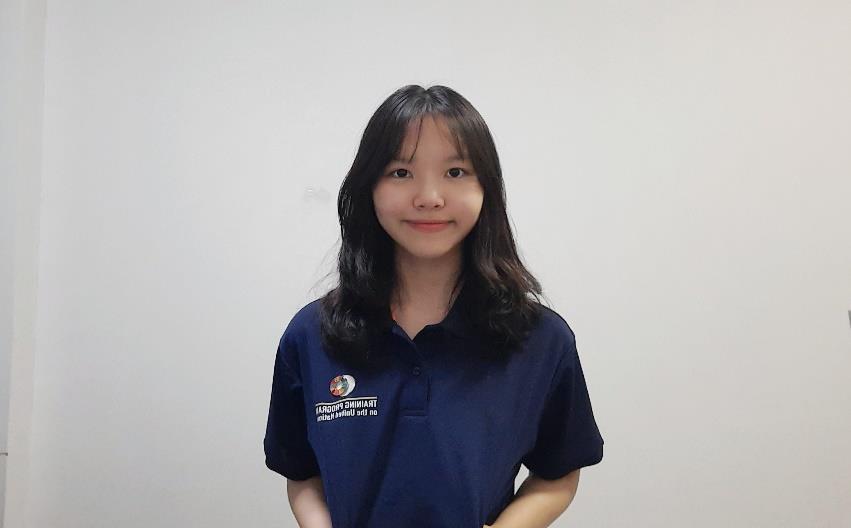
About 90% of alldata was generated between 2019 and 2022 this period of three years accounts for just 10% of the Internet's history since 1983. The number of business applications peaked 5.4millionin2021, andInternetof Things(IoT)investments are projectedtogrowby14%in2022. Profuse sectors are facing extensive leaps in development, and the realm of globalization catalyzes this growth. Ironically, human right alleviation is not as exponential and significant as industrial revolutions. An inherent convention that supports the basic rights of individuals, human rights are spread internationally to enhance environments for social interaction.
With a solid goal of eradicating injustice and elevating the quality of life of every indigenous person, human rights preserve their dignity, and the value of existence is viewed as a natural attribute of all humans. Asfrontiertechnologyanditsimpactsreach outtothemostisolatedmarginalized communities, a solid question must be addressed: how can innovationbe balanced with equity to alleviate human rights?
Injustice is the sole cause of the hindrance to human rights, acting as the starting point of poverty, discrimination, sex crimes, human trafficking, murder, labor exploitation, and more. Firstly, poverty is an inveterate humanitarian issue that has been impeding human rights for millenniums. Poverty causes over 55.3% of the global population to lack access to basic necessities such as housing, water, food, clothes, healthcare, and education. Poor education qualifications handicap individuals in the job market, leading to low income andlow qualityof life. Thiscreates a chronic vicious cycle of poverty, thusitishighlyarduous for persecuted minorities to climb the social ladder. Consequently, poverty is allocated as the first Millennium Development Goal(MDG) that needs to be tackled.
Secondly, violence and abuse are also a form of injustice that is usually intensified by discrimination. Despite strengthened regulations and laws, violence is prevalent in the blind spots of society. For instance, domestic violence has increased by 30% amid the COVID 19 pandemic due to frequent lockdowns and social discontinuities. Violence and warfare against children is an endemic dilemma in conflict zones such as Syria, Libya, and Iran. Until 2018, a total of 1.5 billion children have ever lived in conflict affected countries. As much as public diplomacy and political relationships are intensified, war occurrence is at its peak ever since the establishment of the United Nations. The consequential problems of war are also not negligible, such as sexual violence, human trafficking, forced migration, and labor exploitation of children.


Lastly, inequality and discrimination are other fundamental human rights issues. Discrimination is evident in gender, social hierarchies, race, and other social stances. In South Africa, 1 woman dies every 6 hours, and 1 in 3 girls are raped in their lifetime. The independence of women is not encouraged by society due to strict gender roles, toxic masculinity, and social stereotypes. Apartheid has been rooted in society for centuries and was only brought into the spotlight globally through the #blacklivesmatter movement, which was continued by rising Asian hate since the eruption of the COVID 19 pandemic.
Urbanization also plays a role in worsening inequality. People migrate from small cities to large conurbations, leaving large cities will continue to thrive while small stores in rural areas are neglected. Increasing costs of living, inflation, and the marginalization of disadvantaged populations in social and technological development are also rising inequality.


The first step to mitigating injustice and flourishing human rights is empowering people. A human rights activist in South Africa, Jessica Dewhurst has established the Justice Desk foundation which advocates human rights through the empowerment and education of youth. The Youth Ambassador’s Project of Justice Desk recruits aspiring teenage global leaders, educate them as young changemakers, and propels large scale advocacy campaigns annually to inculcate the importance of human rights.

Social campaigns and awareness raising projects play a key role as a vessel to connect the young changemakers and individuals of South Africa. Each project is equipped with the passion and vociferous ambitions of youth ambassadors, such as the “End Gender Based Violence(GBV)” movement. As female representatives promote the eradication of gender based violence and male representatives stand up to abolish the tampon tax and eliminate toxic masculinity, an inclusive, active community is formed.
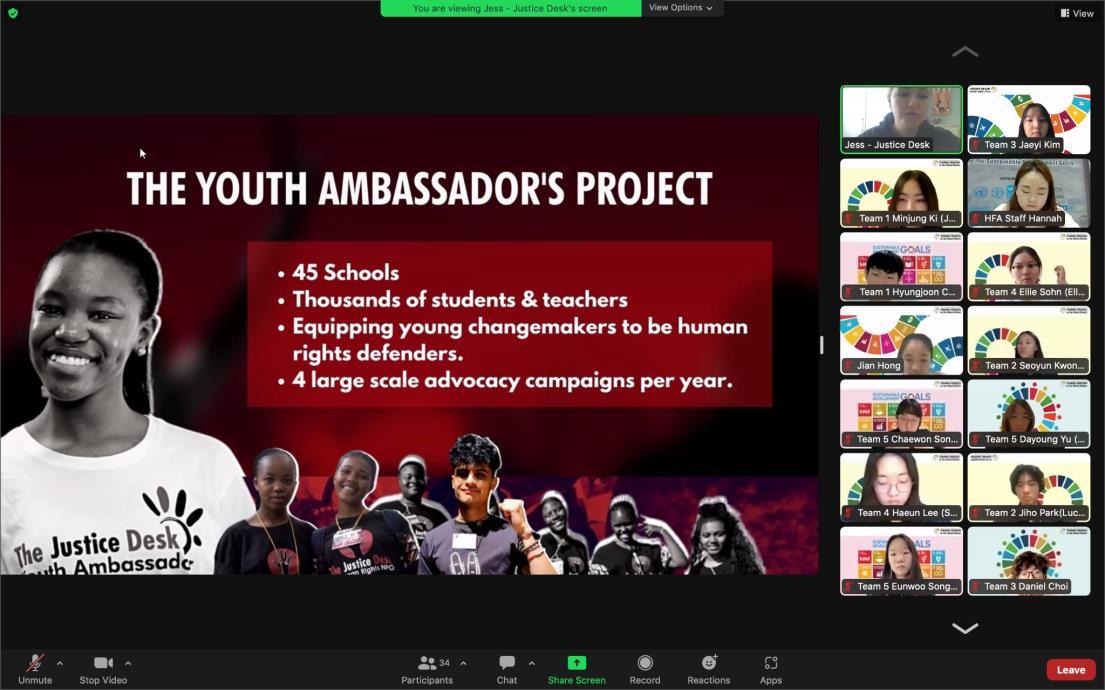
Education is a powerful tool used to aggrandize youth empowerment and knowledgeability. To introduce suchinitiativesintoeach localcommunity, student led campaigns canbe hosted by international, private schools where each pupil holds greater educational opportunities. Universities and educational institutions can expand their credits to students with high social service portfolios, emboldening such volunteer services. This will be a win win solution for students and marginalized populations, creating a synergy effect through the valuation of social service.


Alongside the empowerment of each individual, a nationwide human rights framework must be constructed and renewed in every country. This not only includes government investment in sustainable and equitable firms but strong, just institutions such as the Justice Desk must prosper to act as prevailing voices in society. Even further, governments could purchase a portion of the frontier technology being commercialized, convert them into convenient public services, and distribute them to the public. For instance, an Internet of Things(IoT) booth could be installed in every village to promote the inclusiveness of the secluded population, increasing opportunities for climbing the social ladder.
After the in depth investigation of human rights and injustice, I have derived a conclusion that humanrightsalleviationcanonlybeachievedthroughthepreeminent collaborationofgovernments, strong institutions, and empowering individuals. Since hate crimes and discrimination have peaked throughout the COVID 19 pandemic, it has come to attention that injustice must in the blind spots of societies be viewed. One must not view the fundamental topic with jaundiced, biased eyes, but must thrive for mutual communication and an amicable, non violent environment.
Overall, I believe that the most eminent solution to injustice is the empowerment of the youth population. By forming a firm foundation for social advocation and justice, a guideline for peace, justice, and security will be formed for future generations to follow. This may include forecasting of injustice, large scale student driven social campaigns, educational programs in orphanages and rural villages, and the production of diverse multimedia emphasizing the requirements for justice. Injecting an iota of social consciousness and awareness, this wave of justice will reach small communities and lead to an optimistic
perturbation of human rights. For example, a simple series of ‘what if?’ questionsin a feminist educational session can lead to the eradication of patriarchism, agnatic family customs, gender roles, and toxic masculinity. This would cause a ripple effect to remedy more stringent matters such as sex trafficking and rape. Fixating the focus on social change and youth empowerment, the international society will be able to achieve justice and human rights in unity, equity, and solidarity.
1. “Children Affected by Armed Conflict, 1990 2018 World.” ReliefWeb, reliefweb.int/report/world/children affected armed conflict 1990 2018.
2. Taub, Amanda. “A New Covid 19 Crisis: Domestic Abuse Rises Worldwide.” TheNewYorkTimes, The New York Times, 6 Apr. 2020, www.nytimes.com/2020/04/06/world/coronavirus domestic violence.html
3. “UN Universal Declaration, Abuse & Violation of the Freedom of Expression.” United for Human Rights, www.humanrights.com/what are human rights/violations of human rights/expression.html
4. “Universal Declaration of Human Rights.” United Nations, United Nations, www.un.org/en/universal declaration human rights/.
5. “What Are Human Rights.” OHCHR, www.ohchr.org/en/issues/pages/whatarehumanrights.aspx

6. “Human Rights Organisation: The Justice Desk: Cape Town.” TheJusticeDesk, https://www.justicedesk.org/
7. Peer, Andrea. “Global Poverty: Facts, Faqs, and How to Help.” World Vision, 23 Aug. 2021, https://www.worldvision.org/sponsorship news stories/global poverty facts.
8. Watters, Ashley. “25 Crucial Information Technology Statistics & Facts to Know.” Default, 3 Feb. 2022, https://connect.comptia.org/blog/information technology stats facts
Before I start I would like to thank all the staff, faculty members, and professors in thisprogram. As Ihad thisexcellent opportunityto join and participate in this program, I was able to think more about our society and community and broaden my horizon toward the United Nations. I also have learned the Agenda 2030, and 117 SDGs that are all interconnected to each other. To be honest, I wasn’t sure if I had to join this program since I was not an expert in this kind of field. But, I always wanted to know more about the United Nations sometime, and I got very lucky and got this opportunity to study the United Nations and SDG 17 deeply. I had a chance to meet all those great professors and students all around the globe who were working for the United Nations. I did not have a particular lecture that I enjoyed since all those lectures that I received were splendid and immaculate. I loved that all individual students were able to ask questions through zoom to professors at the end of or inthe middle of the lecture. I learned countless things throughthis activity and I should really concentrate and always be alarmed about global issues around the world.

SDG 11 is one of the many important SDGs that United Nations is striving to achieve by 2030. Inmy opinion, SDG 11isthe most important SDG among those 17 SDGs. We all dreamed of sustainable cities and communities over the globe and maintaining world peace.

SDG11istargetingnumerousthings, themainfocalideaistomakecities inclusive, safe, resilient, and sustainable.

11.1
By 2030, ensure access for all to adequate, safe, and affordable housing and basic services and upgrade slums
11.2
By2030, provide access tosafe, affordable, accessible,and sustainable transport systemsforall,improving roadsafety, notablybyexpandingpublictransport, withspecial attentiontotheneedsofthoseinvulnerable situations, women, children, persons with disabilities, and older persons
11.3
By 2030, enhance inclusive and sustainable urbanization and capacity for participatory, integrated, and sustainable human settlement planning and management in all countries
Strengthen efforts to protect and safeguard the world's cultural and natural heritage
11.5
By 2030, significantly reduce the number of deaths and the number of people affected and substantially decrease the direct economic losses relative to a global gross domestic product caused by disasters, including water related disasters, with a focus on protecting the poor and people in vulnerable situations
11.6
By 2030, reduce the adverse per capita environmental impact of cities, including by paying special attention to air quality and municipal and other waste management
11.7
By 2030, provide universal access to safe, inclusive, and accessible, green and public spaces, in particular for women and children, older persons, and persons with disabilities
11. a
Support positive economic, social, and environmental links between urban, per urban, and rural areas by strengthening national and regional development planning
11. b
By 2020, substantially increase the number of cities and human settlements adopting and implementing integrated policies and plans towards inclusion, resource efficiency, mitigation and adaptation to climate change, resilience to disasters, development, and implementation, in line with the Sendai Framework for Disaster Risk Reduction 2015 2030, holistic disaster risk management at all levels
11. c
Support least developed countries, including through financial and technical assistance, in building sustainable and resilient buildings utilizing local materials


As with the other 17 SDGs, creating sustainable cities and societies is never an easy task. But why, out of the 17 SDGs, is SDG 11 the most important? In fact, over 90% of COVID 19 cases are occurring in cities, with the 1 billion people who live in slums with high population densities suffering the most. Prior to the coronavirus, 4 billion people, or more than half of the world's population, lived in cities where they had to contend with worsening air pollution, inadequate infrastructure and services, and unplanned urban sprawl.
Successful COVID 19 containment cases show theincredible adaptability and resilience of urban societies in responding to new norms.
As individual people, it is critical to know and work for your society. Every citizen will eventually be impacted by all of these problems. Inequality can cause unrest and instability, pollution harms people's health and has an impact on worker productivity, which in turn has an impact on the economy, and natural catastrophes have the potential to disrupt people's daily lives.

What we can do isjust be aware of what is going on in our society. Engage in active participation in the administration and management of your city. Promote the kind of city you think the world needs. Create an action plan based on your vision for your neighborhood, street, and building. Exist enoughjobs? Can your kids safely walk to school? Can you go on a family nighttime walk? Where is the closest public transportation located? What is the state of the air? How would you describe your common public areas? The impact on quality of life increases as you improve the surroundings in your neighborhood. A sustainable society starts with people's attention.
Citation
“Goal 11 | Department of EconomicandSocial Affairs”United Nations, https://sdgs.un.org/goals/goal1 Accessed: August 28,
“SDGs & Topics:. Sustainable Development Knowledge Platform” United Nations, https://sustainabledevelopment.un.org/topics.html Accessed: August


a. World Expo and Sustainability: Ambassador Enna Park
b. Specialized Expo: Recognized Expo
c. Honorary Ambassadors/Culture
B. Greener Environment and Lifestyle
a. United Nations and Climate Action (Esra Sergi Bertani)
a. Public Diplomacy to Back Up Foreign Policy Goals: Its History and Future: Kadir Jun Ayhan
D. Equitable Future and Communities
a. Empowering People for Human Rights (Jessica Dewhurst)

b. Education and Inequality (Youngjin Lee)
The World Expo is a world fair held to exhibit and showcase the different technologies and advancements of that country/region. The World Expo started in 1851 and has been held all around the world every five years. The country is being selected for the 2030 Expo and Russia, South Korea, Italy, Ukraine, and Saudi Arabia have submitted bids to hold the event. Busan, a city in South Korea has submitted a bid to be the hosting country and has planned out its different goals and plans.
a. World Expo and Sustainability: Ambassador Enna Park

Ambassador Enna Park is part of the Busan World Expo bid committee. In her lecture to the students of this UN training program, she explained how she was a South Korean ambassador to the UK during 2018 to 2021. She described the world expo as a whole new function to platform the visions for the future. Providing solutions to common challenges we face, reflecting the past, present, and future, and to showcase national capabilities, creativity and imagination
As a part of the bid committee, they work to help the bid pass or be accepted. They constantly travel conference to conference to appeal why we must run the World Expo in Busan. They present different ideas, the scale of the event, the cultures they can incorporate and what goals we are trying to achieve by running a World Expo.
The Busan Expo2030 is running under the headline of ‘Transforming Our World, Navigating To A Better Future’. Incorporating the three aspects of our environment, technology, and equality. It’s set to be an expansion of the soft power of Korea and its culture, to set a strong economic balance, and show the technological advancements of Korea. The year 2030 is also set as the goal to achieve the United Nations Sustainable Development Goals, so the expo is set to be the display of those accomplishments. Thisis identifiable through three main aspects, sustainable living with nature, technology for humanity, platform for caring and sharing.
One difference that must be made isthe difference between registered expos and recognized expos. A World Expo is a registered expo which is much larger and can be held without a very specific topic. However a recognized expo is a specialized expo which is much smaller and has a hyper specific genre. Specialized and smaller expos have been held in Korea before in 1993 Daejeon, and 2012 Yeosu.
The greatest technique that Korea has been holding is its culture and appointing honorary ambassadors. Globally, the K Prefixes such as K Pop, K Drama, K Cosmetics, and K Cinema. The current honorary ambassadors that have been appointed are the globally famous boy group, BTS. As one of the greatest K pop groups of the century, BTS joined the efforts to promote the Busan WorldExpoandisplanning afree concert inBusan thisOctober. Likethis, usingthe famous and well known cultural aspects of Korea has helped their efforts to get Korea chosen as the 2030 country.

Ms. Bertani works at the United Nations and is also a climate action officer. She delivered a lecture on how to fight the climate emergency.
Global GHG emissions have continued to rise but in pathways that limit warming to 1.5C, and they peak before 2025. There’s no room for building new fossil fuel infrastructure. We need rapid transformations across all systems to avoid the worst climate impacts. We need to scale up renewable, low zero emission, incentivize green building and communities. Changes in lifestyle and behaviors have a significant role to play in mitigating climate change. Limiting global temperature rise to1.5C will beimpossible without carbon removal. Climate financefor mitigation must be 3 to 6 times higher by 2030 to limit warming to below 2C.
What efforts are we making right now? Constant climate meetings and conferences are essential to make change. Change not only comes from individual work but also from a collective conversation as all countries and states work towards a positive goal. A big climate conference is COP 27: Conference of the State Parties. The road to a better future is closing rapidly and we must do all we can right now. Where we stand right now for the UN, Korea, the whole globe is the last opening to change. After this door closes shut, we can’t make the same progress we seek.
i) We must reform bureaucracies in order to make them more active to our climate problems and to cease the use of fossil fuels. The roots of every problem lie in the establishment
ii) We must also reform permit processes to make sure that the building, structures, and plants being built will not destroy our environment.
iii) We must also shift our energy venues right now to healthier energy ports. This would also mean redirecting our money and funding into expanding these subsidies.
iv) We must start tripling investments in renewable energy. Not only shifting our energy venues, but also investing more in renewables so that they could become even cheaper for every state, country, and continent to use.
v) As citizens we can learn more about the climate crisis. The first step of every big change is knowledge. In order to truly make an impact there must be an education about our current climate situation and individual actions we can take to improve it.
vi) In connection with the prior step, we must strive to livesustainably. Tryingto limit our waste, use less energy, drive less, reuse, have awareness about our fossil footprint that we leave behind.


vii) Another part ofthisisto speak upand demandurgent action from ourauthorities. Our mayors, senators, representatives, whitehouse, we must demandaction right now. If citizens cangroup together to advocate for an immediate change, great things can be accomplished.
Professor Ayhan is an assistant Professor of International Relations at Ewha Womans University Graduate School of International Studies. He presented his slideshow on public diplomacy and how it will help policy goals. How it has worked in the past and how it will affect the future.
i. Public diplomacy is communication based activities. It is used towards targeting the whole public. Globalization is one of the useful aspects of utilizing public diplomacy. Globalization and communication helps toward technological advancements. It is also used towards democratization and liberalization. Globalization helps the citizens, empowered individuals are more relevant in world politics.
i. Technological advancements are what affect a large part of public diplomacy and vice versa. Not only the expansion of social networking sites but also the great toil to make more transparent and inclusive campaigns. This is because virtually anyone can access those campaigns online very easily and there is a necessity not only to diplomatically convince one side but also to be more clear to appeal to every viewpoint.


i. South Africa is a empowering place where same sex marriage recognized, they have ompletely take apart nuclear weapons, they hold free healthcare for young children and pregnant women, and have anti discrimination laws. South Africa sets the perfect on paper example of what we must advocate for and the communities we must create. However we must go further than simply written in laws.
i. 55.5 percent of the population is living in poverty. And South Africa is the most unequal country in the world as the top 5% owns 80 percent of wealth. Not only that, 1 woman is murdered every 6 hours and 1 in 3 girls are raped. There are still clear violations of human rights being established in various countries.
ii. As quoted from UNESCO, “Our message is clear: women and men must enjoy equal opportunities, choices, capabilities, power and knowledge as equal citizens. Equipping girls and boys, women and men with the knowledge, values, attitudes and skills to tackle gender disparities is a precondition to building a sustainable future for all.”

The lecture ‘United Nations and Climate Action’ was very impressive for me. The lecturer, Ersa Sergi Bertani, provided information about what was discussed in IPCC Climate Change Mitigation Report, the ways to jump start the renewable energy transition, and the feasible efforts we can do for the environment.
IPCC report 2022 was released on 28 February 2022. According to the report, firstly, global GHG emissions have continued to rise, but in pathways that limit warming to 1.5°C, they beak before 2025. Secondly, there’s no room for building new fossil fuel infrastructure. Third, we need rapid transformations across all systems to avoid the worst climate impacts. Fourth, changes in lifestyle and behaviors have a significant role to play in mitigating climate change. Fifth, limiting global temperature rise to 1.5°C will be impossible without carbon removal. Lastly, climate finance for mitigation must be 3 to 6 times higher by 2030 to limit warming to below 2°C.

Renewable energy will be the biggest weapon in to fight against the climate crisis. There are five ways to jump start the renewable energy transition. Renewable energy is the biggest weapon to fight against the climate crisis. Firstly, each country, especially developed countries and the G20 that emit the most greenhouse gas (83% of greenhouse gas emission is responsible for G20) should develop technology to generalize and commercialize using renewable energy in daily life.
There are three ways we can fight the climate crisis. First, learn more about the climate crisis. Second, live sustainably. Third, speak up and demand urgent action. We can talk about environmental issues with our friends, family members, and neighbors. We can propose our school to keep our school and classrooms green. We can also join a local organization in support of climate action. We can try global engagement by joining the UN’s Act now campaign.
The second impressive lecture was ‘Human Rights’, by Jessica Dewhurst. I have a lot of interest in human rights as well as environmental issues. The lecture was about human rights in South Africa. It was good for me to learn about the human rights of certain regions instead of the view on broad human rights. Far from my prejudice against Africa, South Africa is much more developed than I thought. There are many high buildings. Withregard to human rights, South Africa recognized same sex marriage in 2010 and is the only country that dismantle its nuclear weapons. Even though South Africa is well developed compared to typical thoughts, however, still many people live in shacks. There are no electricity, no water, and no sanitation. Approximately 55.5% of the population is living in poverty. Also, South Africa is the most unequal country in the world. Race plays a determining factor in a society where 10% of the population owns more than 80% of the wealth. Woman dies every 6 hours and in 3 girls is raped in their lifetime. South Africa needs to address the root cause of various human rights issues; climate crisis, hate crime, drug abuse, gangsterism, GBV, child abuse, illiteracy, poverty, human trafficking, and homelessness.
The efforts to eradicate all types of human rights abuse are very unique to me. The MBOKODO club is supporting girl survivors of rape and GBV from vulnerable communities. This project has three components. First, the Mbokodo club trains girls in self defense and fitness to help them to be able to protect themselves. Second, female empowerment workshops are offered to the girls. They learn sexual health rights, human rights, confidence building, financial management skills, mental health, leadership skills, and many others, equipping them to be leaders in their communities. Lastly, the club helps the girls to maintain good mental health through group counseling sessions and wellness activities. Girls can also have individual counseling with a psychologist to get over the traumatic memory.
There is also a project for boys focused on ending GBV and toxic masculinity. Like the Mbokodo club, it provides empowerment workshops. It also supports mentorship initiatives, psycho social support, and outdoor adventure based education. After the lecture, I thought that human rights abuse is still harsh in South Africa, but it’s meaningful to have a series of projects through clubs to eradicate violating human rights. It was impressive that there is also education for men to end GBV, as most developing countries where women's rights are very low do not have gender equality education for men.
UN training program inspired me a lot to research much specific knowledge about environmental issues and human rightsin the world, and how the UN and NGOs deal with them instead of having general and superficial knowledge. The five day experiences were helpful to broaden my perspectives and concreted my dream as a diplomat.




Public diplomacy can merely be described as communication between two foreign publics. To elaborate, it is the efforts made by the government to build upon communication. It could be an exchange between educational institutions or advocating for a certain social issue between nations. Whenever I saw suchtalkstaking place through news outlets, I never thought much about them, I always let them pass without much interest. After listening to Professor Kadir Jun Ayhun’s lecture regarding public diplomacy, my aspects regarding this route of diplomacy changed. To start off, the Professor described public diplomacy as a part of history and the future. The act of communication based activities to support foregin policy goals was utilized in the past and present, though the techniques and rules were much different back then. Centuries ago, when nations were only ruled by kings, those with high connections with the king would be able to help make important decisions for the nation. Ordinary public opinion would not be as considered. Today’s society contrasts this because governments take into heavy consideration of public opinion for important matters. This is because of the upcoming of information period. Information was expensive to get hold of in the past, only privileged people could receive this sort of advantage. Most of the information was at the hands of the king along with the people working for him. The majority of the public did not hold this kind of knowledge.
Today, every individual who has easy access to an internet source or media of any kind could obtain and produce information. The changing cost of consuming and producing knowledge empowers publicopiniontoexpand. Theultimategoalofpublicdiplomacy istopromote a countrybyfulfillingneeds, interests, and information through building relationships between the publics of two different countries. A lot of developed countries such as the United States and Iceland seek public diplomacy with other nations for globalization, technological advancements, democratization, and increasing public opinion. The following are brief examples of public diplomacy goals for certain countries. In the United States, public diplomacy is targeted toward the publics outside of the country. The United States avoid citizens from believing in propaganda, rather, they seek to maximize compliance and minimize resistance. In Turkey’s case, they seek prominent leadership positions in certain regions. Since Turkey has a Muslim dominant religion, its goal is to build several mosques, start cultural renovation projects, and provide more aid to other Muslim dominant countries. In all, Turkey focuses their public diplomacy on expanding religion, especially for the Muslim community. South Korea takes part in public diplomacy in many different ways.
For example, Korea uses Kpop as one of its biggest tools for implementing good relationships with other countries. The rise in major Kpop bands like ‘BTS’ and the movie ‘Parasite’ has brought mainstream attention to other nations around the world. Invitations

to award shows in the United States have been sent to Korean bands, producers, and actors, along with numerous awards given. These examples are a small portion of the many efforts that have been made by several other countries to develop good relationships. Countries have made it evident that in doing public diplomacy, they could promote policies and strengths. During the first COVID 19 outbreak in 2020, South Korea gained nationwide attention by emphasizing its fast measures to control the outbreak. This helped Korea gain international solidity and cooperation. Public diplomacy is also about reaching universal goals and helping the provision of societal needs, like ending racism or transparency of government. Public dimploamcy is doing a big role in not just international cooperation and communication, but respectfully understanding each other’s differing outlook of the world.
As I previously mentioned, listening to Professor Kadir Jun Ayhun’s lecture has made me face how crucial public diplomacy is in our lives. As I am a student that has yet to learn and research more about public diplomacy, this paper was fully based on the notes that I took during his lecture.




Being a student who takes interest in both liberal arts and science, Professor Jae Yeon Kim’s session about DataScience being used in politics and diplomacy introduced me to the integration of liberal arts and science. Data science is one of the majors that I am interested in studying in university, so I decided to do more research about data science in politics.
To define data science, it is a field of study where technology is used to gain insight of meaningful statistics from unstructured data. It can be applied to many different fields of work, and its most common application is business. Through data science, businesses can analyze data and see certain trends in the market. Data science is a relatively new field of study, made possible by the advent of the Internet and intricate computers. The Internet collects every miniscule information about the users, creating a cloud of data. This cloud of data is the storage where data scientists fish out data to reorganize and analyze then make meaning of seemingly unrelated information. As such, data science is a field of study that is vital in modern society.
The most obvious use of data science in politics is predicting election outcomes. Data scientists collect data from previous elections and analyze the trend to apply it to future elections. Data science is also employed during political campaigns in order to better draw in voters. Social media data is collected by data scientists, then is reorganized using algorithms to show voter sentiment. In the 2016 U.S. presidential election, data scientists had predicted the victory of Donald Trump using such methods.
It isthe growing consensus that elections will be won by candidates that better utilize data science. Governments that skillfully collect data and recognize changes in public opinion will be able to better suit their people’s needs and become more democratic. On the other hand, some people express worries about data science being abused and violating individuals’ privacy. It is true that most governments are able to access information about their citizens without their knowledge. Although people consent to their information being used and traded in many websites, most of them do not recognize the full extent of how their information can be used. This is why data science can become a deadly weapon in modern society if powerful organizations decide to do so.
If used the right way, data science can support democracy around the world. However, misleading and manipulating data analysis is very common and harmful. Being a two edged sword, data science in politics is an imperative tool that should be carefully handled.
 Lycée Français de Séoul
Lycée Français de Séoul
Over the course of five days, I had the pleasure of meeting experts in the fields of international relations and sustainable development. During the course, I learned things I couldn't have learned in school and met others interested in the same topics. It was a privilege to have this opportunity and in gratitude for the Hope to the Future Association that organized this program, I have included one lecture that stood out a lot to me.

In the lecture was presented by Jessica Dewhurst, CEO & Founder of The Justice Desk, Africa Province Director at ERI United Nations. A brief description of what the Justice Desk is and what it does was provided by Dewhurst.

Founded in 2003, her organization fights for the rights of all people and challenges violations of human rights. Local people are empowered and equipped with the necessary skills and platforms to lead change in vulnerable communities. In addition to training and education, the workers also lobby national and international governments and initiate community led initiatives.
Among their focal areas are: Human Rights, Gender based Violence, and Children’s Rights. Through projects such as the Mbokodo Club, they promise to improve all three of these domains.
South Africa, Zambia, and Zimbabwe are supported by the Justice Desk in their efforts to advance towards a more just and equal society. By checking whether nations are telling the truth about their improvements to the United Nations, this organization ensures that the UN is not deceived.

The most striking thing about Jessica Dewhurst's lecture for me was the way shemovedme with whatshe did. Whilethere are other organizations that aim for peace and justice, meeting the CEO of one of them was quite impressive. In addition to learning what inspired hertocreate The Justice Desk, Ialsolearned how sheplans to make it successful.
Overall, I had a great experience over the past five daysthanks to Hope to the Future Association. In addition to learning new topics, I was able toimprovemyknowledge of others. AsI wasable totalk to others who had insights on such topics, it was enjoyable meeting new people with an interest inthe United Nations. While before I had little knowledge about theSDGs and the United Nations, now, I have learned so much in such a short time. It was an unforgettable experience.


As a senior, learning about the United Nations and the SDGs very specifically was a great honor and opportunity to carry on my journey towards my goal to work in the United Nations. From lectures about realistic situations happening in the real field to sessions that encouraged me to have bigger goals, the 20 lectures were all very meaningful to me.
Public diplomacy is any of the various government sponsored efforts aimed at communicating directly with foreign publics to establish a dialogue designed to inform and influence with the aim that the foreign public supports or tolerates a government’s strategic objectives. As international ways of communication has developed over the recent years, the practice of public diplomacy has also developed from media interviews to internet and educational exchanges.
Traditional diplomacy actively engages one government with another government. In traditional diplomacy, embassy officials represent their government in a host country primarily by maintaining relations and conducting official business with the officials of the host government. Public diplomacy primarily engages many diverse non government elements of a society. Especially, film, television, music, sports, video games and other social/cultural activities are seen by public diplomacy advocates as enormously important avenues for otherwise diverse citizens to understand each other and integral to the international cultural understanding, which they state is a key goal of modern public diplomacy strategy. It involves not only shaping the message that a country wishes to present abroad, but also analyzing and understanding the ways that the message is interpreted by diverse societies and developing the tools of listening and conversation as well as the tools of persuasion.
The current trend of public diplomacy is to give every citizen the opportunity and resources to become an ambassador. In Korea, public diplomacy entails promoting diplomatic relations by sharing our country's history, traditions, culture, arts, values, policies, and vision through direct communication with foreign nationals. By doing so, Korea enhances its diplomatic relations and national image by gaining the trust of the international community and increasing the country’s global influence. This can be seen by the power of K culture trending globally in the status quo.
Personally, when I met foreigners 10 years ago, many did not know Korea well, and some even confused ROK for DPRK. The active public diplomacy during the past 10 years made everyone interested in Korea, where now we see foreigners knowing Korea at least for BTS, PSY and Son Heung Min. But not only are those people famous, but the strong efforts of public diplomacy made more attractions toward the country ‘Korea’ itself.
Thenwhatcouldanindividualdoforpublicdiplomacy?The21st centurymadeeveryoneconnectedonline, making each andevery one ofusa creator. Asindividual influencers that can influence one another without any physical barriers, we as individuals can also be part of public diplomacy.



Non governmental organizations (NGO) are organizations that are generally formed independent from the government, and are usually nonprofit and active in human rights movements. The term as it is used today was first introduced in Article 71 of the newly formed United Nations' Charter in 1945. While there is no fixed or formal definition for what NGOs are, they are generally defined as nonprofit entities that are independent of governmental influence although they may receive government funding. According to the UN Department of Global Communications, an NGO is "a not for profit, voluntary citizen's group that is organized on a local, national or international level to address issues in support of the public good."
Ms. Jessica’s lecture was interesting as she was the first person that introduced herself as the CEO of a NGO, The Justice Desk. The Justice Desk is a human rights non profit organization based in South Africa, Zambia and Zimbabwe established in 2013, with the main goal of Promoting the Power of Everyday Activism. In order to do this, empowering ordinary people to understand and defend their Human Rights so that they can transform society and create a more just and equal world.
Personally, I was interested in Ms. Jessica’s vision and life as she explained her goal for human rights. She has traveled extensively, working in various countries across the globe in the fight for fundamental human rights.Sheisatrusted andwell knownprofessional inthe fieldof humanrightsandanti humantrafficking. She believes human rights issues are important and critical, and one activist can make a difference. While I am also highly interested in human rights issues, I thought I only focused too much on international organizations but not on individual efforts to make changes, and I could raise questions to myself.
Climate changes are actually impacting our daily lives. This can especially be seen from climate mobility issues. The climate crisis has sparked a crisis of mobility: Around the world, in 2019 alone, some 23.9 million people were involuntarily displaced by weather related disasters. That dwarfs the 8.5 million people displaced by the factors we so often associate with migration and displacement: conflict and violence.
Now we even call some people climate refugees or climate migrants. Climate migrants are a subset of environmental migrantswhowereforcedtoflee"duetosuddenorgradual alterations in the natural environment related to at least one of three impacts of climate change: sea level rise, extreme weather events, and drought and water scarcity."
In January 2020, the UN Human Rights Committee ruled that "refugees fleeing the effects of the climate crisis cannot be forced to return home by their adoptive countries."

Climate issues have always been big issues that we learn at school, but the lecture provided me more examples and real life situations that made me think more about the problem and address issues regarding climate migrants during group presentations.

FAO, the Food and Agriculture Organization of the United Nations is an international organization that leads international efforts to defeat hunger and improve nutrition and food security. FAO supports governmentsandpartnerstodesigntheright policiesandprogramsformillionsofpeoplearoundtheworld. While promoting many goals in the SDGs, the FAO especially promotes the 2nd goal of the SDGs, Zero Hunger.
Although the 2030 SDGs were made in 2015, there were continuous ideas of an international organization for sustainable food and agriculture from the late 19th century. An international conference held in 1905 led to the first international organization, the International Institute of Agriculture. The IIA was the first intergovernmental organization to deal with problems regarding agriculture on a global scale. It worked primarily to collect, compile, and publish data on agriculture, ranging from output statistics to a catalog of crop diseases, and moreover published the first agricultural census in 1930. After the World War II, the IIA ended but the League of Nations still called conferences on food and agriculture, and at 1948, the FAO was first established.

The FAO's early functions supported agricultural and nutritional research and provided technical support to member states to promote agricultural, fishery and forestry production. Since the 1960s, the FAO has focused on the development of high yield grains, the elimination of protein shortages, the promotion of rural employment, and the expansion of agricultural exports. In 1974, following the famine in Africa, the FAO held the first World Food Summit to address widespread hunger, malnutrition and food insecurity. The meeting resulted in a proclamation that "every man, woman and child has the inalienable right to be free from hunger and malnutrition in order to develop their physical and mental faculties", and a global commitment to eradicate these issues within a decade.
The FAO is currently outlining priorities in its fight against hunger. First, to help eliminating hunger, food insecurity and malnutrition contribute to the eradication of hunger by facilitating policies and political commitments to support food security and by making sure that up to date information about hunger and

nutrition challenges and solutions is available and accessible. Second, making agriculture, forestry and fisheries more productive and sustainable promote evidence based policies and practices to support highly productive agricultural sectors (crops, livestock, forestry and fisheries), while ensuring that the natural resource base does not suffer in the process. Third, reducing rural poverty helping the rural poor gain access to the resources and services they need including rural employment and social protection to forge a path out of poverty. Fourth, enabling inclusive and efficient agricultural and food systems helping to build safe and efficient food systems that support smallholder agriculture and reduce poverty and hunger in rural areas. Lastly, increasing the resilience of livelihoods to threats and crises helping countries to prepare for natural and human caused disasters by reducing their risk and enhancing the resilience of their food and agricultural systems.
Before listening to Mr. Tang’s lecture, I already had high interest in the area of food and agriculture, especially because it is directly related to poverty issues that I am interested in. But the lecture did not only give me higher insights towards the FAO and its mission, but also the linkage of the FAO and Republic of Korea (ROK), since he is the head of FAO PLO in the ROK. As we know, the ROK had hardships during the 1900s, from transforming toan ODA recipient country to an ODAdonor country. From national efforts and support in international levels, ROK now actively shares its information, experience and technology to support other countries. I personally got to understand more about the relationship between the ROK and FAO which gave me think about how the world could become a better place to live in with the help of international institutions.


The earth has served as our warm home and home so far. It provided us with clean water, fertile land, abundant resources, and more which preserved mankind and all living things. But now we humans are discussing migration to another planet even though They turned the Earth, which was a blue star, into such a barren land. Humans are at the top of the food chain and have wiped out countless species and put them on the brink of extinction. However, now, the tip of that sword is now directed at the humans. It is being argued that the Earth, which could have possibly provided us with an eternal home, is now capable of accommodating humans in less than 100 years. Global GHG emissions have peaked, and there is no more room to build new oil infrastructure. We need rapid transformations across all systems to avoid the worst climate impacts.
So what can we do as individuals? Changes in basic life attitudes play an ultimate role. Even if consumers buy green products or turn off lights and water at the right time, they can have a huge impact on the environment. As cosmopolitans, we clearly have a responsibility and need to think about the environment once more in our daily lives. Individuals can remember three things to protect the environment: Recycle Ranger, Water Wizard, and Fashion Fixer.
• Recycle Ranger: As the name suggests, it is to recycle. Recycling alone can significantly reduce the amount of unnecessary waste.
• Fashion Fixer: Don't wear clothes that use a lot of oil and resources unnecessarily, and recycle or resell worn clothes so that the fashion world can also practice recycling.

• Water Wizard: When washing your hands or applying soap, turn off the water for a while, or dictate rather than run it down to reduce the amount of water wasted.

However, as we all know, no matter how hard individuals try, efforts at the national level will be much more meaningful. This is well illustrated by the fact that 80% of GHG emissions originate from the G20, which is a representative country. So, what are the national level efforts? Currently, we are exerting efforts in various fields such as policies, investments, subsidies, materials, and technologies to develop new energy to replace petroleum energy worldwide. If a new technology is developed to replace the existing petroleum energy, it will have a very positive impact on environmental conservation.

In spite of these numerous efforts, there are many problems that hinder the resolution of environmental problems. One is that the profit seeking actions of many companies and organizations prevent this. They are currently usingpetroleum alot, drivenbythe cheapness ofpetroleum energy, andcreate advertisements that falsely claim that coal/oil is environmentally friendly in the first place, a so called greenwashing advertisement. Also, sometimes citizens are exposed to misinformation about environmental issues and lose their awareness. Social inequality is also a barrier. The poor focus on resolving the immediate dangers day by day and fail to pay attention to global environmental issues. There is also a lack of education on the seriousness of the current situation. We need to educate them so that they know the seriousness of environmental problems and how to solve them.
As such, we and our planet are currently facing a huge problem. If we don't solve this problem as soon as possible, we may have to leave our precious blue planet. This is not a fairy tale from the distant future. If we do not stop the global temperature rise by 1.5 degrees by 2025, we will lose our livelihood. We should know the seriousness of the problem described above, possible solutions, and current efforts to create a greener tomorrow.


The issue of climate change is one of the global issues considered most urgent to be considered. Despite the progress in sustainability worldwide and discussions about climate action being held in official events, humanity’seffortsarestillregardedasinsufficient. TheUnitedNationsaimstoencouragecountries to take on more climate action and contribute more, but also urge individuals to act for the environment.
Sources such as the IPCC(Intergovernmental Panel on Climate Change) stress that climate action and efforts for sustainability aremore crucial thanever. According tothe MitigationReport from the IPCC, global greenhouse gas emissions are continuing to rise, there is no more room for building any new fossil fuel infrastructure, and a limited global temperature rise to 1.5℃ will be impossible without carbon removal. This calls for rapid transformations in all sectors and major changes in lifestyles in order to avoid the worst climate impacts. The scientific community also emphasizes that ‘we are at a point of no return.’ However, the global community is still very much off track from fulfilling its promises of limiting global temperature rise and limiting climate change.
Currently, there are potential responses to climate change concerning present events. The Ukraine crisis, which is limiting the export of fossil fuels from Russia to most European countries, and raising the price of oil, is being considered an opportunity to invest in more renewable energy and increase the use of renewables. Many countries are announcing their future efforts for the climate crisis, including South Korea. The UN presents five major methods to jump start the renewable energy transition; policies, investments, subsidies, materials, and technology. Governments have primary duty to implement these methods, but private sectors, academic sectors, and individuals also have a responsibility to contribute to the transition to a sustainable society.
One concern that is present in the discourse related to sustainable transition is the issue of developing countries actively using fossil fuels or destroying their own natural environment, their reasoning being that developed countries already have used natural resources for their own development. However, the current consensus is that while developed countries are responsible for achieving development through unsustainable means, it is better for countries to invest in renewables if they intend to catch up. This is because investing in fossil fuels such as coal would not be a stable source of income since there is not much left of them in the world, and it is much more efficient to be investing in renewables. What is needed now is for developed countries to provide enough support for a sustainable energy switch.
Multiplesolutions toreach sustainable societies are present, butthere need to be effective methods for putting them into practice. Below are some of the methods to bring a sustainable transition easier and faster: Governments and industries should pursue a circular economy, which is a model for production and consumption that involves sharing, reusing, repairing, and recycling. A circular economy would reduce waste and decrease the need for excessive production, resulting in fewer carbon emissions and the promotion of a sustainable lifestyle. Governments and companies should also participate in the ambition loop and push one another to take bold action to combat climate change. When governments establish stronger climate policies, they will encourage businesses to strive toward the attainment of a sustainable community and challenge consumers to integrate environmentally friendly behaviors into their lives.
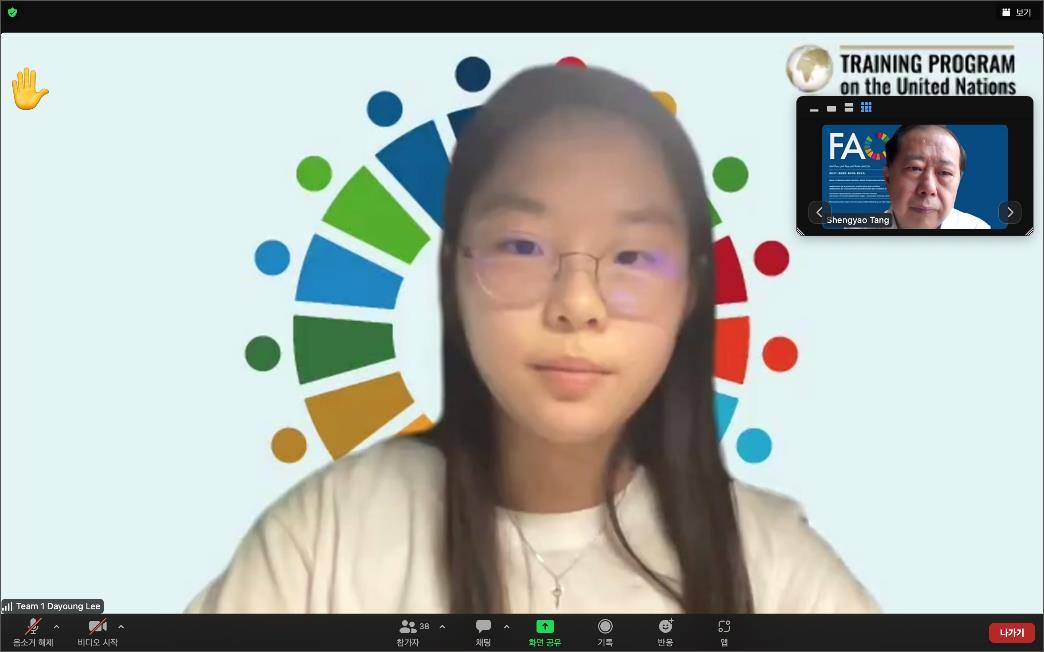
What I concluded from listening to this lecture and conducting research related to climate issues is that the road to sustainability is neither the responsibility of only governmental institutions nor individuals. A sustainable transition is something that can only be completely achieved through a multilateral, collaborative effort. Every sector has a part to play, from global organizations such as the UN to each individual.

 Daejeon Banseok High School
Daejeon Banseok High School
Many experts and decision makers have come to the conclusion that carbon removal will be a crucial strategy to stabilize the global climate as carbon dioxide emissions continue to rise. When it was decided that limiting the increase in global temperatures to two degrees Celsius would be essential to the preservation of the environment and further corruption prevention, the significance of the issue first became apparent in the Paris Climate Agreement. In its fifth assessment report, the Intergovernmental Panel on Climate Change (IPCC) of the United Nations determined that many climate models can only achieve the two degree Celsius target when carbon removal technologies are taken into consideration as feasible policy alternatives. This research discusses the advantages and disadvantages of both technical and natural approaches for removing carbon dioxide.
The removal of carbon can be done in a variety of ways. Natural carbon removal and technological carbon removal are the two main categories of carbon removal strategies. Simply absorbing and storing carbon dioxide falls under the category of natural carbon removal. This can be done by using carbon sinks, which are things like soil, plants, and the ocean that take in more carbon from the atmosphere than they emit. Large tracts of soil, marshes, farmland, and forests that absorb carbon dioxide from the atmosphere and store it in their biomass are referred to as land based carbon sinks. Similar phenomena are referred to as "blue carbon," which refers to the carbon storage in coastal and ocean ecosystems such intertidal salt marshes, mangrove forests, and seagrass meadows.
There are policies that can be employed to maximize the natural uptake of carbon, even though these carbonremoval mechanismsarenaturaloccurrences. Commonmethodsthat canboost theuptakeofcarbon include planting trees in areas that are typically barren of vegetation and in areas where forests have been devastated.

Another method of removing carbon involves a system that aims to do so from the air itself. The three technological methods of carbon removal that are most frequently used are direct air capture, carbon capture and storage, and bioenergy combined carbon capture and storage (BECCS) (DAC). The global CCS organization claims that although while CCS is formally regarded as an emission mitigation strategy because it cannot really remove carbon from the atmosphere, it is nevertheless essential to comprehending carbon removal in general. The simplest kind of carbon removal is CCS, which involves capturing carbon from pollution streams and storing it, typically kilometers below earth. Some of the carbon that has been absorbed can occasionally be reintroduced into the atmosphere thanks to this reutilization technology. Some prospective applications, like capturing carbon in cement, could do so permanently, whilst others, like adding carbon to soda, would cause the carbon to be released back into the atmosphere. Still, by recycling the carbon that would have otherwise been promptly discharged into the environment, carbon capture technologies generally lower the quantity of carbon emissions.
The two technologies that directly extract carbon from the atmosphere are BECCS and DAC. The term "BECCS" especially refers to the collection of carbon from sources that burn biomass to produce power. BECCS are especially popular, because it removes carbon while also producing electricity.
The fact that natural and technology methods of carbon capture remove carbon from our heavily polluted environment may be its most obvious advantage. When used appropriately, these technologies could potentiallycontribute topreventingglobaltemperaturesfrom risingabove thetwodegreeCelsiusthreshold. Although it shouldn't be seen as a magic bullet, carbon removal should be included in global plans to combat climate change.
Implementing several of these carbon capture methods has advantages beyond just lowering greenhouse gas levels. They have several positive social effects in addition to improving the natural carbon removal process. These include boostingenvironmental objectives includingimproving landconservation practices and supporting wildlife conservation, as well as building climate resistance.
The technology approaches are advantageous as well. One is the potential for rapid large scale carbon dioxide removal (compared to natural systems, which are slower to absorb carbon). Another is the use element of CCUS; the extra carbon might be used for a variety of beneficial purposes, leading to job creation and economic growth. If CCUS were to become viable, it might take off swiftly and contribute to the fight against global warming. Lastly, even while technology solutions can't completely eliminate carbon, they can nonetheless facilitate the switch to a clean energy economy by lowering the quantity of carbon released by coal or gas fired power plants.
While carbon removal has numerous positive social effects, there are always hazards as well.
Concerns for natural systems for removing carbon dioxide include the possibility of high administrative costs, the identification of sizable areas for removing carbon dioxide, andthe sluggish rate at which carbon sinks can absorb CO2. Enhancing natural carbon removal systems may come at a considerable expense, including the implementation of legislation and the setting aside of sizable tracts of land for this purpose. Additionally, reducing atmospheric CO2 might not be done as quickly as investing in technologies that remove carbon from the atmosphere organically.
The primary issues with technological carbon removal systems are price, scalability, and the moral ramifications that follow. Carbon removal technology will continue to be economically impossible unless restrictions are put in place, carbon is priced fairly, or carbon usage becomes viable.

Finally, the potential for moral hazard is an issue that isfrequently raised when discussing carbon removal. Some contend that the existence of carbon removal will permit others to continue emitting GHG pollution on the premise that their present emissions can be eliminated from the atmosphere in the future. However, this way of thinking is faulty since, in order to stay below the two degree Celsius threshold, both emission reductions and carbon removal are required; depending alone on carbon removal is unproven and unachievable.


There is a growing understanding that the negative effects of climate change increasingly influence many forms of mobility that take place within nations and beyond borders, both directly and indirectly. For instance, the most recent Global Report on Internal Displacement found that natural disasters are one of the main causes of internal displacement, with environmental factors accounting for 24.9 million of the new displacements that occurred in 2019 alone. These figures are projected to rise in the coming years, especially in areas with high rates of climate hazard exposure and rapid population expansion. The type and lengthof humanmobilityresponses are alsoanticipated toshift withrisingglobal temperatures, having significant policy and governance ramifications.
Even if it isn't clearly stated that climatic conditions are what cause mobility in children, there is a vast body of research on the topic. This covers both the movement of children themselves, as migrants or refugees, as well as the mobility of parents who choose to leave their kids behind in their home countries. This literature underlines the various risks kids face on their travels and the precarious position kids are in, especially when they travel through illegal and hazardous routes or as unaccompanied minors. These results, in turn, may have long lasting effects on children's development and may increase and reinforce their susceptibility to risky situations like the weather. The relationship between climate change and various mobility options is explored in this essay, which also emphasizes the significance of language in forming narratives about people.
Environmental determinism, or the idea that people move as a direct result of climate change, persists within narratives about human mobility despite a growing amount of scientific data suggesting the relationship between climate change and mobility is complex. In conversations regarding climate related mobility, termslike "climatemigrant," "climaterefugee," and"environmental migrant"are becomingmore common. However, the use of this language has come under fire over the years and poses a variety of possible problems. Such words make the relationship between the two appear straightforward and linear by suggesting that climate is the primary factor influencing people's mobility. They downplay the significance of social, political, and economic elements as well as societal vulnerabilities and give a depoliticized portrayal of the issue.
People's mobility reactions are significantly impacted by the geographic location and the sort of climate change manifestations. Storms, flash floods, and other climate related calamities with sudden onset can quickly uproot large populations. As Cyclone Amphan approached Bangladesh in 2020, for instance, more than two million people were relocated to shelters. Such displacement is frequently localized and transient, but it can also sometimes be long lasting due to climate change (e.g. many residentsof New Orleans did not return following Hurricane Katrina). Displacement can also take place as a result of slow onset change processes that take place over long time frames, such as land degradation, sea level rise, and drought, particularly in politically delicate circumstances. It ischallengingtoseparate the economic, environmental, and other elementsthat influence people's decisionstoleave areas threatened byclimatechange from their existingvulnerabilities, capacities, and motivations.
In the context of rural and/or coastal livelihoods, where slow onset change processes meet with existing vulnerabilities and determine people's desire or need to migrate, forms of migration are also increasingly explored as a kind of adaptation. However, it can be difficult to distinguish between short and long

distance migration, permanent and temporary, and voluntary and coerced migration. When populations encounter the same manifestation of climate change in several geographic situations, different mobility responses may be required or feasible. The precise number of people who relocate due to climate change cannot be calculated or predicted, but alarmist predictions of significant population shifts have been commonplace in public and governmental discourse.
The amount to which persons who relocate in this setting are granted fundamental rights and legal protection, as well as how mobility is managed, are all key policy issues that are affected by climate migration projections. They support problematic narratives that portray mobility related to climate change as an impending disaster that demands immediate action to stop such movement in order to safeguard destination nations from its negative effects by overestimating the numbers that will move as a result of climate change.

They also ignore the origin, character, seasonality. and internationality of migration, as well as whether it is circular, seasonal, temporary, or permanent. However, all of these factors must be taken into account when creating an effective strategy to oversee secure and orderly population movement, address problems, and take advantage of opportunities mobility brings in both sending and destination locations. Therefore, professionalsandacademicshavebeenarguingmoreandmorefortheneedtodispel fallaciesaboutclimate migration that support securitizing narratives.
I will discuss three myths or misconceptions about the connection between migration and climate that are particularly important for ensuring that adults and children affected by climate change receive the proper policy support, based on the available data. Movement is a last resort action that is inevitably prompted by climate change, and the majority of this mobility occurs on a global scale. However, a growing body of empirical data suggests that mobility is not necessarily a result of climate change. While climate change may increase a person's inclination to relocate, it may also deplete the resources and capital required for migration, preventing some of the most vulnerable and underprivileged people from moving in response to environmental and climate danger. For instance, it has been demonstrated that when environmental shocks or crises occur, there is a drop in population migration because the affected households must put their fundamental needs first and cannot afford the expenditures associated with migrating. This is also known as involuntary immobility because it is common for people to move when they need to or want to. While climate change may increase a person's inclination to relocate, it may also deplete the resources and capital required for migration, preventing some of the most vulnerable and underprivileged people from moving in response to environmental and climate danger.
Mobility, inparticularmigration,canbeanefficientproactiveadaptationmethod, ratherthanjust areactive coping mechanism. Despite this, migration is frequently depicted as a bad event or as a failure to adapt. This is clear from governmental responses that concentrate on discouraging migration and halting it. Migration frequently serves as a risk reduction strategy, which can help create long term resilience. It is becoming more widely acknowledged that migrants are not just the victims of climate change but also its agents. The amount to which migration may really be used as a method for adaptation depends on the baseline endowments of migrant sending households, including their access to resources and levels of vulnerability or resilience. However, merely tying migration to climate change and designating those who move as climate migrants, environmental migrants, or climate refugees only serves to support the notion that migration is a last alternative when local adaptation efforts are unsuccessful. This, however, is false since, rather than substituting for other tactics, migration frequently enhances and even intensifies them. Migration can help create resilience to climate change, as shown by the connections and feedback between sending and receiving places, particularly through flows of social, financial, and in kind remittance.
Climate change is, in my opinion, an issue that exceeds most of the other globally accepted problems in importance. It is because unlike gender equality or education, it is something that directly connects to our very lives and the lives of countless others. Climate mobility is one of the many problems that stem from the central issue of climate change, and it is something that should be properly addressed, lest the potency of its damage blows out of proportion.

I heard exactly what Dr. Kadir Jun Ayhan taught me and learned many things. And then I saw the graph proposal of World Population that Dr. Jae Yeon Kim taught me. Also, the teacher showed me what John Dewey said about Democracy and Education about The Art of Solving Collective Problems, where he learned the exact facts. Next, I learned more about the UN and SDGs overview, world expo and sustainability, publicdisparitytobackupforeignpolicy Goals, InfrastructureofCIVIC affordability, Empowering people for Human Rights, and Career
I realized that I needed Education, Experience, Duration, Wage, and Visato work for the UN, and I wanted to fulfill them and work for the UN once in a while. And in class, I learned about five ways to jump start the renewable energy transition, five of which are Technology, Policies, Investments, Materials, and Subsidies. And if you continue to have created a demand for food, unconventional deforestation, and created production of solid waste, you'll have climate change in the future, which is bad things like floods and droppings. And then I learned the history of the United Nations, the UN charter was signed on 26 Jun 1945 by 50 counties, and the United Nations came into being on 24 October 1945. So I also decided to follow these things to improve. And the principal organizations of the United Nations are the secretariat, international court of justice, general assembly, security council, economy and social council, and trusteeship council. Official languages are Arabic, Chinese, English, French, Russian, and Spanish.

The MDGs are 8 goals and 21 targets combined, developing counties, and also focused on social development and 10s, governments, andSDGs are environmental environmentsthat can be used to destroy the planet there is a development, but I learned decent work, economic growth, industry, innovation, infrastructure, reduced quality, sustainable cities, and communities, and there is a social development for people. So, Ilearnedaboutnopopulation, zerohunger, goodhealth& well being, qualityeducation, gender equality, clean water & sanitation. There were Preconditions & Methods for Peace and Partnership, and they were peace, justice, and strong positions, farmerships for the goal. When I learned about quality education, Ilearned about eliminating alldiscriminationineducation. The reason I'm sayingthisisbecause there are a lot ofpeopleinthe worldwhoact nottobe unfair. And because ofCoid 19, 147millionchildren missed over half of in person instruction. The reason why I emphasized this is that many young children can't concentrate on studying because of this Pandemic, so they think a lot when they learn about equality education. Mega Events include unique resources of critical importance for policy makers, administrators, and the general public of a country. Then, providing an application to the transformation of the specific locales in the host city and village of a country then takes advantage of the emotional involvement of the media and international public to showcase positive aspects of the nation and further specific extent of movement written it down.
As for Current Global Goals, I've written down some of the lessons that I've learned about, say, receive social change and progress eliminate punishment & hunter, aim well being of people eduction, health and build more affordable and just societies, and others I wrote it down because I thought it was a point. Now, we're going to talk about the same thing as the world bank's definition of living on less than US$1 per day the permanent line typical of the country of the world. Then, in 2015, the World Bank reviewed its extreme threshold to US$1.90 per day. Next, we're going to talk about global citizens. First, age of globalization (interconnected world/COVID 19 Pandemics): 1. Characteristics of the challenges > COVID 19 Pandemics, terrorism, climate change, SDGs, etc. 2:problem solving requirements Global incident of national incident: 2nd topic: wing interest in and understanding of global issues. Then, supporting globalism/ multilateralism, global value, and global cooperation. Lastly, the universal declaration of human rights article 1 “ all human beings are born free and equal in dignity and rights. They
are endowed with reason and conscience and should act towards one another in a spirit of brotherhood” > place “us” before “me”, based on the spirit of “together first”. I wrote them down because I felt that they were important points during the class, and I thought I was taking UN education only when I knew them, so I wrote them down and stored them in my head at the same time. Then, this UN project was very interesting for me, and if I have a chance to study again, I want to study more and more.



Contents / Overview
A brief history of United Nations
The purpose of the United Nations
Functions of the United Nations
The key issues of the United Nations
Six principal organs
The United Nations was established because of the Second World War.
Official languages Sustainable Developmentgoals > (SDG 4: Education & Inequality)

51 member states gathered in San Francisco in 1945, April to June, and assigned the UN charter.
Thus, the United Nations came into being on 24 October 1945, becoming the UN Day, 24 October.
The UN was established right after the Second world war, so its purpose is to maintain international peace and security.
Develop friendly relations, among nations.
Cooperate in solving international problems and promote, respect human rights
Be in center of harmonizing the actions of nations
Peace and Security

Economic & Social development






In order to achieve the goals and solve the issues related to the three pillars, education and educating youth, who are future leaders, are vital.
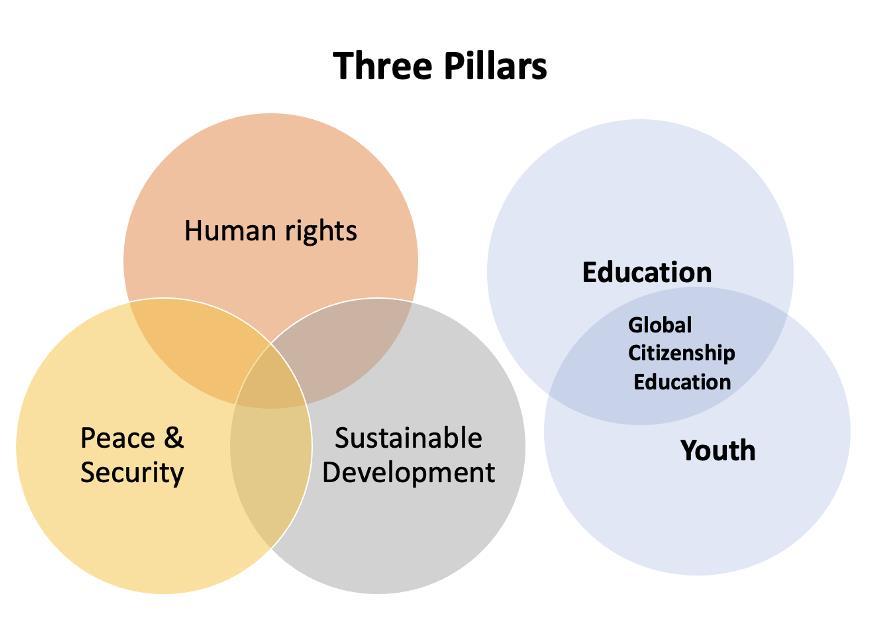
Thus, in the 2000s, the UN started to focus on Youth and Education
This is where the term global citizenship education came in.
Except for the ‘International Court of Justice’, all 5 of them are located in the same place. ‘International Court of Justice is located in the Netherlands, and the rest of the organs are located in New York.
‘Trusteeship Council’s purpose is to help countries decolonize and to stand up on their own, but its actions ended in the year 1994. So it's no longer activated, but it’s still under the charter as the principal organs.
Arabic Chinese English French Russian Spanish
Working languages: English & French
SDG is a Global agreement for sustainable development.
The definition of Sustainable development Development that needs the needs of the present, without compromising the ability of future generations to meet their own needs.
+ When there was a talk about development, times ago, it was mostly about economic and social development. But in the year 1970, the environment issues got vital, so now all three, social, economic, and environmental issues got included.
MDGs: Millennium development goals


8 goals and 21 targets.
Focused on developing countries
Focused area are mainly social development (Regarding health & Education)
SDGs: Sustainable Development goals
17 goals and 169 targets.
Focused on all countries
Also focused on economic, and environment issues
5P: Planet(Environment protection), Prosperity(Economic development), People(Social development), Peace & Partnership(Preconditions & Methods)
People (Social development) is regarding on issues that are related to people, sdg goals 1~6

Prosperity (Economic development) categories the four sdg goals, 8~11
Planet (Environment protection) sdg goals, 7,12,13,14,15
Peace & Partnership (Precondition & methods) sdg goals 16,17
SDGs 4: education
SDG 4 aims to:
“Ensure inclusive and equitable quality education and promote lifelong learning opportunities for all” = education is important in terms of achieving the sustainable development goals, because people need to understand why we are trying to achieve sustainable development goals, and that is to education

+ SDG 4 is not only related to education itself, but it is also interlinked with different SDG goals (SDG target 3 7, 5 6, 8 6, 12 8, 13 3)

Covid 19 one of the problem that affected the development of SDG 4

 Korean Minjok Leadership Academy
Korean Minjok Leadership Academy

Ambassador Enna park’s lecture on world expositions and the plan for 2030 exposition that would hopefully take place in Busan was short, but it was enough to provoke deep interests. The essence of big events involving multiple nations isoftentimes competition and promotion. World expo has been an evident exception, though, for the official spirit of expo consists of progress and peace. In recent days it has functioned as a platform to present visions and solutions for imminent challenges. When new inventions and technologies are introduced, these not only effectively promote the progress of one nation but also strengthen the unity of the global community.
The first world expo the ‘Great Exhibition’ was held in London, 1851. It was housed within the “crystal palace”, which was built in Hyde park. This popular event which attracted about 14,000 people around the world was designed by no other than Prince Albert, Queen Victoria’s husband.
To go deeper into the roots, this was actually inspired by two big exhibitions held in 1844, the French National Exhibition in Paris and the Zollverein Exhibition in Berlin. An Englishman named Francis Wishaw, who was the Secretary of the Society of Arts, established a ‘Grand Annual Exhibition of Manufactures’. Although Wishaw failed to gain attention at his first try, the second Exhibition was a success, attracting more than 800 people. This was eventually reported to Prince Albert, who was well known to have deep interest and knowledge toward international affairs; and the committee for organizing the ‘Great Exhibition’ was swiftly made.
The Great Exhibition became a phenomenon, similar models repeated all around the world. There were some 100,000 objects, displayed along more than 10 miles, by over 15,000 contributors. By the time the Exhibition closed, on 11 October, over six million people had gone through the turnstiles. Instead of the loss initially predicted, the Exhibition made a profit of £186,000, most of which was used to create the South Kensington museums. Prince Albert’s decision to organize an international exhibition turned out to be a wise one. And it became the origin of the World Expo model that continues till today.
How did this international forum of progress and peace evolve? World Expos are now officially called International Registered Exhibitions. It functions as a global gathering of nations dedicated to finding solutions to pressing challenges of our time by offering a journey inside a universal theme through engaging and immersive activities. World Expos welcome tens of millions of visitors, allow countries to build extraordinary pavilions and transform the host city for years to come. World Expos are unrivaled among international events in their size, scale, duration and visitors. They are held once every five years the 2021 World Expo in Dubai was the most recent one.
There are a variety of specific themes including marine life, agriculture, energy, food, and sustainability, but they can all be united under one spirit; progress and peace.
2030 World Expo has a significance, for the year of the exhibition coincides with the year of the aimed year to achieve 17 SDG goals. Russia, South Korea, Italy, Ukraine, and Saudi Arabia have submitted bids to hold the event.


Korea’s theme of 2030 World Expo is “transforming our world, navigating toward a better future”. Korea has previously organized two Specialized Expos. If fortunate, in 2030 Korea will host its first global expo in Busan.
Ambassador Enna Park elaborated on the strengths of South Korea as the hosting country. Busan’s superiority is in its own transformation story. Back in the 1950s, during the Korean War, Busan was an intense battlefield, the final bridgehead tocombat against the invasion of the North. After 70 years, it grew into a city which has the 6th largest container port in the world. This fits with the theme “transforming our world, navigating toward a better future”, suggested by Korea.
Works cited
K.W.
2009 https://www.bl.uk/victorian
of the Royal Society of Arts Vol.99, No.4845 (April, 1951), pp.413
 Daewon International Middle School
Daewon International Middle School

Among the various lessons I have taken during the UN Training week, the most interesting lesson was the presentation about the economic Ukrainian War. The war between Ukraine and Russia has been prolonged and continues to this day. To better understand the war and its impact on the world economy, our team did more research on the resulting economic crisis and damage that Ukraine now suffers.
To begin, the damage to Ukraine has been tremendous as the attacks from Russia destroyed most of Ukraine’s infrastructures. Urban centerswere completely destroyed, andthe crucial economicand social service infrastructures are not in good shape. This economic loss resulted in 108 million dollars, which led nearly 3.5 million Ukrainians to leave their homeland. Luckily, 20 nations are providing aid to Ukraine, and they are slowly recovering.
Another effect of the prolongedwar isthe economic crisis that hasbecome a significant worldwide threat. Russia possessesmost of the oilthe world consumes today. However, due tothe war, oil prices have reached record highs which threaten nations that have relied on importing Russian oil. Also, due to the destruction of the Ukrainian farmlands which provide most of the world’s food production, food crises have occurred in various nations. To be specific, Ukraine is commonly known for its vast wheat fields, but asthewarbrokeout, wheat pricesrosetounprecedented ratescausingeconomicproblemsacross theglobe.
In conclusion, by researching and presenting the damage and economic crisis that resulted from the Russo Ukrainian war, I could understand the current situation thoroughly and think more about the possible solutions that might end this devastating conflict.
“Conflict in Ukraine’s Donbas: A Visual Explainer” Visual Explainer https://www.crisisgroup.org/content/conflict ukraines donbas visual explainer
“The Orange Revolution and Yushchenko presidency” Britannica https://www.britannica.com/place/Ukraine/The crisis in Crimea and eastern Ukraine
“Ukraineat war”TheEconomist https://www.economist.com/ukraine crisis
“Ukraine War: What is The Economic Impact of Trade Sanctions on Russia?” SciencesPo, April 25, 2022 https://www.sciencespo.fr/en/news/ukraine war what is the economic impact of trade sanctions on russia

 Daewon Foreign Language High School
Daewon Foreign Language High School
Today, the acceleration of industrial development and urbanization has given mankind abundance and prosperity, but at the same time, it has also brought problems such as environmental pollution, resource depletion, disease, poverty, and polarization. In particular, the development of numerous carbon compounds has been causing severe climate change. Climate change not only directly fuels natural disasters, but it also has adverse effects on social stability as well. Among these issues is the matter of climate migration, a typeof migration duetonatural disasters caused by climatechange. Currently, climate migrants are not legally recognized as refugees, but in the present situation where the environment spans diverse social problems, it is necessary to address this issue and consider expanding the range of refugees.
Climate change is defined as a long term change in the average global temperature due to natural cycles or human activities. It is mainly driven by industrial practices such as burning fossil fuels for power generation and manufacturing processes, deforestation for agriculture, and combustion of petroleum based products for transportation. This results in environmental degradation such as global surface temperature increase, sea level rise, extreme weather events, and biodiversity loss, which then leads to social problems such as food crisis, poverty, agricultural damage, and displacement. Governments are working to comply with the Paris Climate Agreement’s goal to keep global warming at 1.5C, and fulfill the carbon reduction plans for 2030 set at COP26 in Glasgow. While these efforts are well targeted towards the removal root causes of climate change, we lack resolutions in response to the aftereffects on human societies, which must be addressed based on the SDGs’ genuine value of recognizing the deep interconnection between society and environment.
Whereas a majority of developing countries scarcely contributed to climate change, they are the most vulnerable targets of itsdisasters. There are four main reasons behindthis: dependence on agriculture, low lying coastal areas, less technological and financial means, and high population growth.
First of all, in developing countries, agriculture accounts for the majority of incomes and employment. However, water scarcity and intense droughts are causing massive crop failure, amplifying pressure on the economy of weak governments. Second, many developing countries such as Guyana, Bangladesh, and Indonesia have large populations living in low lying coastal areas where rising sea levels and floods can victimize several residents as well as destructing the urban infrastructure. Third, many developing countries lack the ability to stand on their own feet, as a majority of them are reliant on knowledge and technology transfer from developed countries. Consequently, in the event of sudden disasters, it is likely that developing countries lack the capacity to cope with them on their own. Fourth, developing countries

are experiencing rapid population growth, which makes it difficult to empower individuals and the society as a whole. The degree of assistance available may be limited compared to the continuously increasing demand from the enlarging population. Furthermore, another concern regarding climate change vulnerability is “climate apartheid”, a phenomenon in which wealthy nations pay to avoid and evacuate from climate induced poverty, hunger, and displacement, whereas poorer countries are left to suffer. Environmental problems are cross nationally shared issues that requires global cooperation, but if climate apartheid occurs and all of the responsibilities and consequences are passed on to only certain weak countries, it would be an unpredictable immense burden for those developing countries.
Migration is defined as the movement of people within or across borders according to the conditions of their surroundings. In particular, climate migration, a subclass of environmental migration, refers to movement from an area that has been destructed by disasters such as floods, wildfires, and hurricanes due to climate impacts.

South Asia is currently a vulnerable target of climate change, with an estimate of over 60 million people forced to leave their homes by 2050. Suchmovement isdriven by climate hazards such as rising sea levels, floods, storms, draughts, and extreme temperatures targeting various countries including Indonesia, Nepal, Bangladesh, and Sri Lanka.

In Indonesia, its capital city Jakarta has sunk approximately 157 inches since 1970, by an average of 3.9 inches and up to 15 inches annually. Home to 32 million people, some predict that it is no longer habitable and 95% of the city will be completely gone by 2050, and accordingly, the government is planning to relocate the capital to Nusantara. Considering that 65% of the Indonesian population is living on Java, there may be an unprecedented massive efflux of climate migrants from Jakarta moving to the new capital or disproportionally distributing across the country.
Another case is Nepal, where over 400,000 people have been displaced between 2008 2014 due to water scarcity, crop failure and habitat destructions. This has caused a massive seasonal labor migration across borders, possiblymeaningamassivehumancapital flight forNepal whichmayleadtoadecreaseinincome growth rate and loss of public revenue. As for the host countries, there may be an increase in labor competition and lack of infrastructure that may disturb social stability.

Considering the basis concept of the SDGs the interconnection of society, economy, and environment I believe that climate change should no longer be treated as a only an environmental problem, but its impacts on human societies also needs to be examined in detail. Especially since climate hazards are destroying human habitats, the most fundamental factor of human lives, which is displacing millionsofpeople, thismatter ofclimatemigrationisacritical issuethat calls forinternational cooperation. To solveclimatemigration, Ithinkthatwe shoulddevelop twotypesof actionplans: one to prevent climate disasters through technology, and the other to ensure legal protection of climate migrants.

The most fundamental solution is to prevent the climate hazards in the first place, and to do so it is inevitable to rely on technology. An effective way is to expand the usage of forecast models in vulnerable areas. Though this may seem as an obvious solution, it still hasn’t been implemented in quite a number of countries. The climate forecasting models can immediately demonstrate the constantly changing weather situation, which can indicate specific areas in need of the government to intensively develop and protect. In addition, rather than developed countries simply giving this technology to developing countries, it will be more beneficial if the local people of developing countries can actually gain the ability to utilize and further develop the models on their own. In this way, this will be a useful measure in that it not only allows efficient response to climate hazards, but can also help developing countries stand on their own feet.
In response to already displaced populations, it is crucial to legally recognize those climate migrants as refugees. Though the awareness of climate refugees is increasing, they are not considered as official refugees and thus do not receive the same protection as do refugees from other causes. However, as stated in the Stockholm Declaration that “man has the fundamental right to freedom… and adequate conditions of life, inan environment that permits alife of well being…”, allhumanbeingshave theright toenjoy the elements of a stable life. Since the environment is a very important factor in human life, people who live unstable lives due to the environment certainly need to be legally protected. Though it is not a physical war, climate change victims are also fighting against disastrous climate hazards and have lost a lot during the process. Climate migrants should also be recognized as formal refugees, and the international community should support each other to strengthen infrastructure for climate migrant reception in host countries, establishing an international system for environmental refugees to settle safely.
BBC News. “What Is Climate Change? A Really Simple Guide.” BBC News, 13 Oct. 2021, www.bbc.com/news/science environment 24021772.
Carrington, Damian. “‘Climate Apartheid’: UN Expert Says Human Rights May Not Survive.” The Guardian, 25 June 2019, www.theguardian.com/environment/2019/jun/25/climate apartheid united nations expert says human rights may not survive crisis
“
Climate Migration in South Asia Set to Treble by 2050 Due to Political Inaction on Global Warming.” ActionAidInternational, 18 Dec. 2020, actionaid.org/news/2020/climate migration south asia set treble 2050 due political inaction global warming. Greenfield, Nicole. “Climate Migration and Equity.” NRDC, 9 May 2022, www.nrdc.org/stories/climate migration equity
Poole, Kenzie. “Climate Migrants: Who Are They and What Legal Protections Do They Have | Immigration and Human Rights Law Review.” Immigration andHumanRightsLawReview|TheBlog,28 Oct. 2021, lawblogs.uc.edu/ihrlr/2021/10/28/climate migrants who are they and what legal protections do they have.
Sultan, Benjamin, et al. “Evidence of Crop Production Losses in West Africa Due to Historical Global Warming in Two Crop Models.” Nature, 6 Sept. 2019, www.nature.com/articles/s41598 019 49167 0.
United Nations. “Causes and Effects of Climate Change.” UnitedNations, www.un.org/en/climatechange/science/causes effects climate change. Accessed 19 Aug. 2022.
Ware,Gemma,andDanielMerino. “ATaleofTwoCities:WhyIndonesiaIs PlanningaNew Capitalon Borneo and Abandoning Jakarta. Podcast.” The Conversation, 14 Apr. 2022, theconversation.com/a tale of two cities why indonesia is planning a new capital on borneo and abandoning jakarta podcast 181134.



As someone who plans to major in International Relations in college and get involved in International Affairs for a future career, Jasmine’s lecture was one that I couldn’t miss.
She started the lecture off bylisting three skillsthat anyone that wants to be involved in international affairs needs to have: language skills, communication skills, and the ability to work with people from different backgrounds. She then depth advice about how she developed her skills and paved a way for her career. She built specialized skills by first identifying what area she wanted to specialize in and then figuring out whatskills and training she needed. She noted that we shouldn’t be afraid of paving our own path and of rejections. In order to join such a competitive field, we need to create opportunities where none exist and not take rejections personally. She explained that the main way to create opportunities was through networking. I realized that I need to start networking as soon as I can with people I already know in the field, with peers, and with other mentors, so I can get involved as soon as possible.
Seeing that Jasmine has been able to pave her way into many opportunities, from graduating from Vanderbilt and workingas apart oftheUN, tonowattending Harvard LawSchool, her advice is something that I will take to heart and will draw inspiration from her life.
I knew this would be an eye opening lecture from the start. Introducing himself, Dr. Kadir Jun Ayhan described the in depth knowledge he had with his credentials: an assistant professor at a graduate school of International Studies, member of the National Unity Committee, and Editor in Chief at the Journal of Public Diplomacy.
During his lecture on public diplomacy, he asked a simple but captivating question: why do public diplomacy? As I pondered about why all nations should try and be diplomatic, he revealed his list of reasons. First, he stated that public diplomacy is important as businesses can go international and reap higher economic benefits, oftentermed “globalization.”If every nation hadbeen hostile against each other, the potential of their economies would be limited as there would be fewer opportunities to grow. On this note, I realized that it wouldn’t be just businesses that are limited. Due to the interconnectedness of trade between countries, ifwe stoppedalltrade, it would spelldisaster forthe whole world asthere isnot a single country that specializes in everything. The second reason he said diplomacy was important was due to technological advancements. Since large countries like the US, China, and Russia are leaders in technological innovation, many other nations would fall behind if their technology wasn’t spread throughout the rest of the world.
He also explained that public diplomacy can protect democracies and allow for liberalization to boost the public to speak out about their opinion on their political issues, something that is very important to grow as a democracy. This is because empowered individuals are the future of world politics, so the more they are able to think critically and speak out rather than be restricted, the more the world can come up with ways to constantly improve as a world.
Because Yale is my dream school, I was particularly excited to listen to Shawn Thacker’s lecture on his life at Yale and the opportunities he has been given. He first started the lecture by describing his student life at Yale as a senior and the internships he participates in. Then, he further explained the ins and outs of Yale University.
I learned that Yale is a very open community that supports your aspirations. There are 14 residential colleges and cultural houses that allow for plenty of social interaction between the students. In addition, to help expand your writing skills, there are writing tutors available to any student. If you’re trying to find a book to be captivated by for the next week, Yale offers a personal librarian that will give you suggestions on which books to read as well. In the first two weeks of classes, yale has a shopping period where students can freely move between classes and professors to choose the educational opportunity that best fits them. If that wasn’t enough customizing for each student, Yale offered fully paid fellowship opportunities for students to study abroad if they wished.
Specifically, Shawn took advantage of Yale’s Global affairs program and studied internationally to experience college in a new light. He explained that this global affairs program was what drew him to attending Yale in the first place.

To conclude the lecture, he gave his advice on how to maximize students’ chances of getting into Yale, explaining that GPA and essays are the most important. His lecture has not only drawn me more to want to attend Yale but has also inspired me to get a head start on my college application essays as well.


Felipe Queipo Rego, a Communications Officer at the UN Civil Society Unit, presented on the topic of SDG 16; Peace, Justice, and Key Institutions. Part of his job is to lead and manage the outreach, communications and engagement efforts of the UN withCivil Society Organizations. During the presentation, he highlighted the importance of his job byconnectingittomoderndaysituations. ThecurrentRussia Ukrainewarwasakeyexamplethatshowed that one country being impacted shook the integrity of global peace. Another was international organizations such as the European Union, Red Cross, the Organization of Eastern Caribbean States, and so forth, which were all international organizations that connected countries of similar nature or geographical positions. The main objective of the lecture was to focus on the Agenda for 2030 to leave no one behind.
Amongthemanykeyexamplesduringhislecture, oneofthem wastheexampleofwhat thecurrent Spanish government was doing ona federal and local level. This made me wonder about how governments on different levels and scales worked with each other.
First, in the example of the US, there are Local governments, State governments, and the Federal government. The federal government, as most people know, is in 3 branches; the Executive branch, the Legislative branch, and the Judicial branch, each of which work to keep each other’s power in balance. In fact, the state governments mirror the structure of the federal government. The only different format is for local governments, which are more free in which areas or regions they cover. For instance, they can be based on cities, counties, towns, or more.
Thefederalgovernmentaffectedmoreofthegeneral framework. Inthemost recent SupremeCourt decision, they overruled the Roe vs. Wade case, which now allowed for state governments to decide individually if they would allow or disallow abortion. These types of general decisions are the ones the federal government makes. Certain things such as federal mandates exist as well, which are mandatory orders from the federal government to state and local governments. It’s in charge of currency, foreign affairs, welfare programs, infrastructure building, large state projects, and more.
The state government has mainly 3 important functions. 1, carrying out federal orders. 2, court rulings. And 3, managing institutions such as school curriculums and welfare programs. All of these function around the basics set by the constitution and the federal government, yet they still have a lot of leeway and power as to how to adjust the specifics. For instance, in some states, marijuana, a recreational drug, is legal to use, while it is strongly banned in other states.
The local government is used mainly for the implementation of specific laws, regulation of public spaces, and more accurate representation of citizens’ wants and needs. Most countries don’t have a direct democracy, but rather a representative one. So these elected mayors and representatives of cities/counties would be in charge of election vote managing, as well as maintaining libraries, parks, police stations, schools, hospitals, and more accessible to the public.
Some of the ways the 3 levels work together are in part of solving global problems. The federal government would outline possible solutions and ways to solve problems, then the state and local governments would tailor and set physical policies that are specific and reasonable for their region.

Another point he mentioned was bringing change in your daily life. So I tried connecting that with one of our most prominent problems in society: climate change. And surprisingly, one very large and important issue was fashion.
ZARA, H&M, UNIQLO, and GAP are all examples of global fast fashion brands that are unfortunately very popular. I thinkit’s importantthat we keep it to a limit. Between 2000 to 2015, clothing sales have doubled, yet clothing utilization went down by 36% between 2003 and 2018. It has come to a point where for instance one third of young women in the UK think an item of clothing is “old” after they’ve worn it once or twice. The obvious effect of this is more pollution. Fast fashion ranks for 10% of the Earth’s total CO2 twice the amount of planes and shipping combined. And by 2050, the fashion industry could be responsible for 26% of the world’s total carbon emission. But fast fashion doesn’t only affect carbon. It generates significant amounts of pollution and waste in general. In fact, textile dyeing makes up 20% of global wastewater. And the microfibres that are released into the water when clothes are cleaned create more pollution as well. How does this relate to carbon? Wastewater treatment plants make up 3% of all carbon pollution. Meaning, the more wastewater fashion creates, the more carbon that needs to be used to clean it up.
Then what happenstotheclothesthat are thrownaway? They end upbeingmore carbon. 92 billion kilograms of clothes are thrown away each year. And while most of this is intentional, some is not. What most people believe to be “donating” is actually exactly the same as throwing clothes away. Only 5% of donated clothes from Korea are actually donated. And in the US, 10 to 20% of donated clothing will be sold somewhere in the US and another 10 to 20% might be down cycled into rags or insulation. The remaining 60 to 80%? They end up in landfills of developing countries in the Southern Hemisphere. In fact in Ghana, the piles of clothes that are imported in are called “dead white man’s clothes.” When these clothes continue to pile up, they start to decompose as well. The gas that is exposed to air as a result of decomposition is half methane and half carbon dioxide, both highly harmful greenhouse gasses.
To find the root cause to these issues, we have to look at where these clothes come from. The manufacturing, distribution, and disposal of these clothes are mainly controlled by companies. And the only way we can hold them accountable is if we know what’s happening inside. The 2022 Fashion Transparency Index shows that out of the 250 top brands in the world, none of them have a transparency level of above 78%. And 89% of those brands had a transparency score under 50%. Fast fashion brands generally have a lower score, but ironically, so do the largest luxury brands. Chanel ranks 15%, Hermes 31%, and LouisVuitton 29%. The fact that the companies that earn the most money staythe most secretive is highly concerning.


And it’s our role as consumers to demand transparency and clearer policies in how they plan to stay sustainable.

https://www.lwv rva.org/levels of government how federal state and local government work together/ https://online.norwich.edu/academic programs/resources/intergovernmental relationships how three levels government work https://earth.org/fast fashion statistics/#:~:text=Clothing%20production%20has%20doubled%20%E2%80%93%20Garment,worn%20decreased%20by%203 6%25%20overall
https://fashiondiscounts.uk/fast fashion statistics/ https://www.scientificamerican.com/article/sewage plants overlooked source of co2/ https://www.youtube.com/watch?v=gw5PdqOiodU
https://www.consciouslifeandstyle.com/what happens to donated clothes/ https://issuu.com/fashionrevolution/docs/fr_fashiontransparencyindex2017?e=25766662/47726047
Status NGO Representative at the United Nations Department of Global Communications (UNDGC) Program

Youth Education Programs and Sponsor Programs supporting the United Nations and its works, Global Citizenship Education Development, and Sustainable Development Goals (SDGS) in both domestic and international level
Website www.hopetofuture.org
Email webmaster@hopetofuture.org
Contact +82 2 6952 1616
Hope to the Future Association (HFA) is a non profit organization registered under the Ministry of Foreign Affairs of the Republic ofKorea. HFA has acquired the status ofan associated NGOwithUNDPI in June 2014. HFA is deeply committed to supporting youth around the world. Our core value is sustainable support, voluntary participation, international partnerships, and empowering youth.
(1) UN Headquarters Training Program in New York and Geneva
Youth UN Training held at the UN Headquarters in Geneva and New York
Attending Lectures by UN High Officials and International Organization Experts such as the Secretary General of UNEP and the President of General Assembly
Build Professional Knowledge on the SDGs and Global Issues that the UN mainly deals with

Discussion with the UN Ambassador of the Republic of Korea
(2) International Model United Nations ’Yale MUN & Yale MUN Korea’
On February 2018, Hope to the Future Association and the Yale MUN Secretariat signed an official MoU and agreed to a collaborative partnership on organizing YMUN Korea
Participating in International MUN Competitions as Korean Delegation
Attending MUN Training by UN Ambassadors and experts from International Organizations
(3) Global Youth Forum on the United Nations ‘Academic Forum on the United Nations’
The forum is a pedagogical four day program that aimsto improve the degree of understanding and professional knowledge on the UN and the role of International Organization.
The theme of the forum is ‘Sustainable Development Goals and Peace’
(4) Donation Campaign for Children in Africa - ‘Container of Hope’
Sending 40ft long container to African developing countries filled with translated English books, shoes, school supplies gathered from donation campaigns raised by students

Under the principles of “Freedom, Peace and Humanity’, ‘International Mutual Understanding’, and the ‘Future Shape of the AsiaPacific Region’, APUwas established onApril 1, 2000 with the aid of Oita Prefectur, Beppu City and a range of organization and individuals from Japan and overseas.
APU’s philosophy is to create a university campus that produces graduates with the skills they need to contribute to international society based on the fundamental principles of Freedom, Peace and Humanity, International Mutual Understanding, and the Future Shape of the Asia Pacific Region. With almost half of the faculty and student body comprised of foreign nationals from all over the world, the University has achieved a truly international campus environment of cultural coexistence.
APU has been one of the biggest sponsors of Hope to the Future Association since 2013.
Hope to the Future Association has acquired the status of an ‘Associated NGO withthe United Nations Departmentof Global Communication’.

https://visit.un.org/
With kind cooperation and support of the DGC Group Programmes Unit, HFA is able to organize a diversified and a high quality UN Training curriculum the Korean Youth every year. The Visitor Centre provides UN Expert briefings and guided tours to the visitors from around the world.

ⓒ HOPE TO THE FUTURE ASSOCIATION 2022. All Rights Reserved.

All images included in this report are copyrighted to Hope to the Future Association, except for particular images noted with references on the pages. Materials can be freely used for informational purposes only. Produced by the Education Department
Production Director: Jin Hoan Choung, President and Head Director Production Manager: Hyeonkyung Ha, Program Manager
Date
Dana Bldg,
